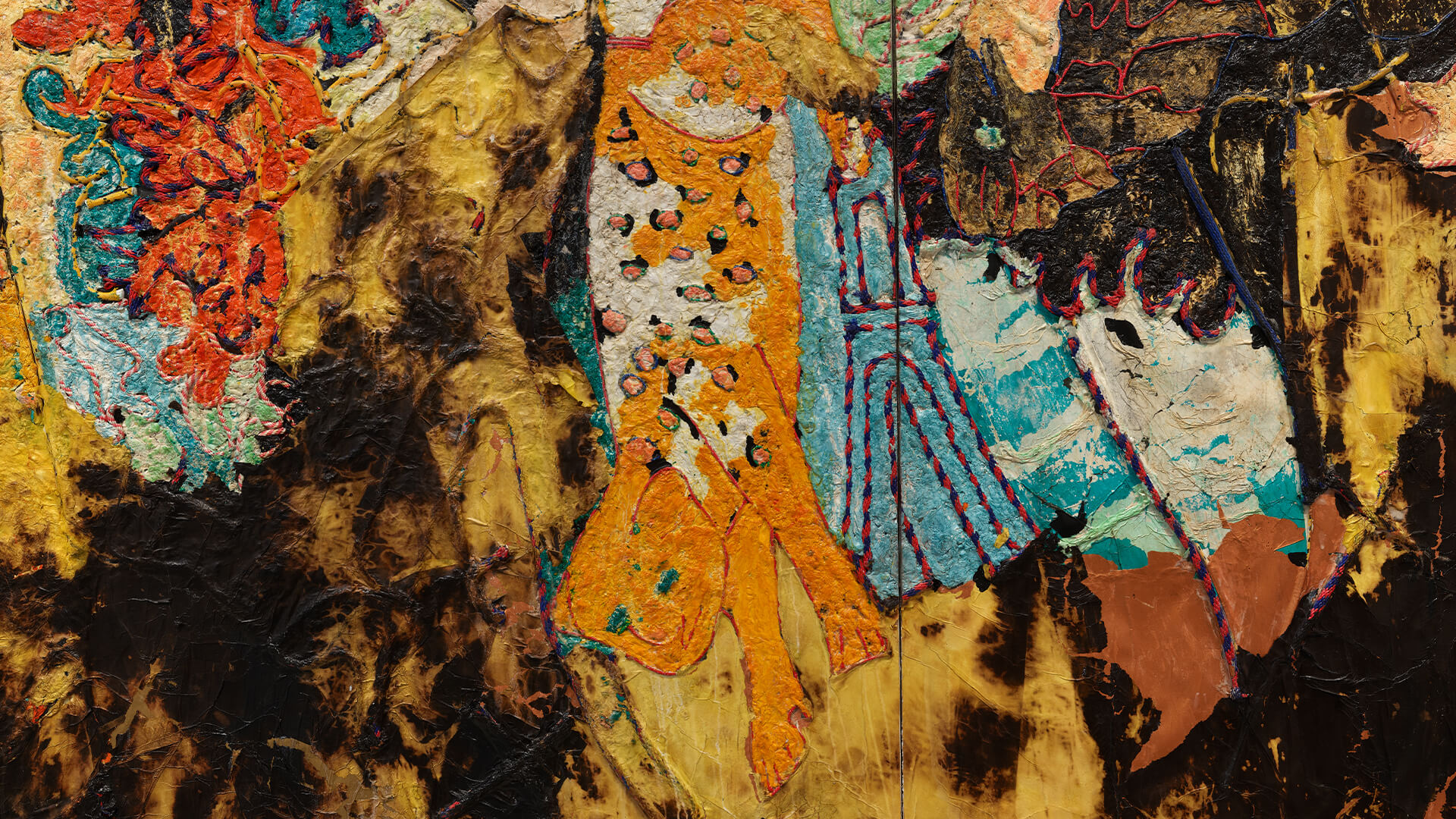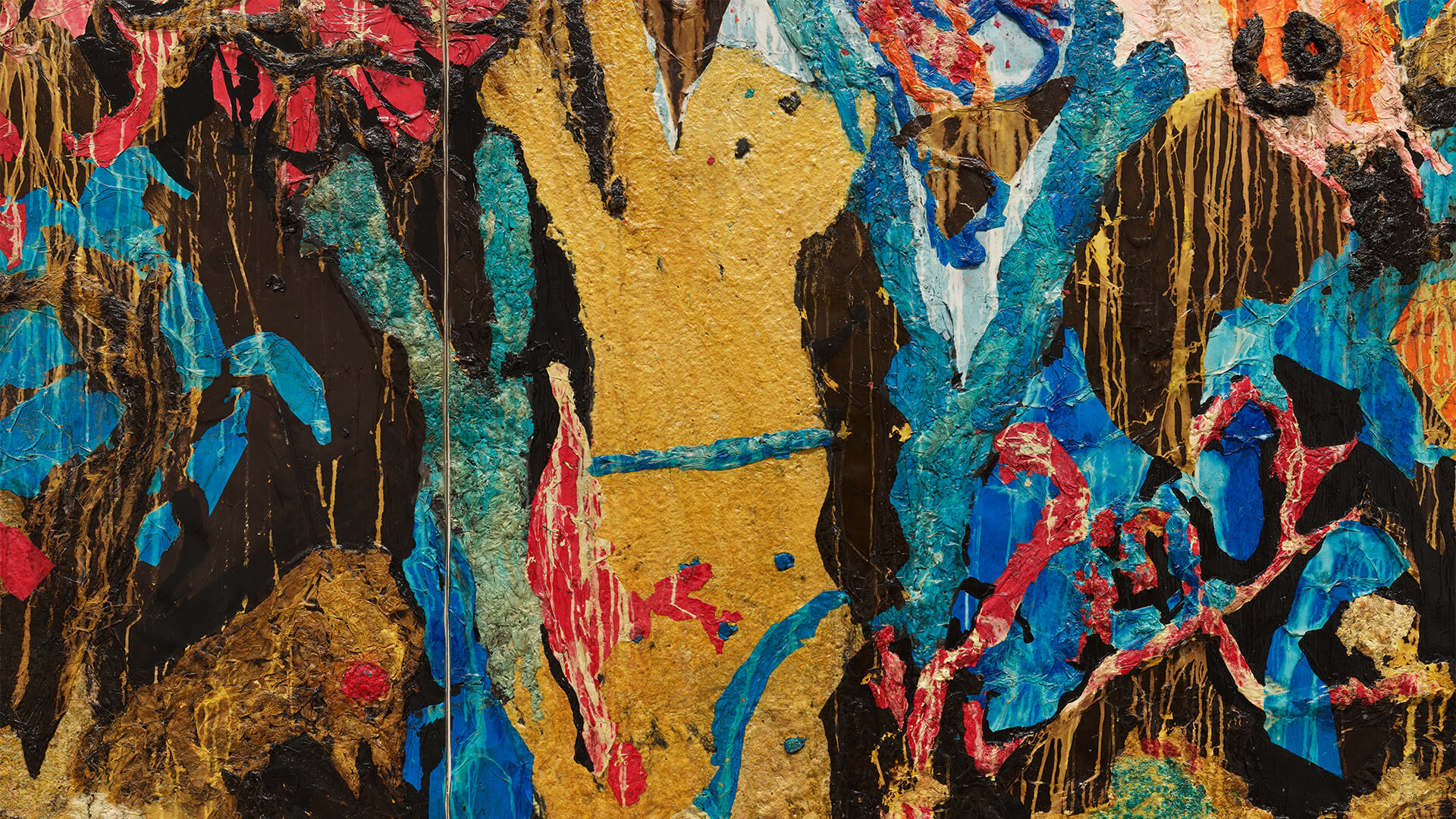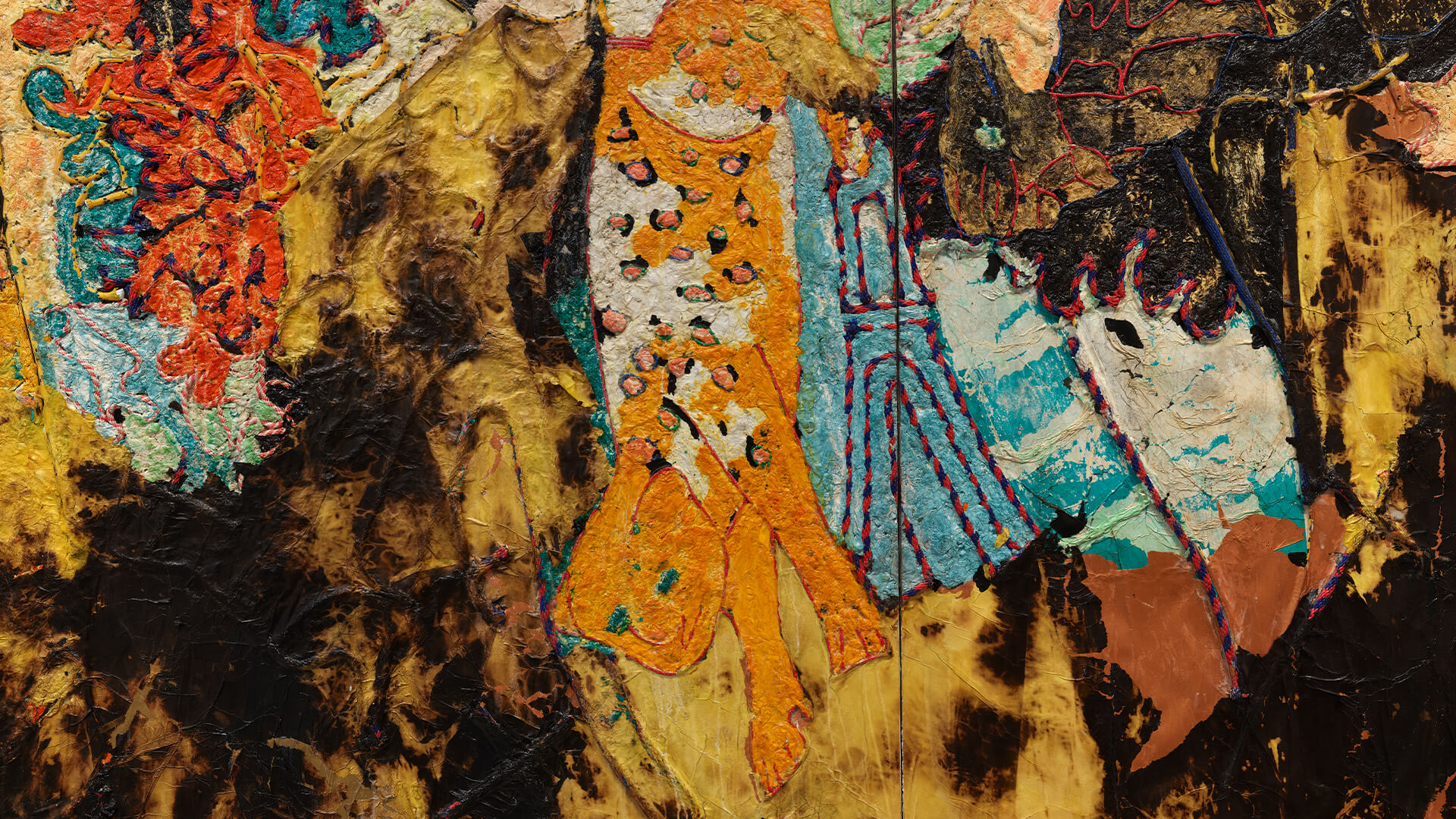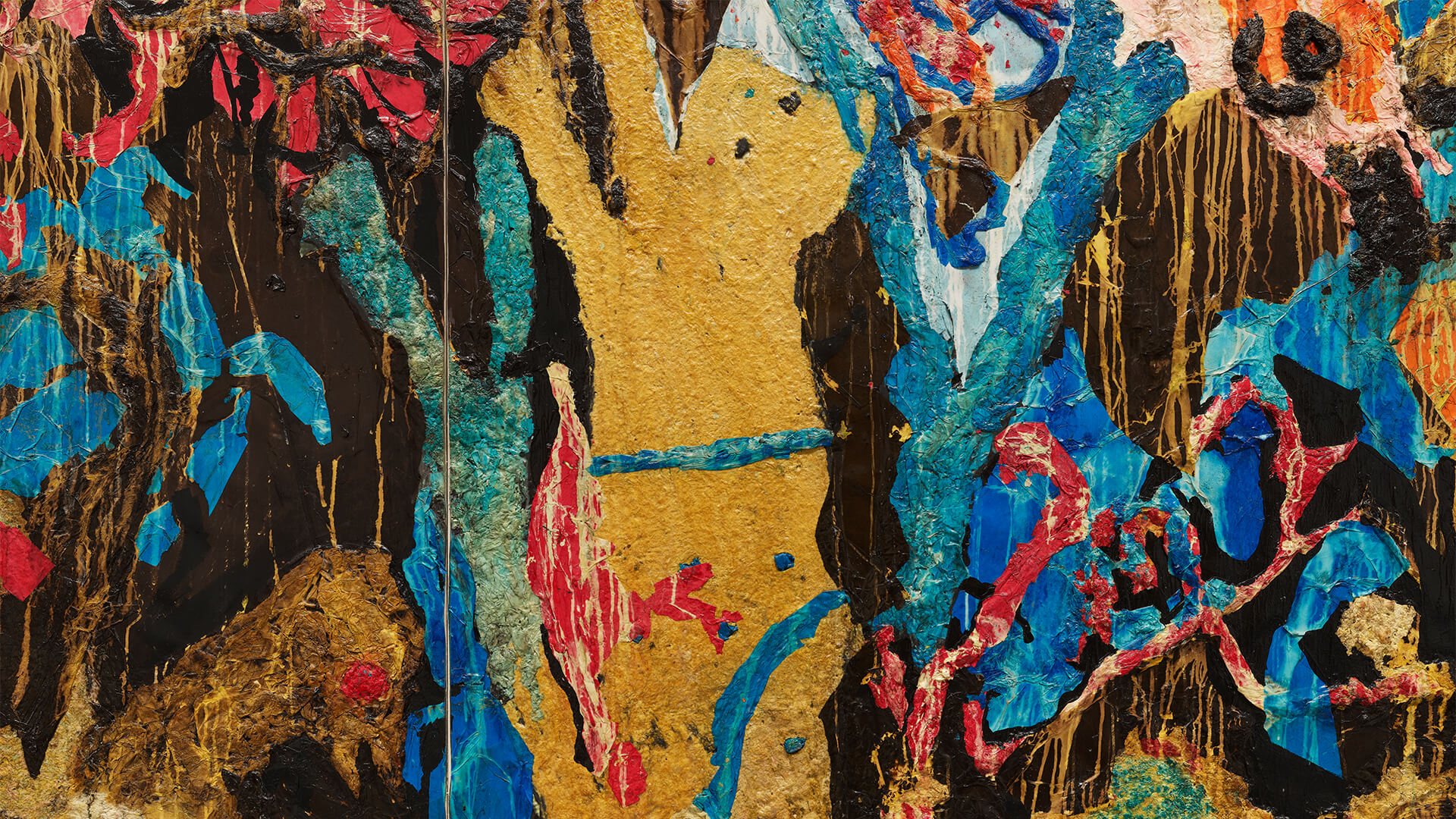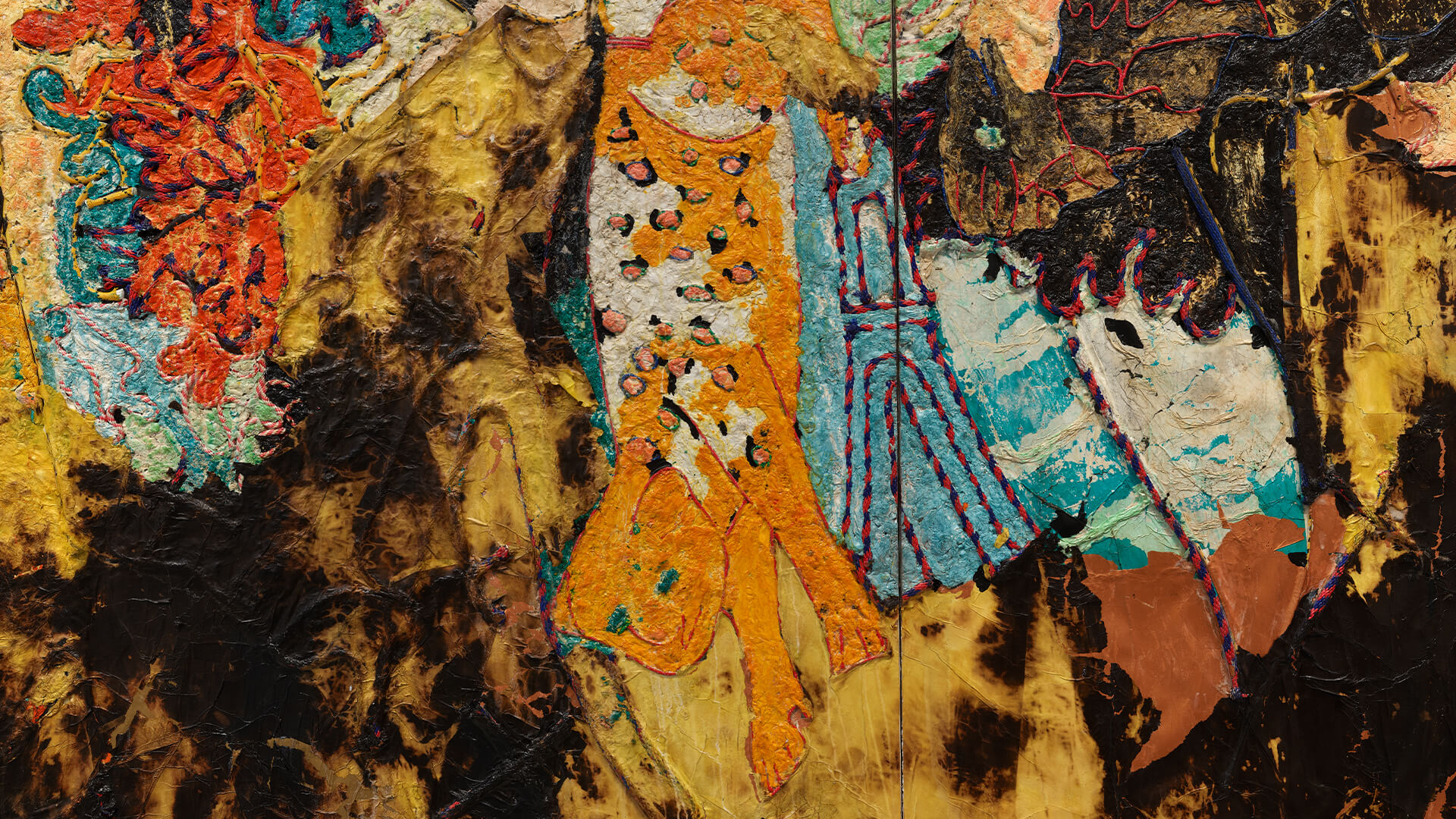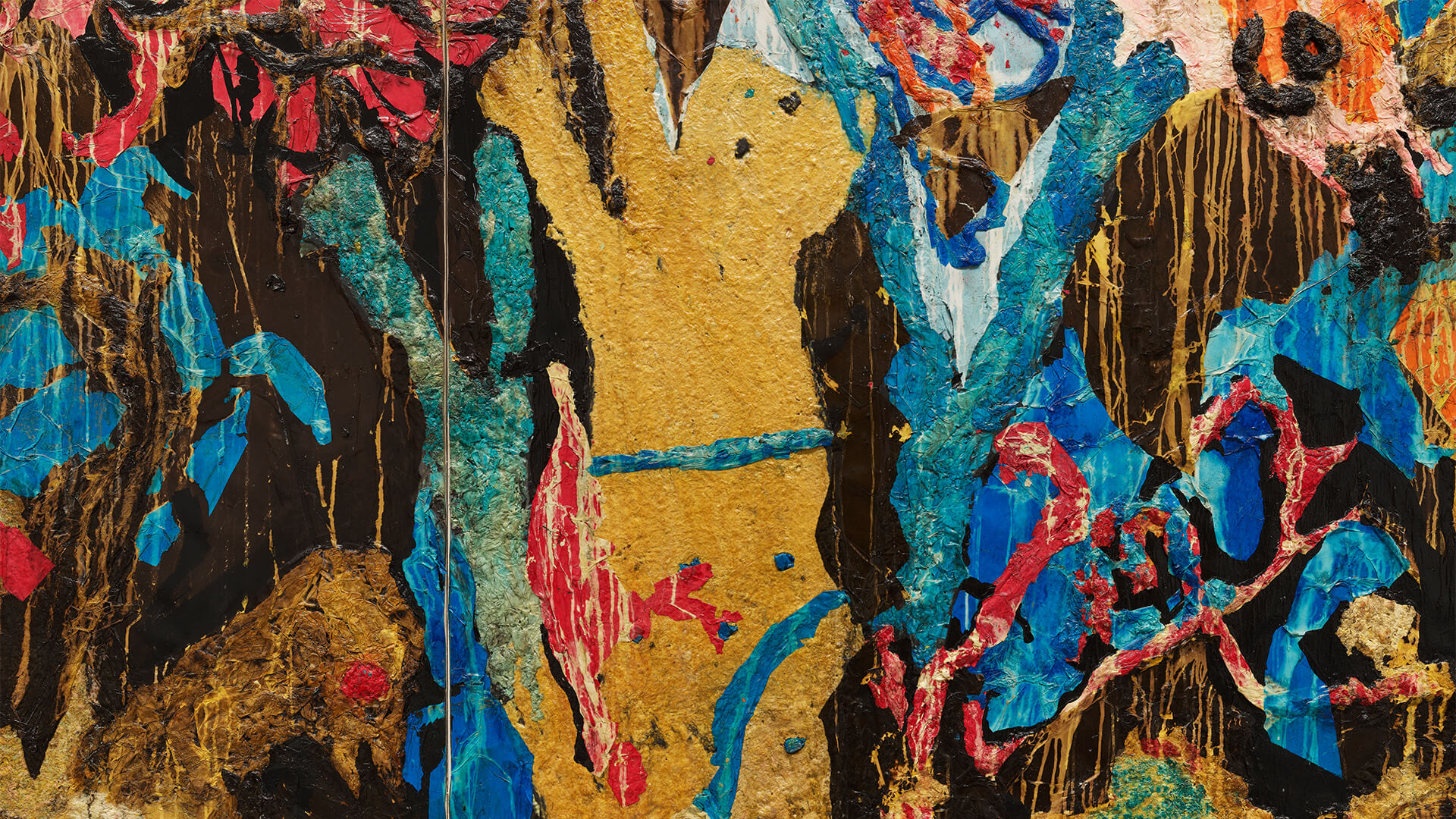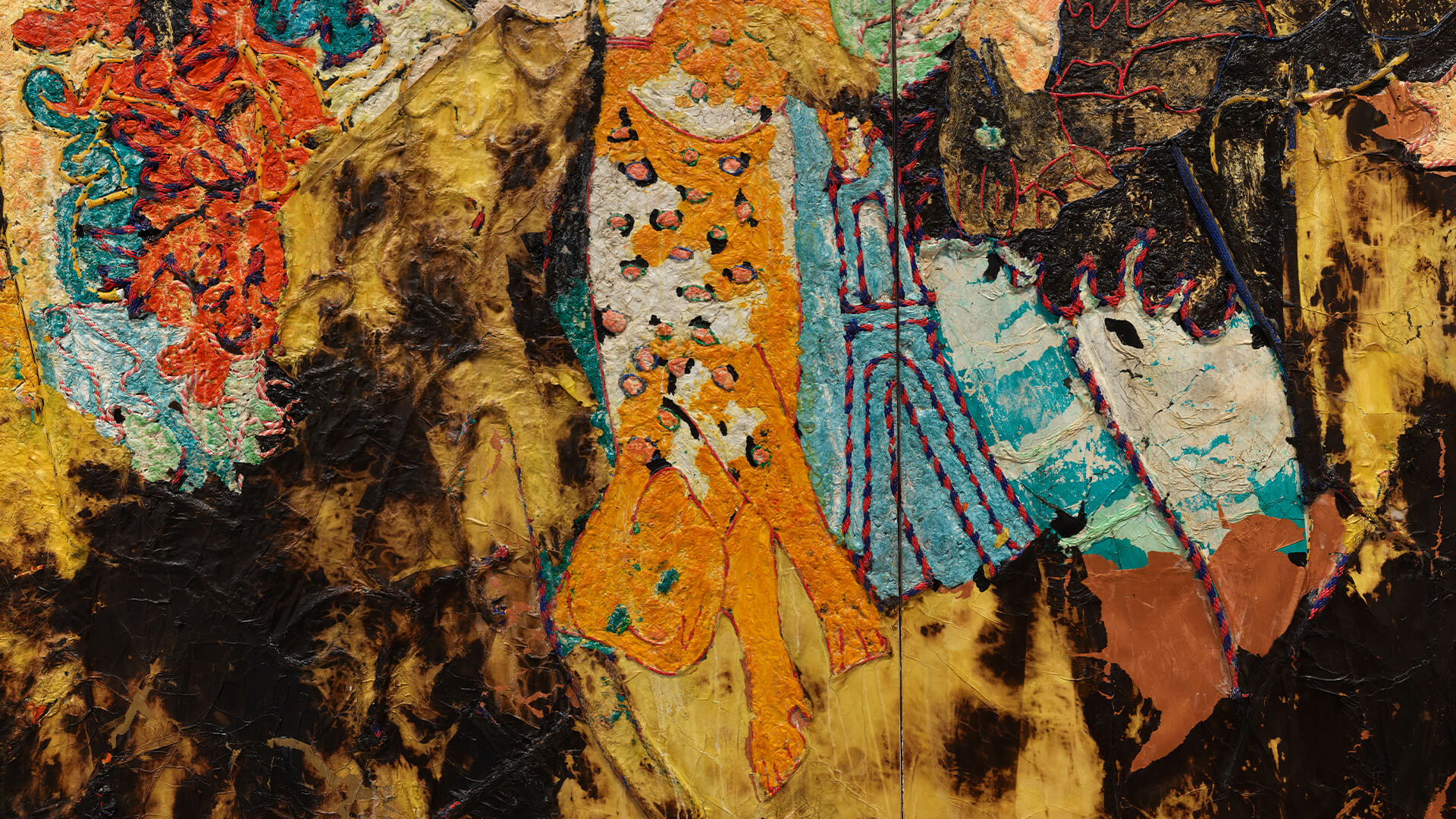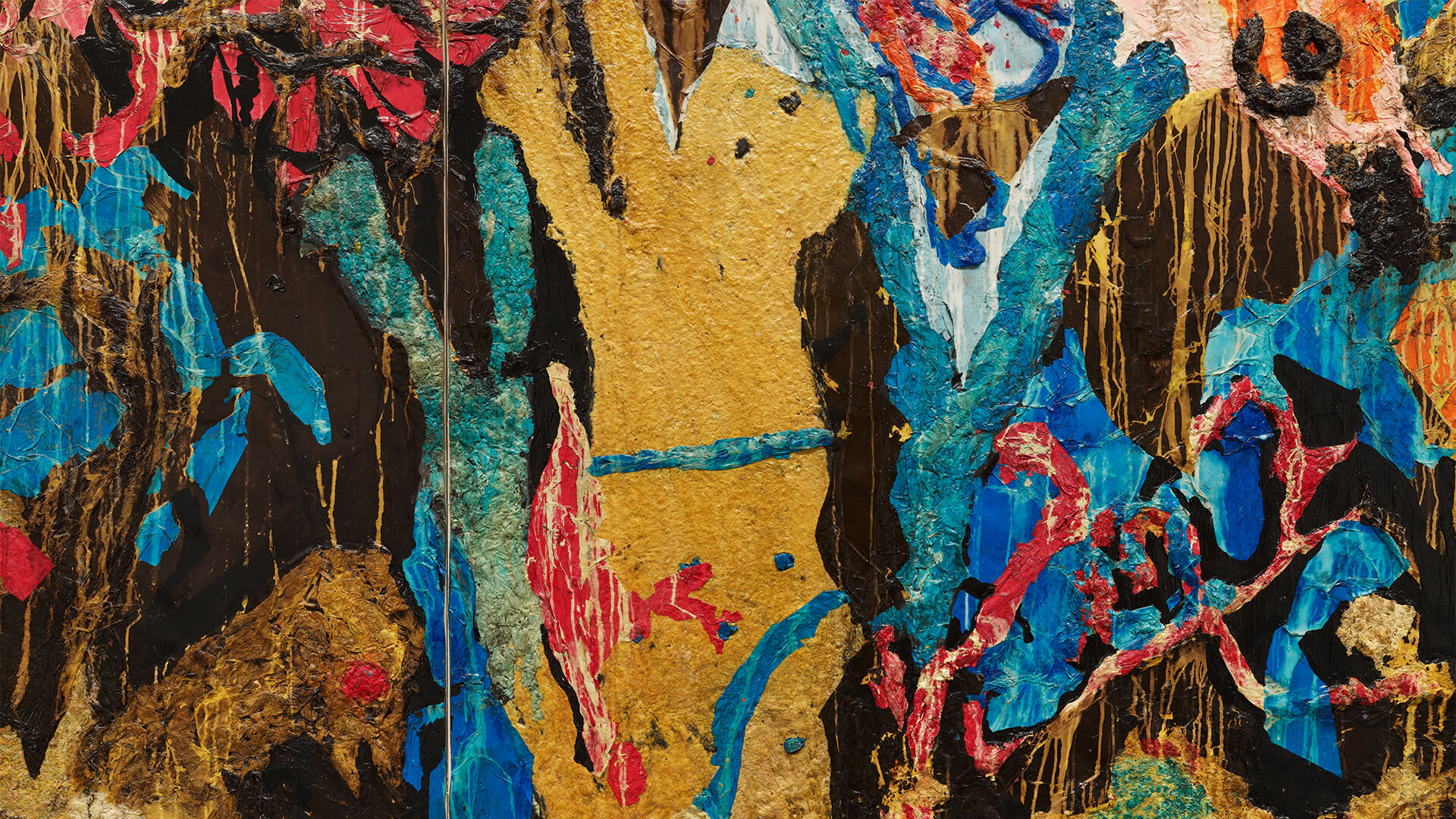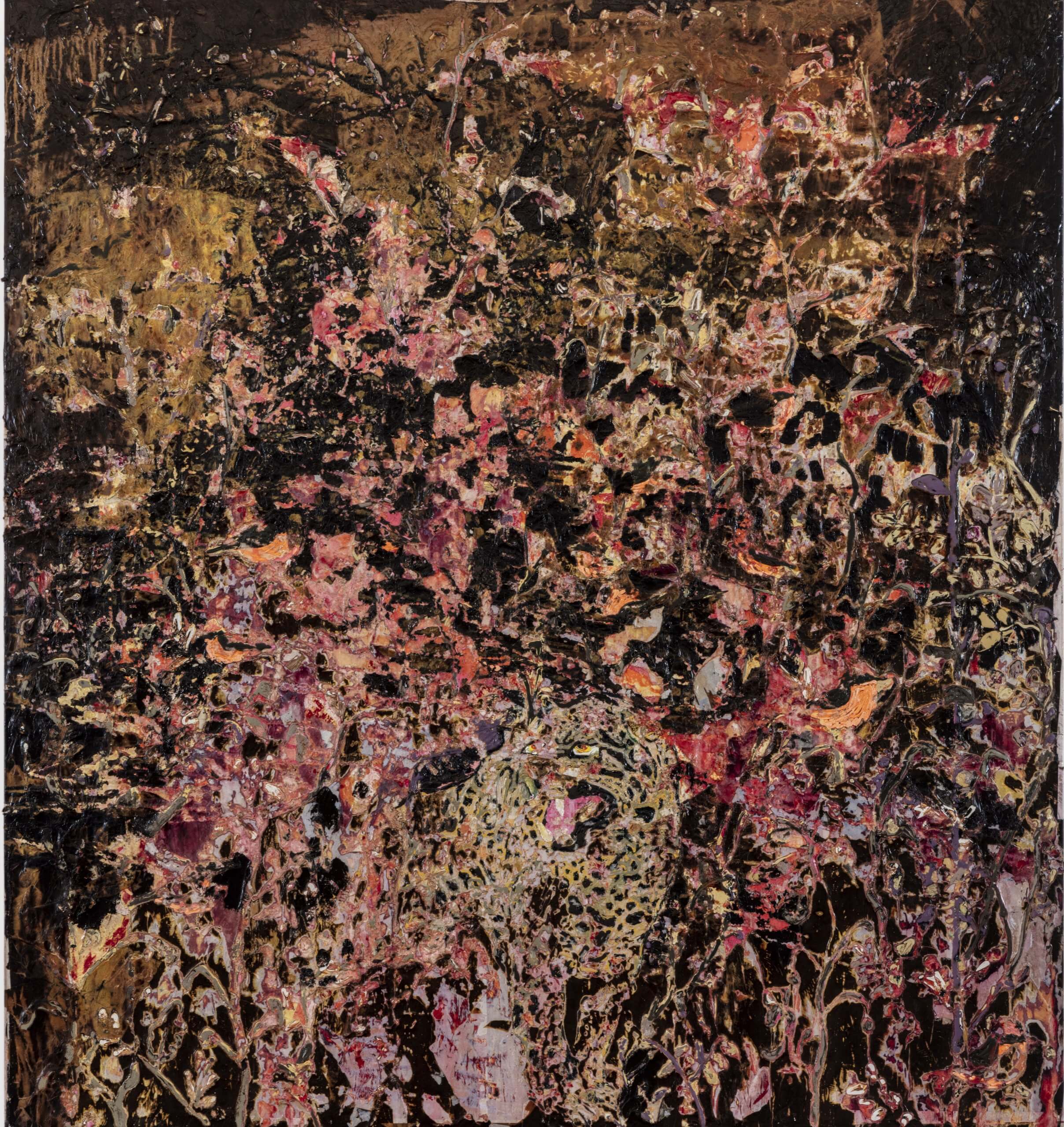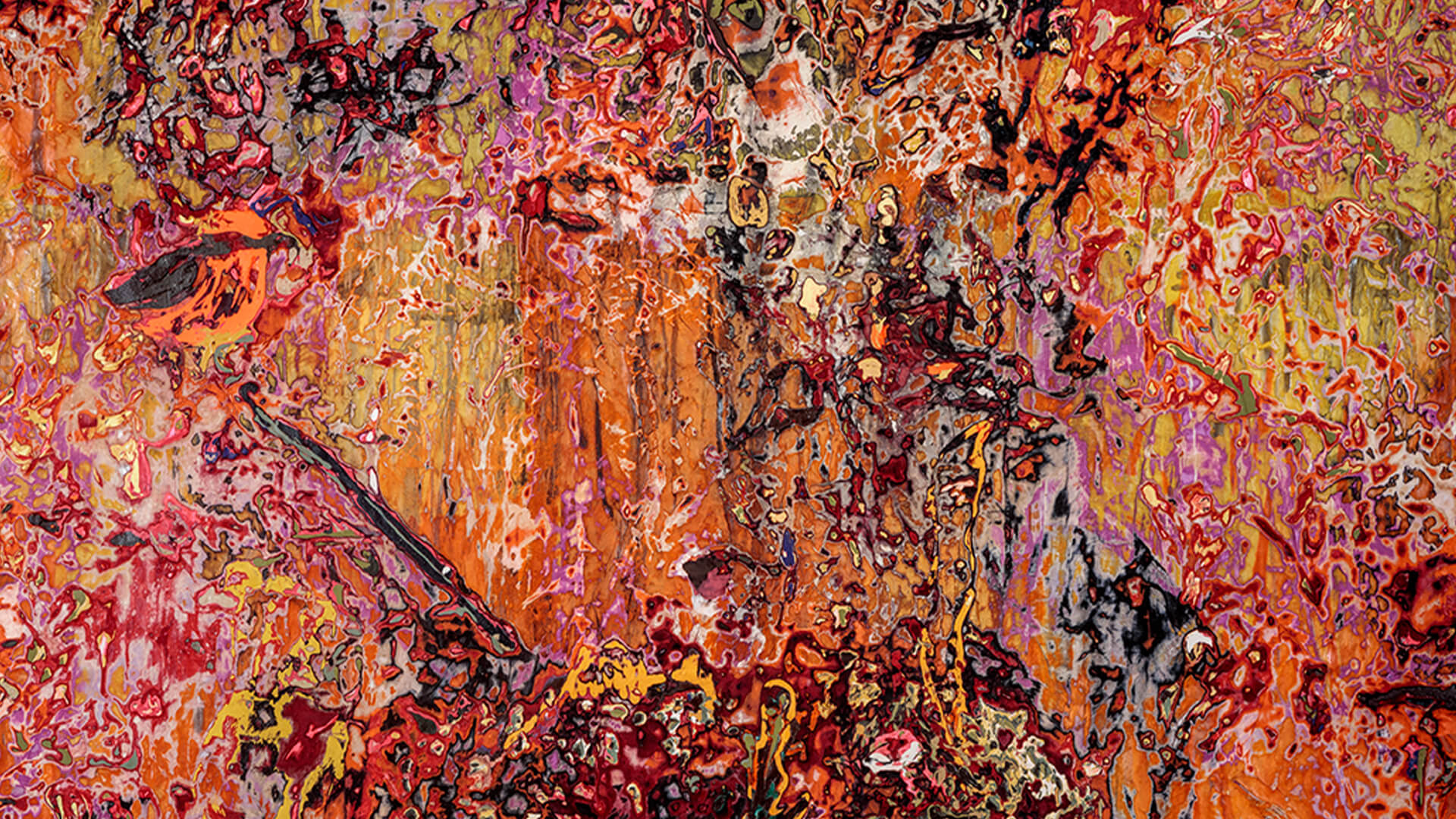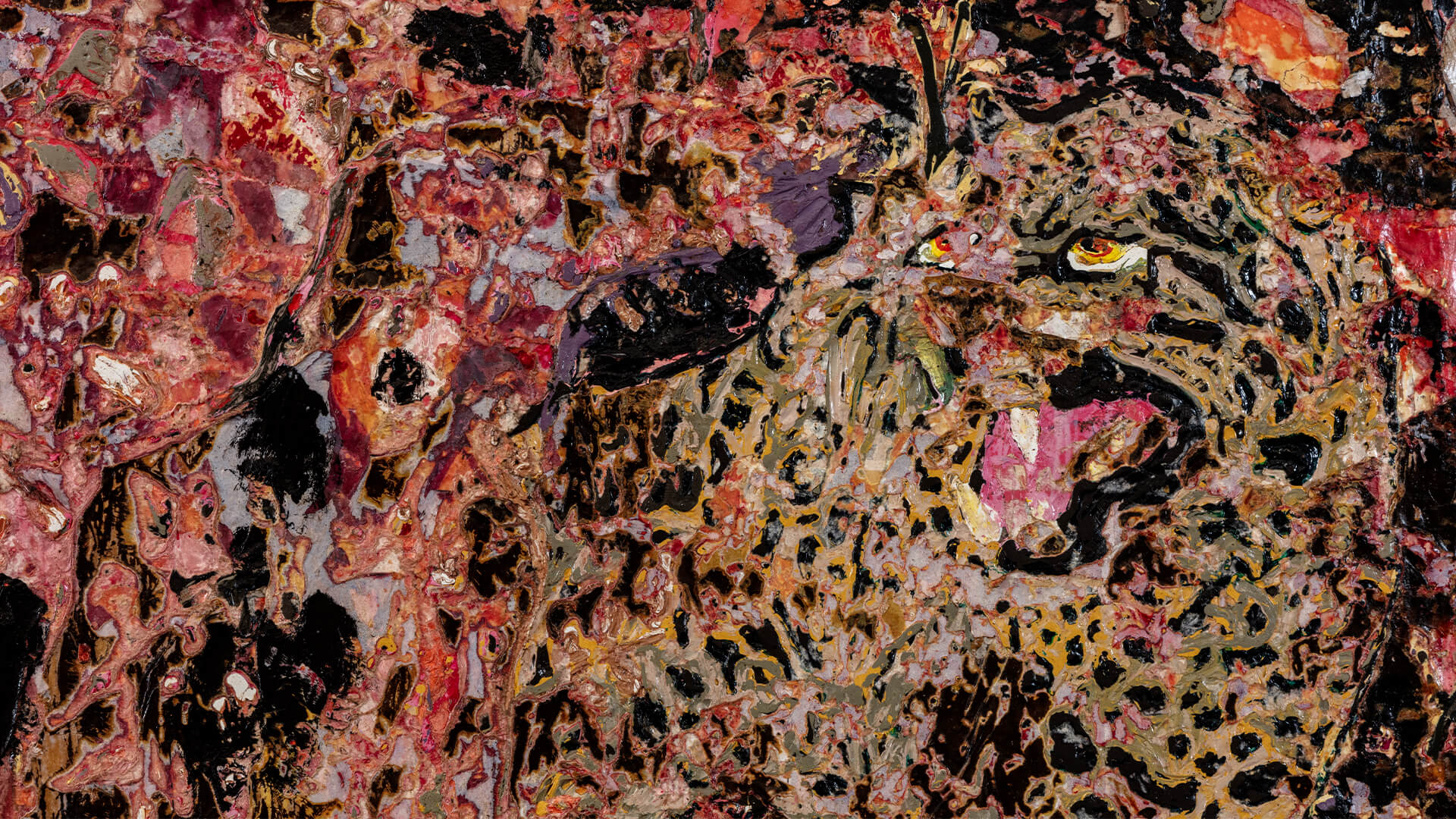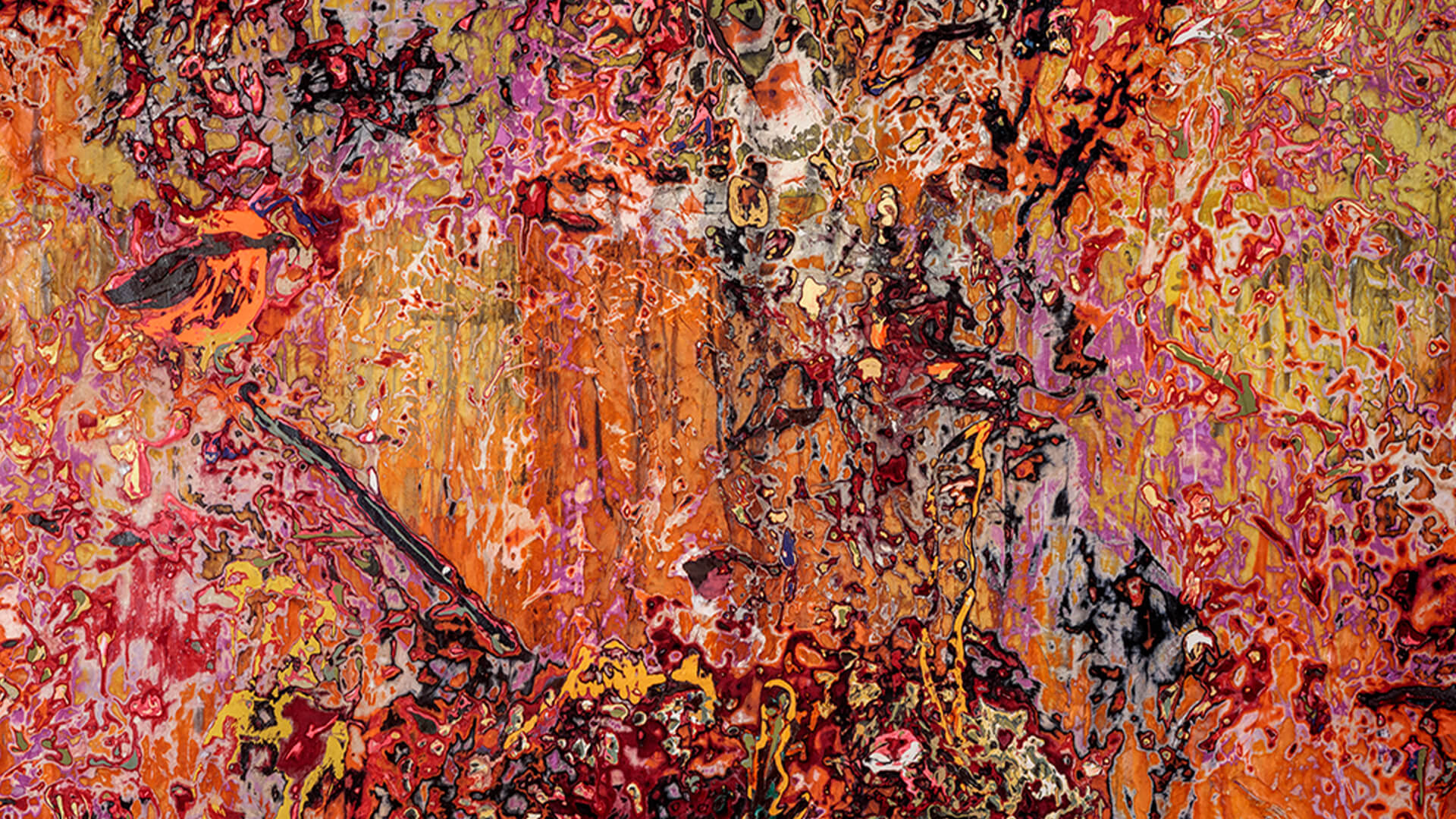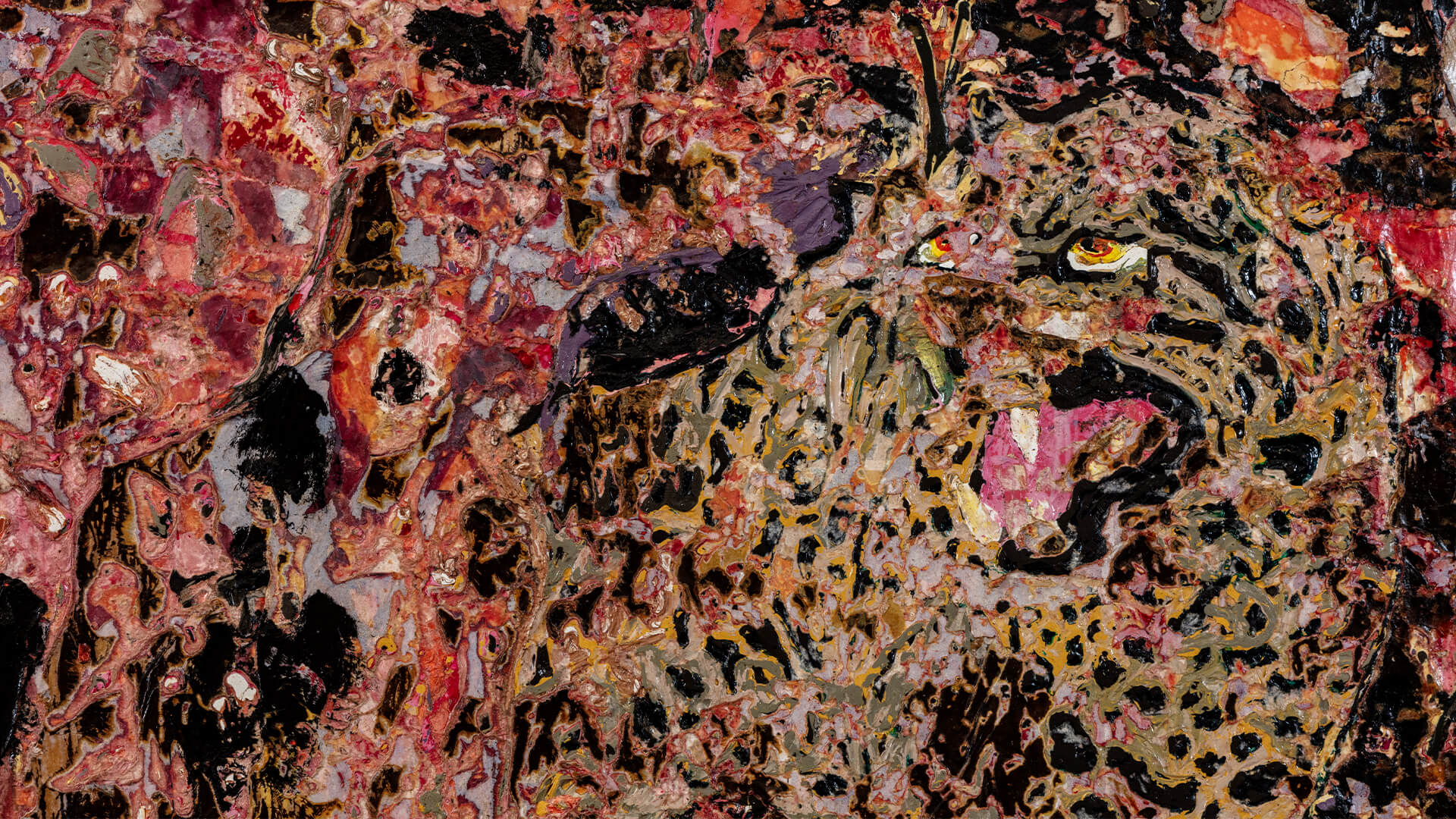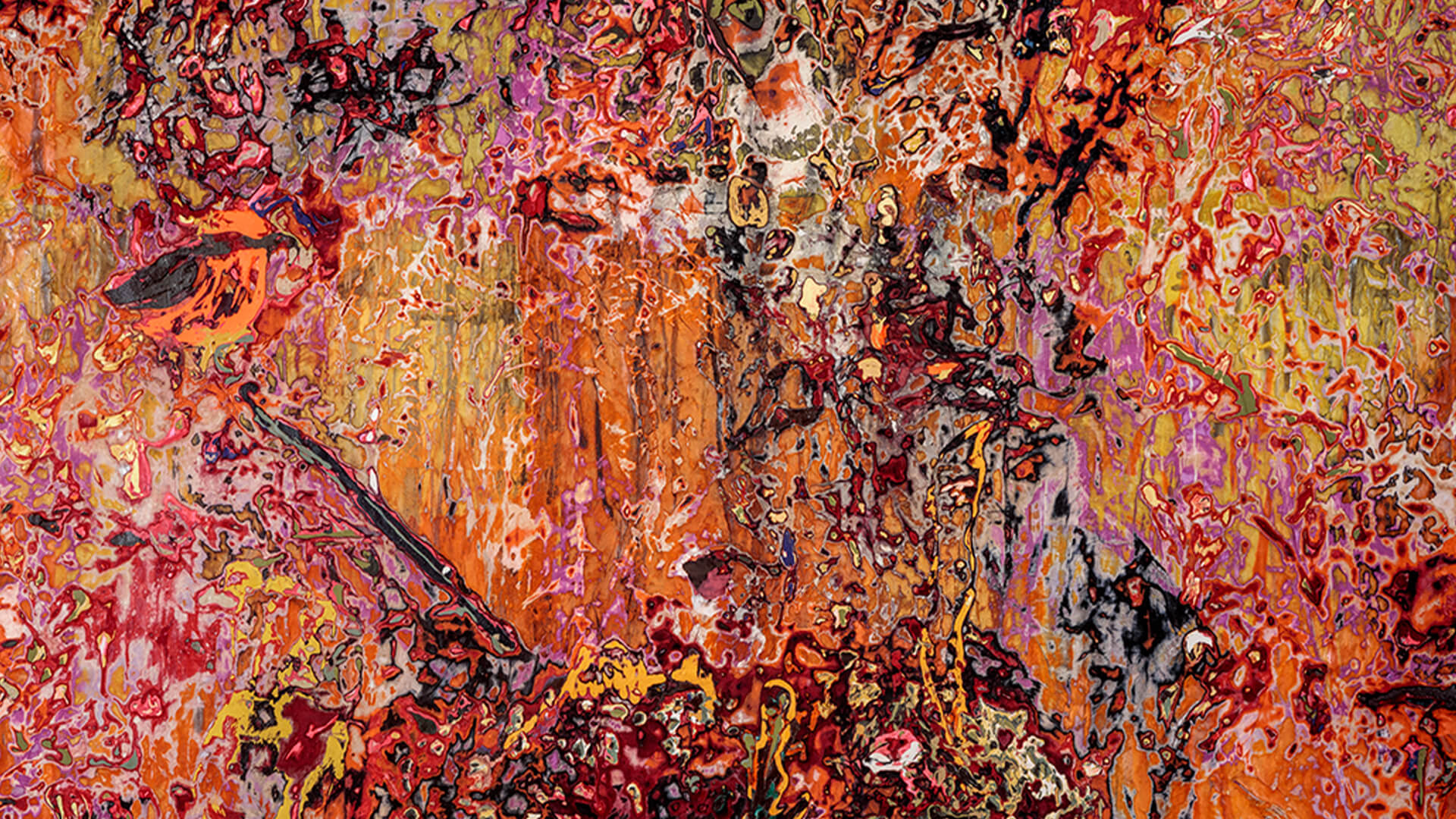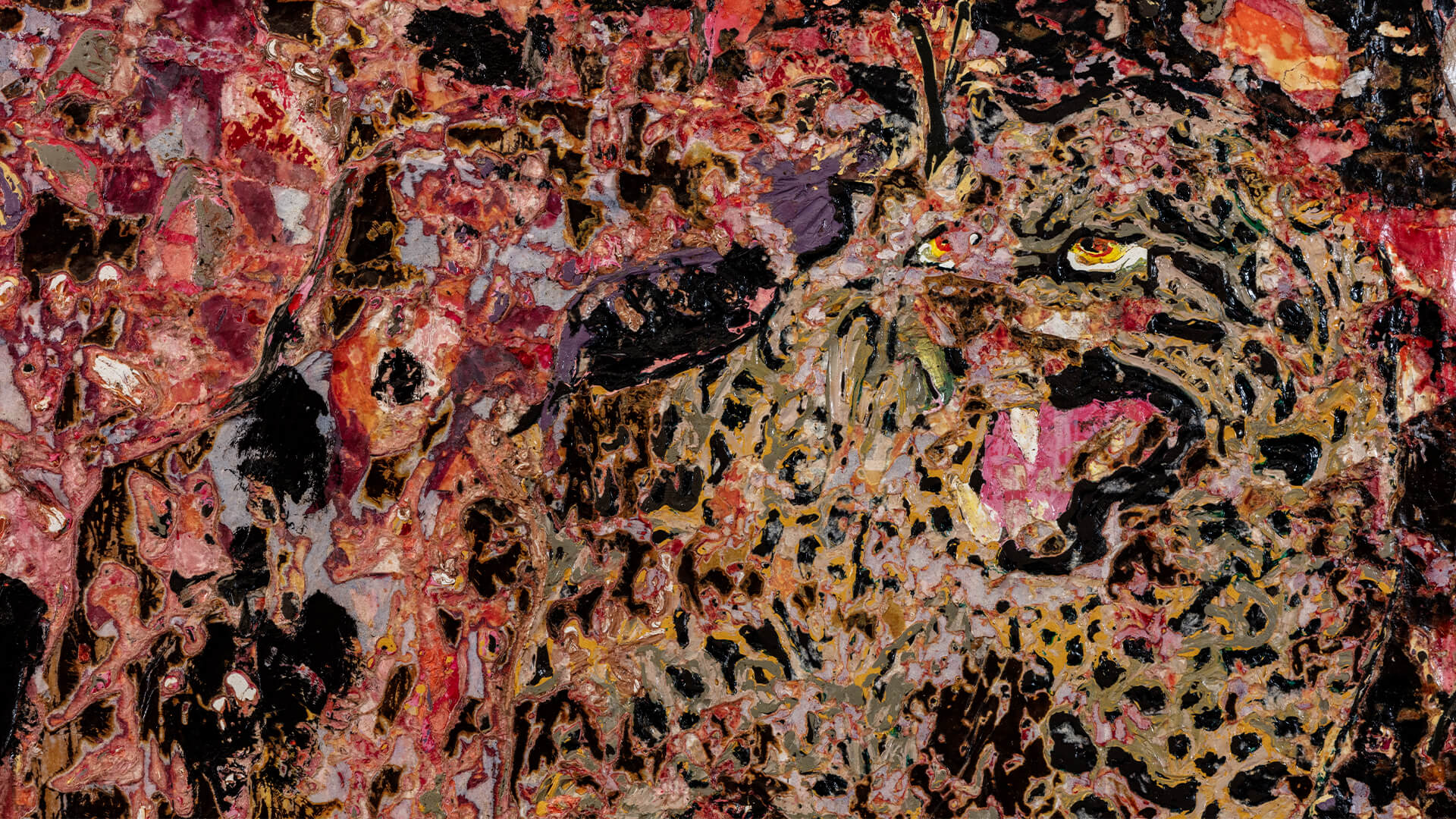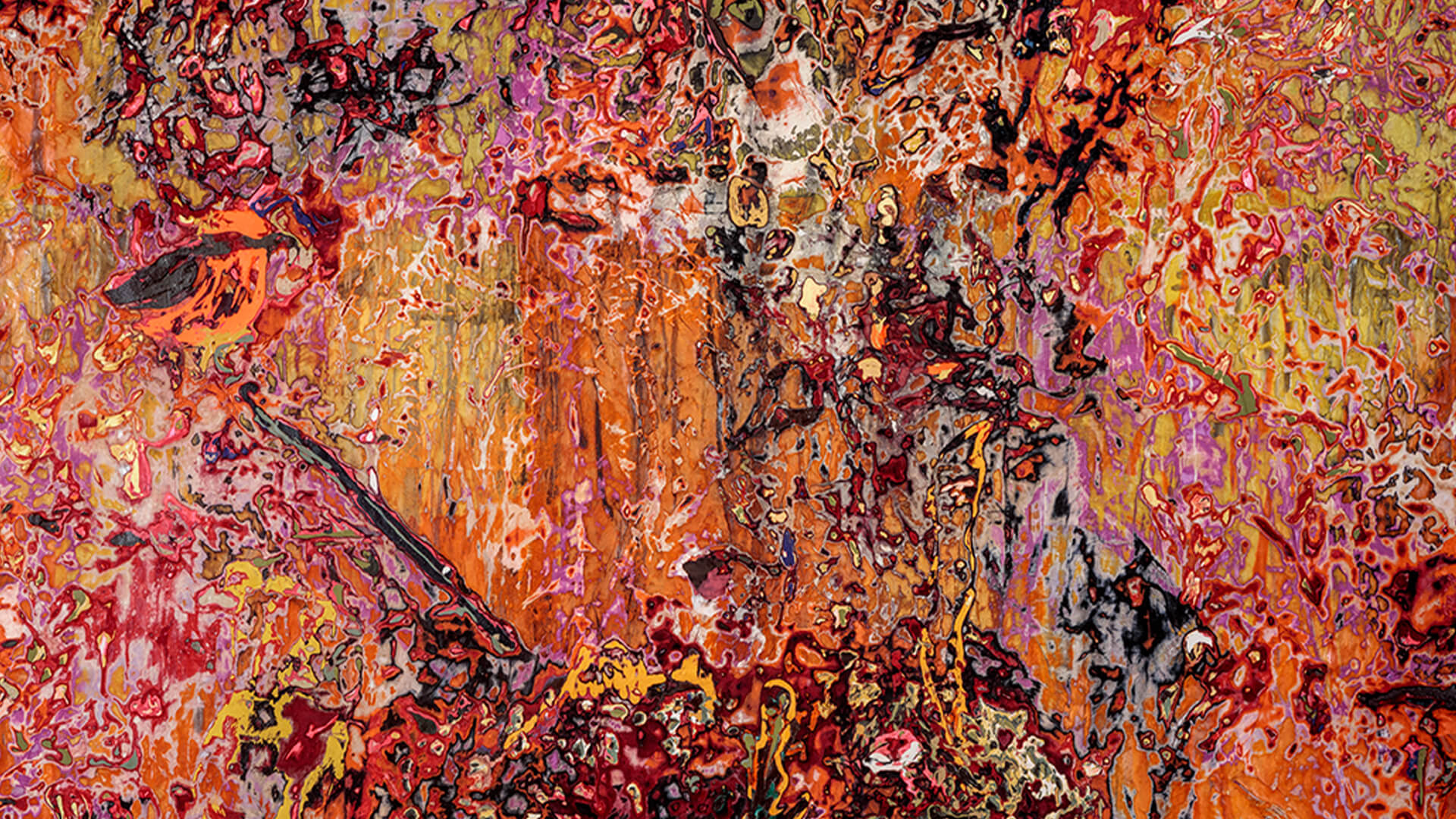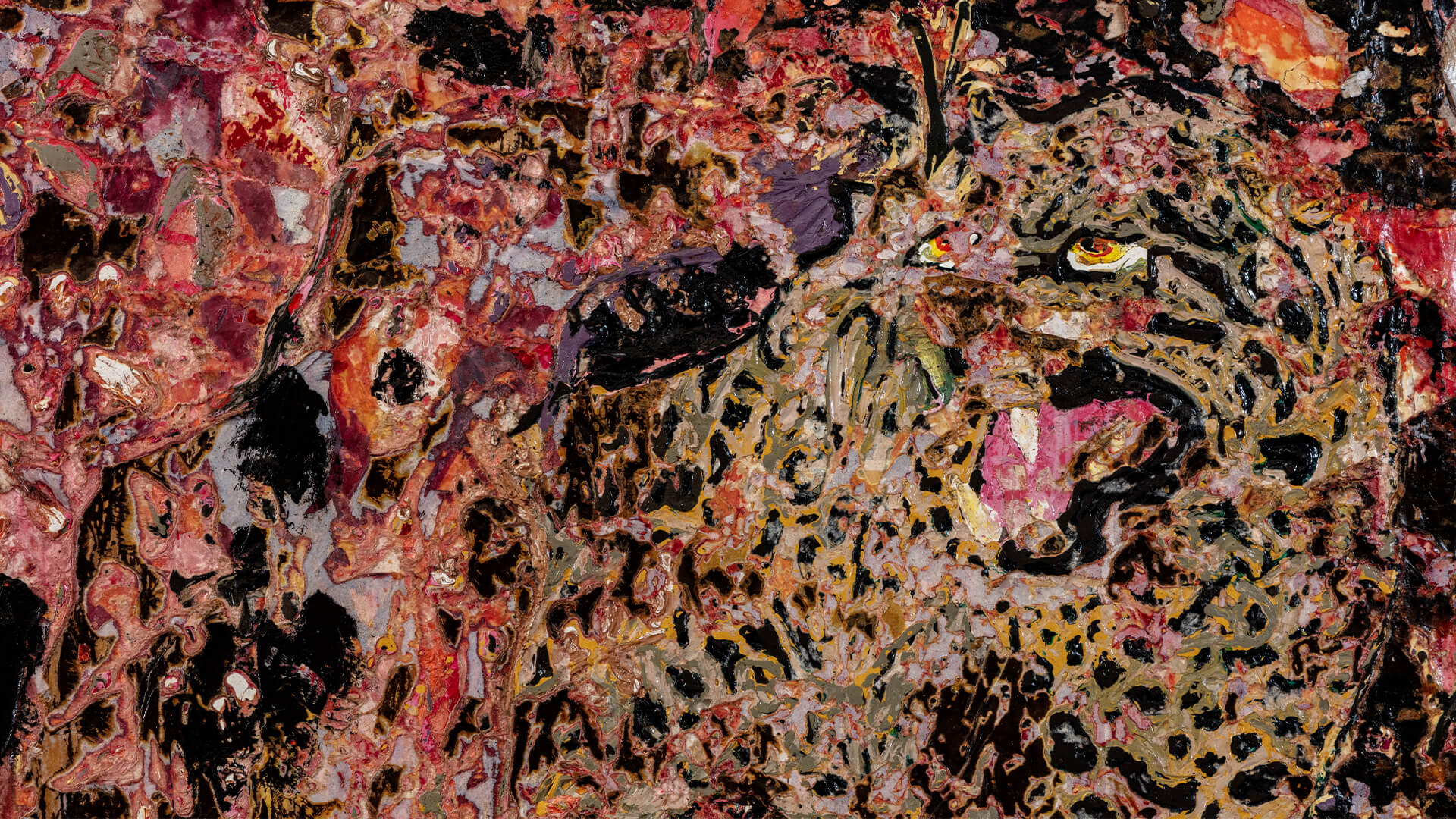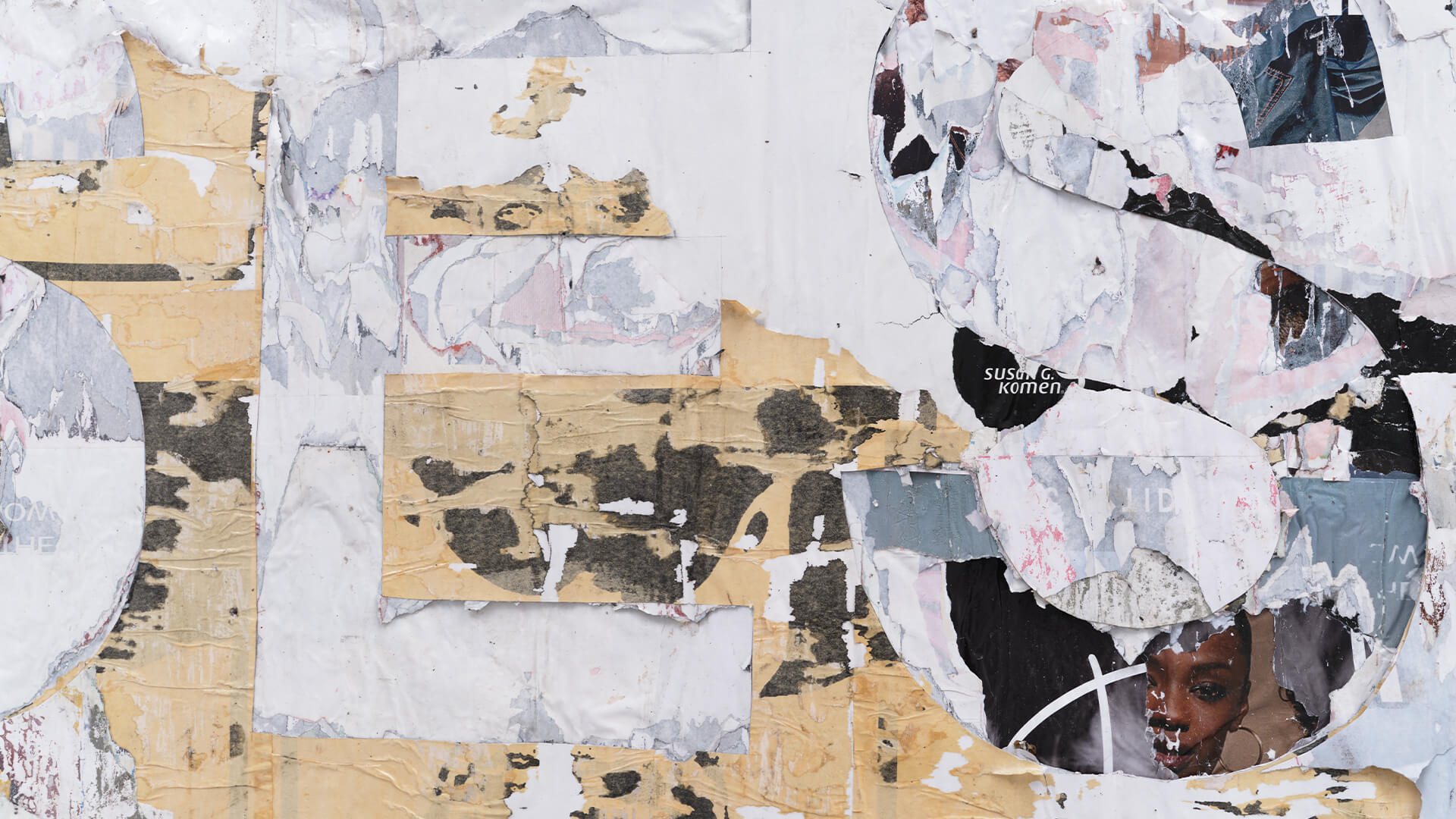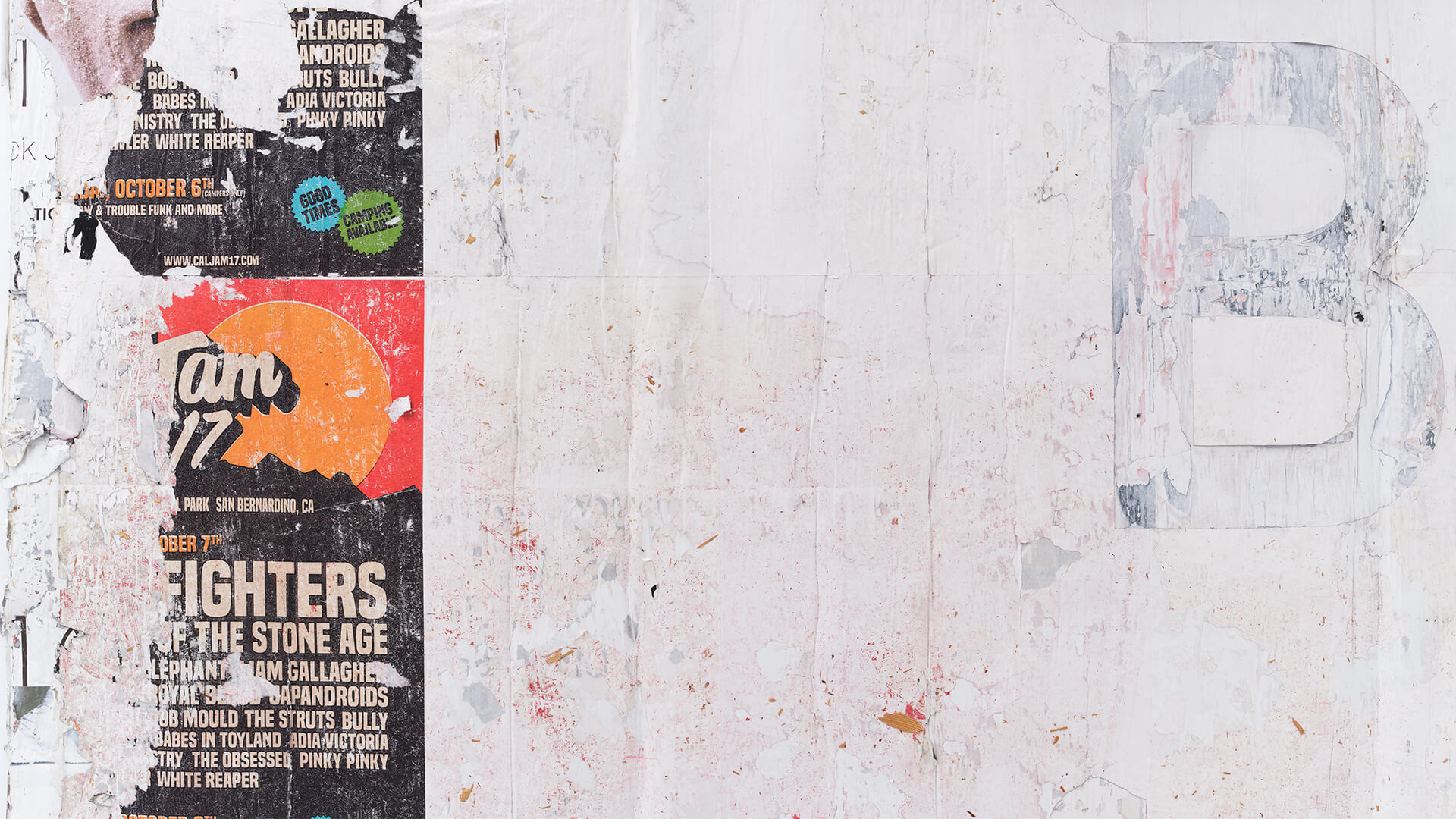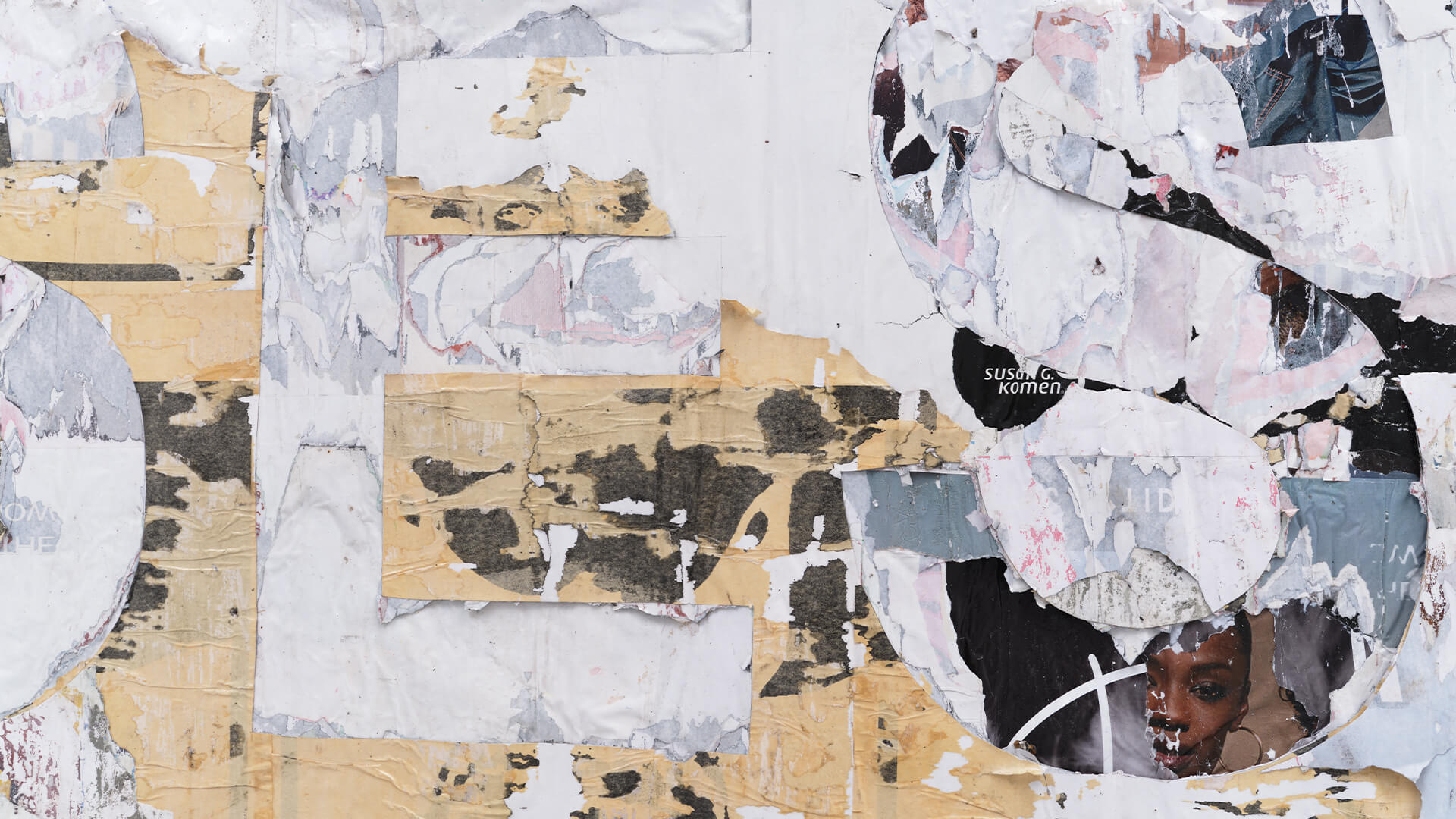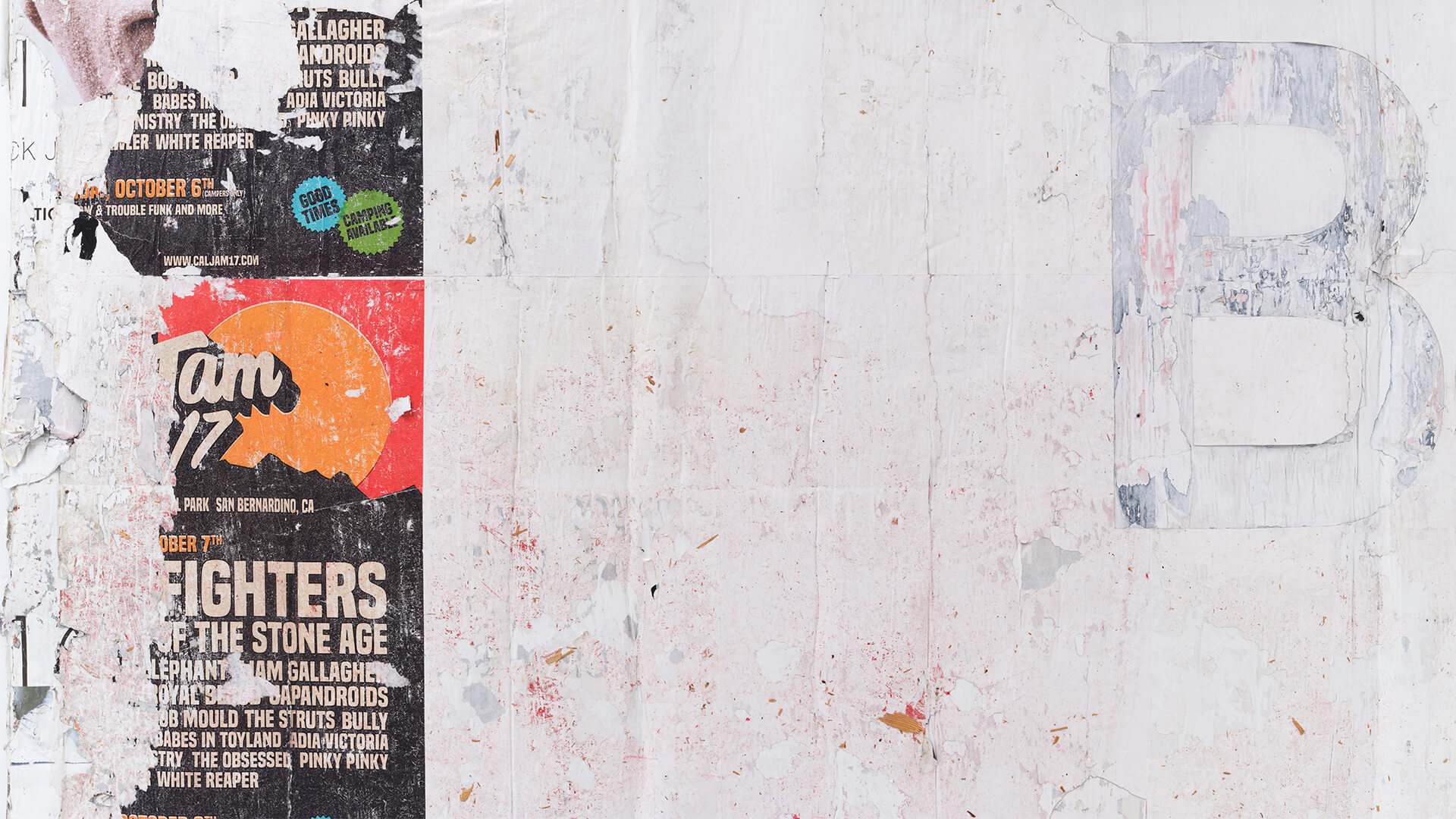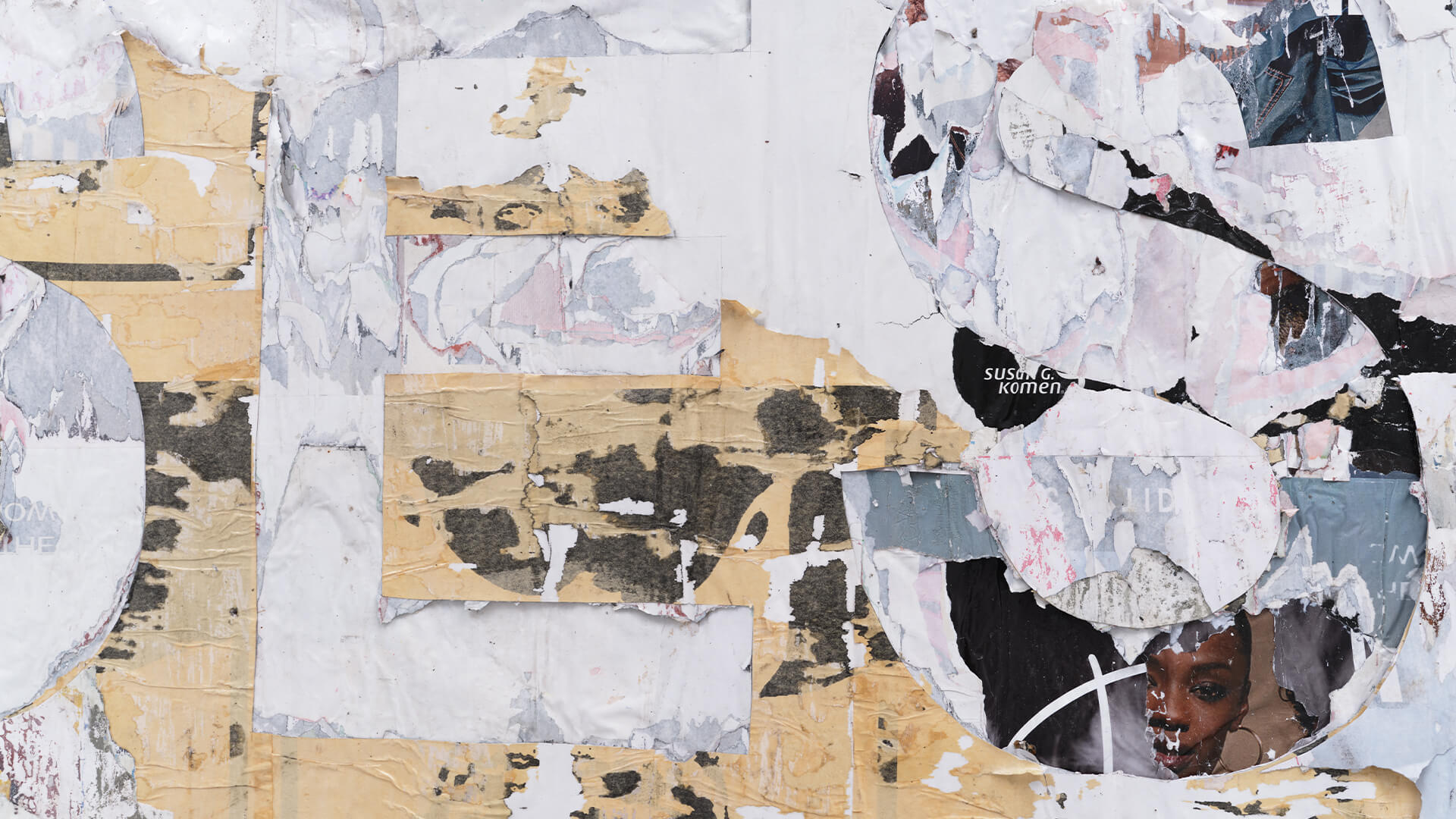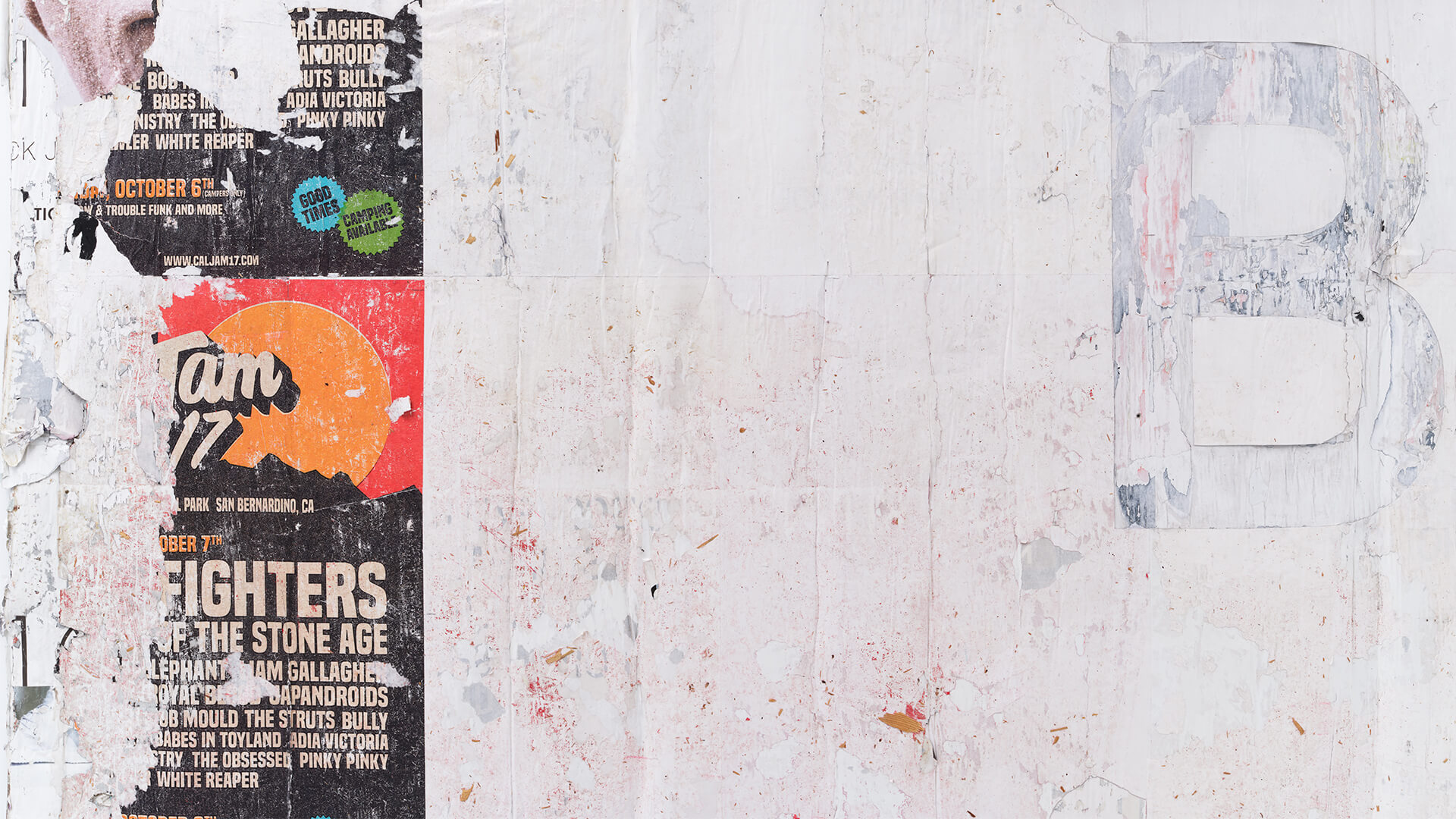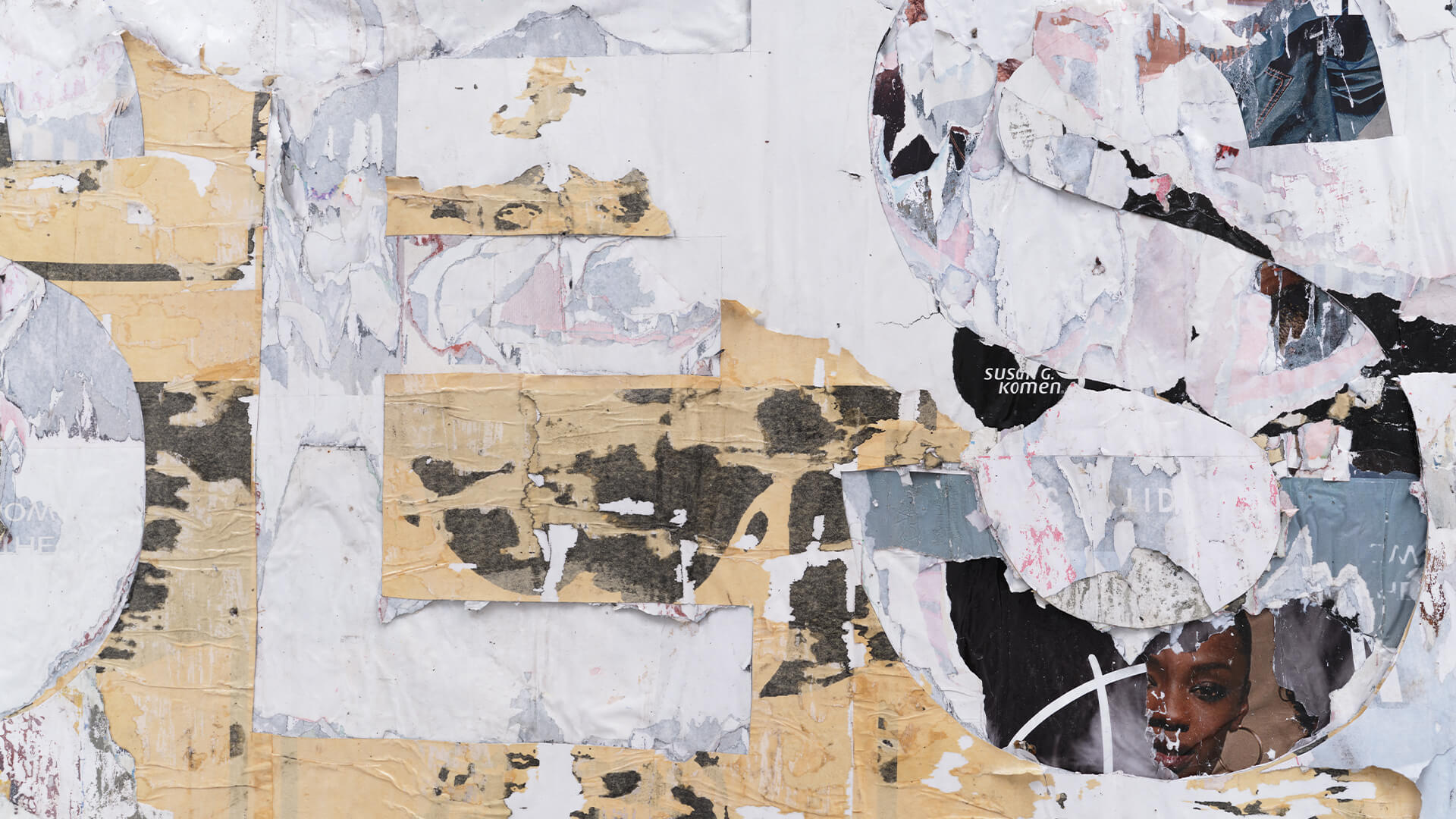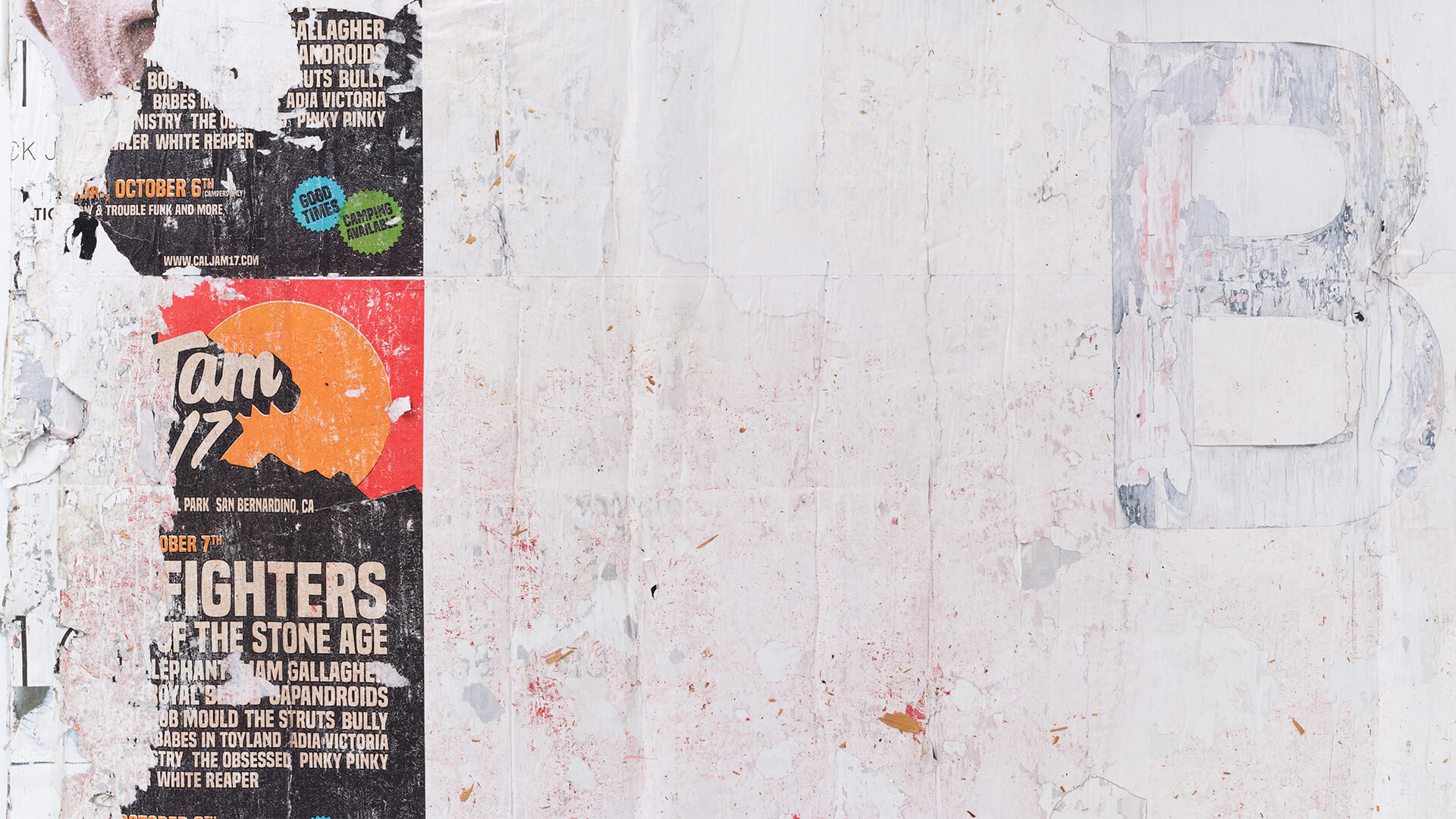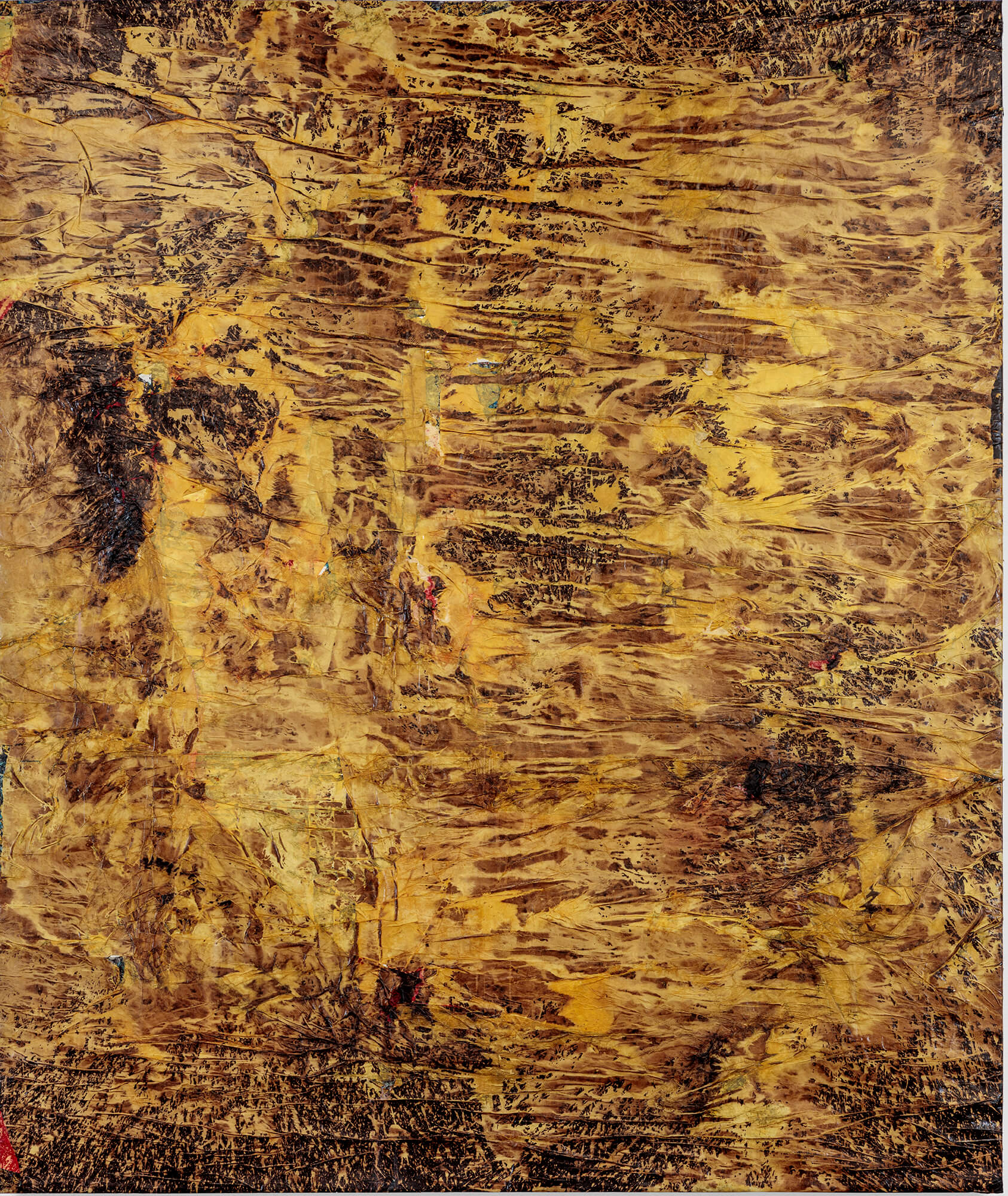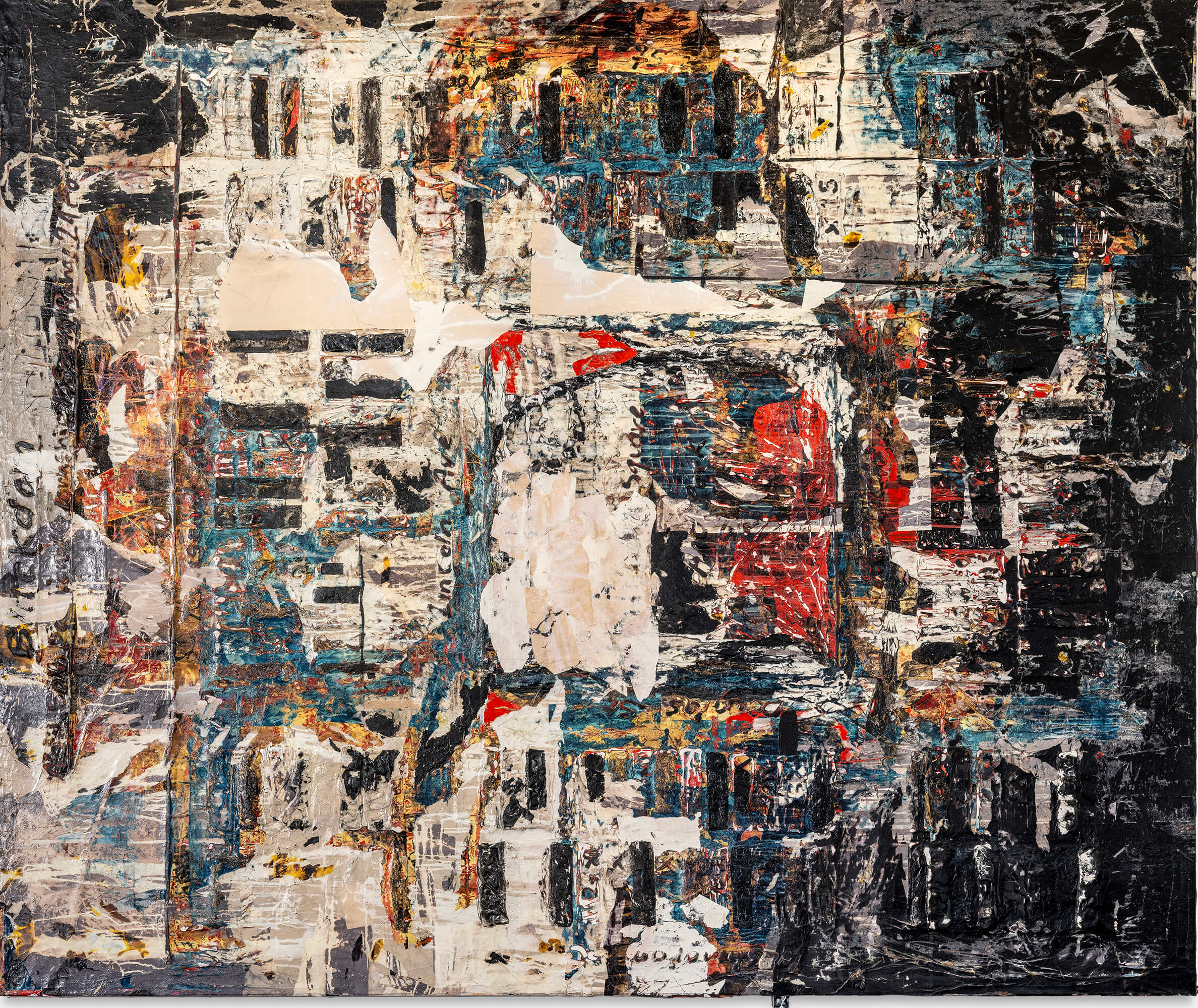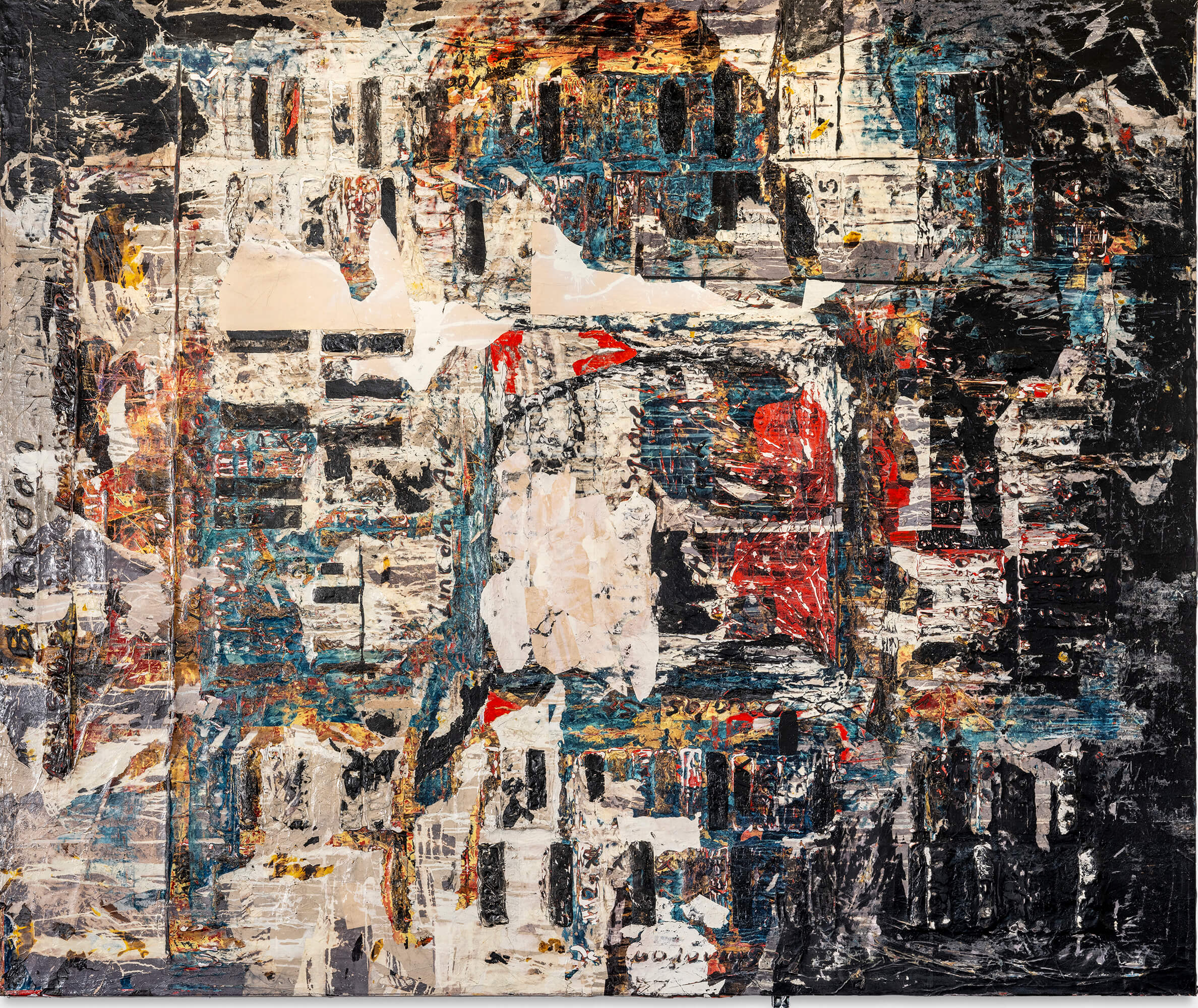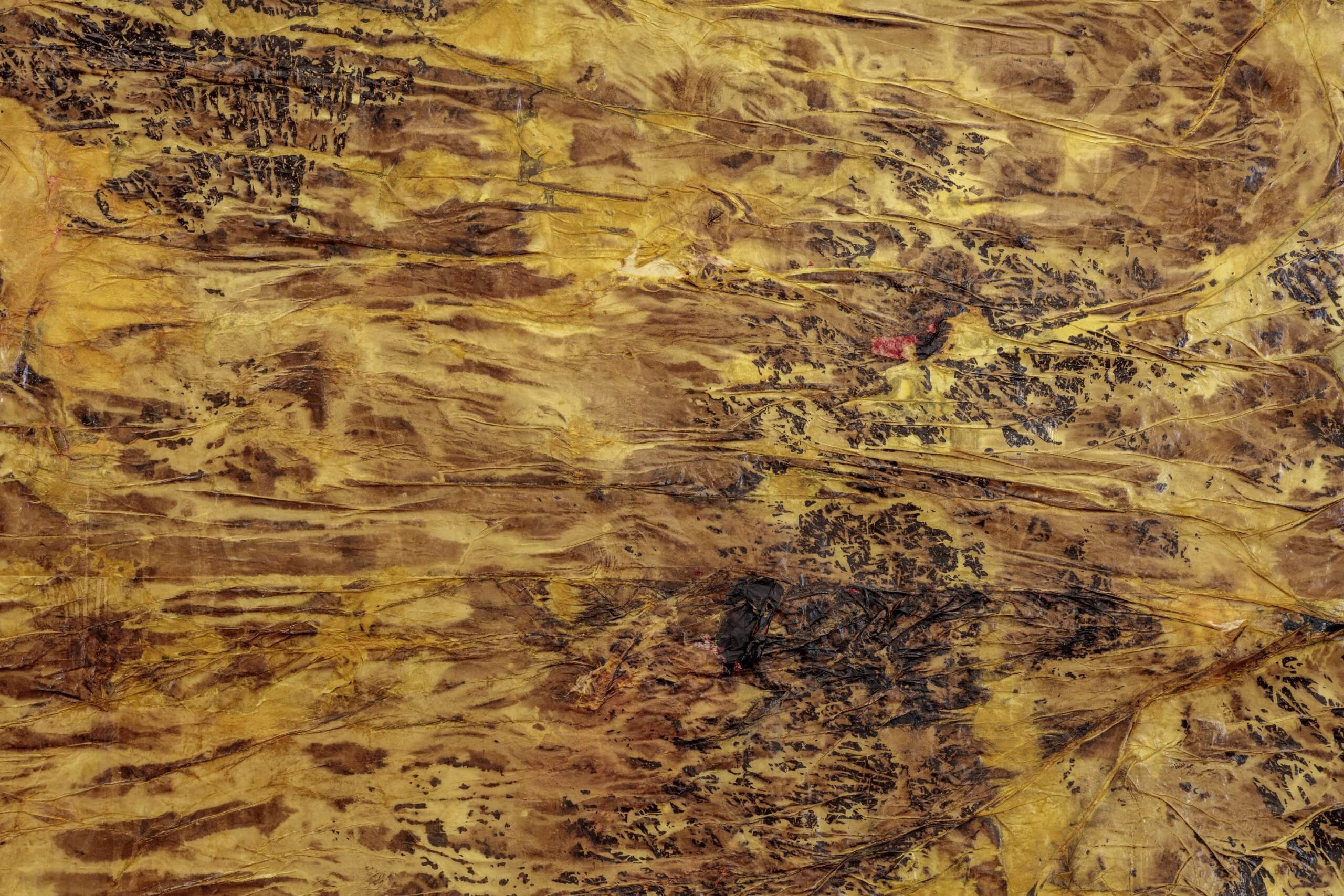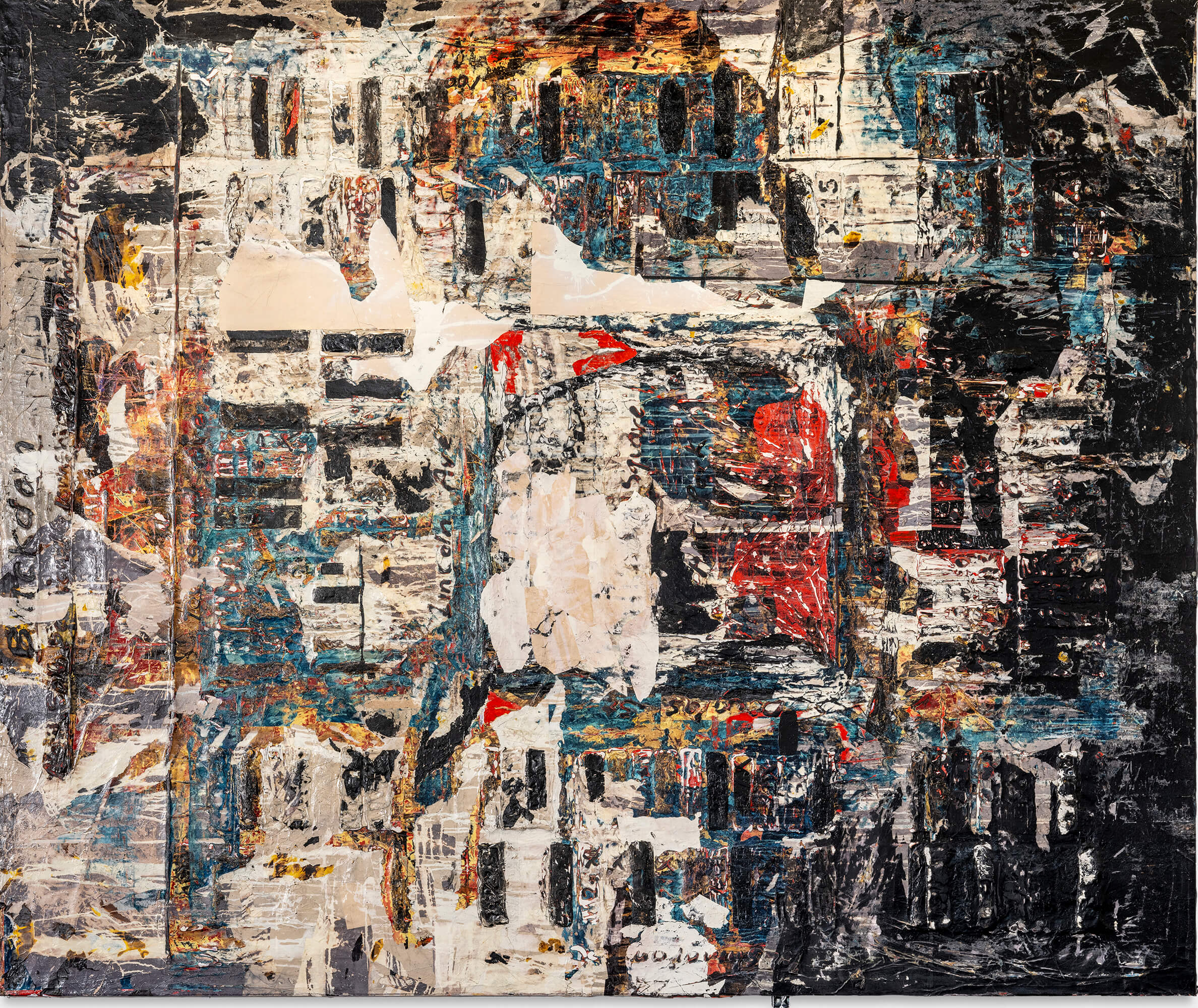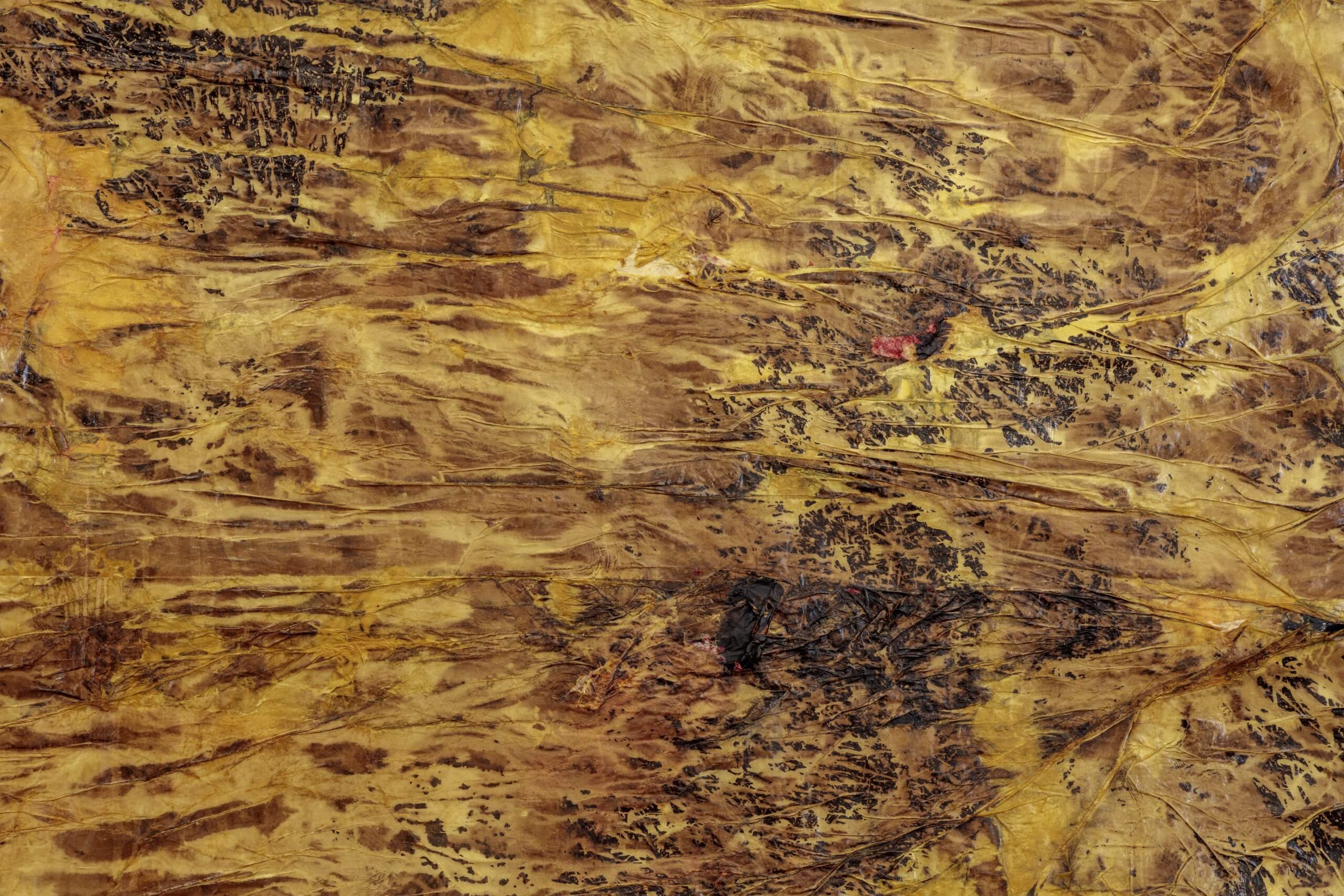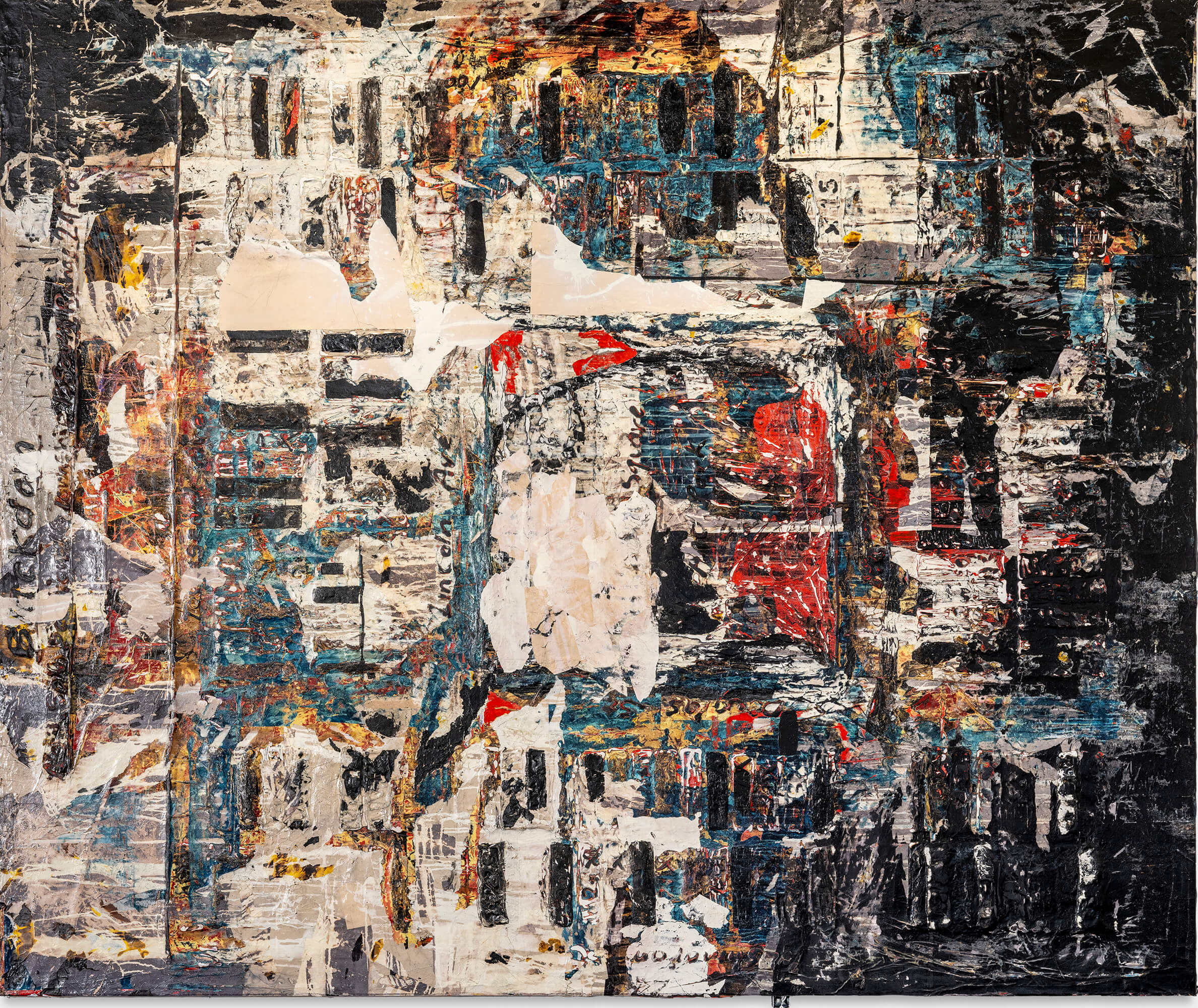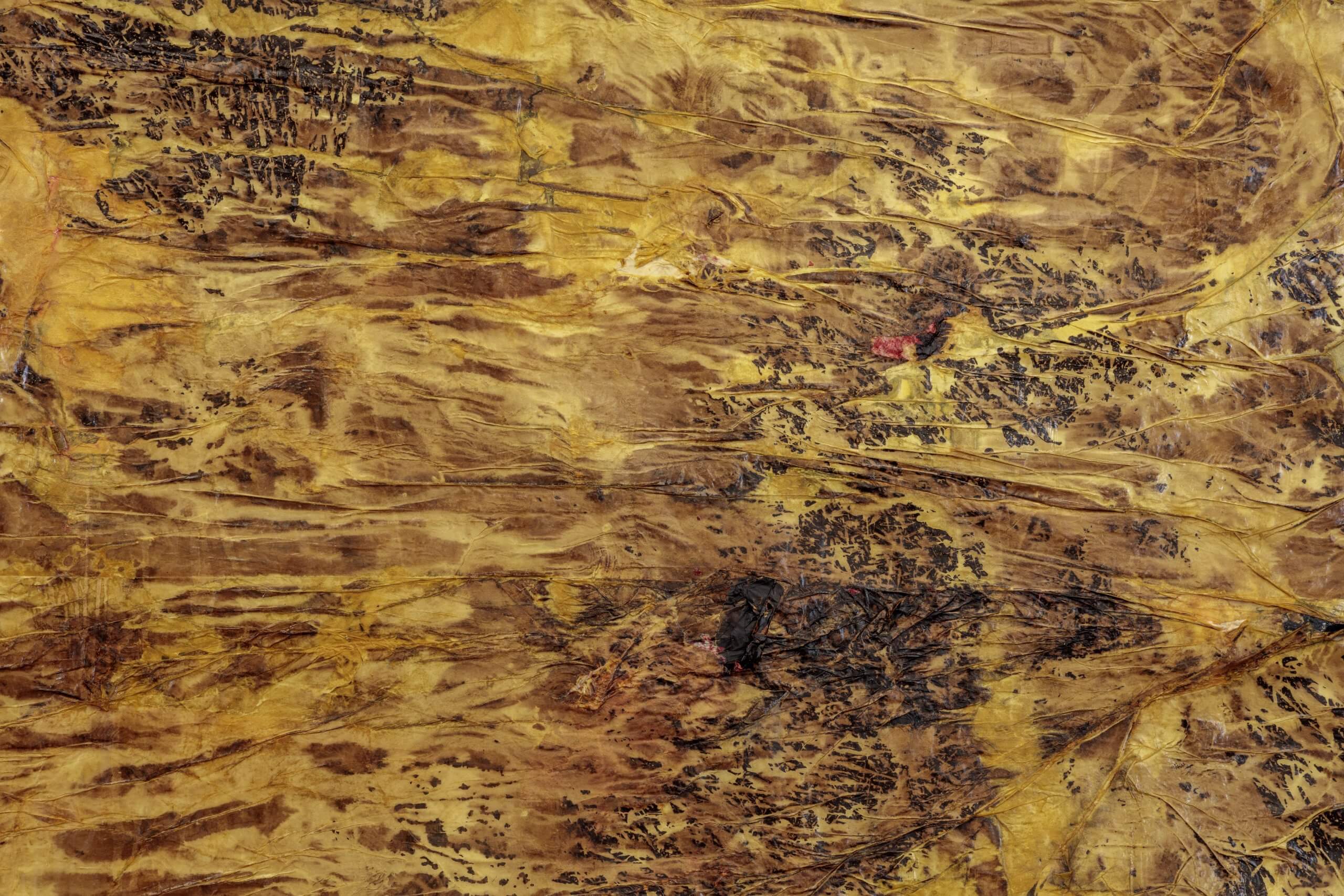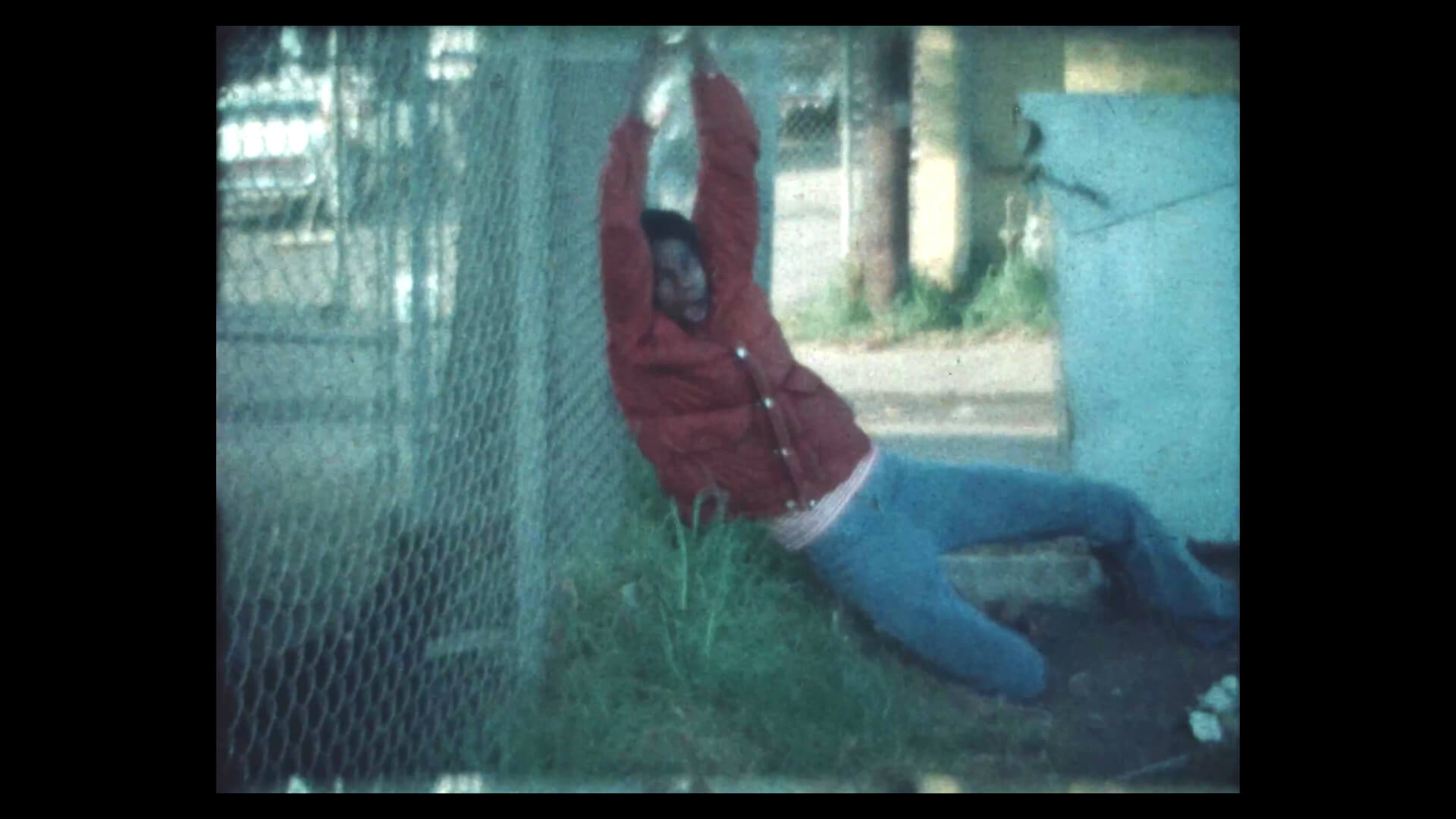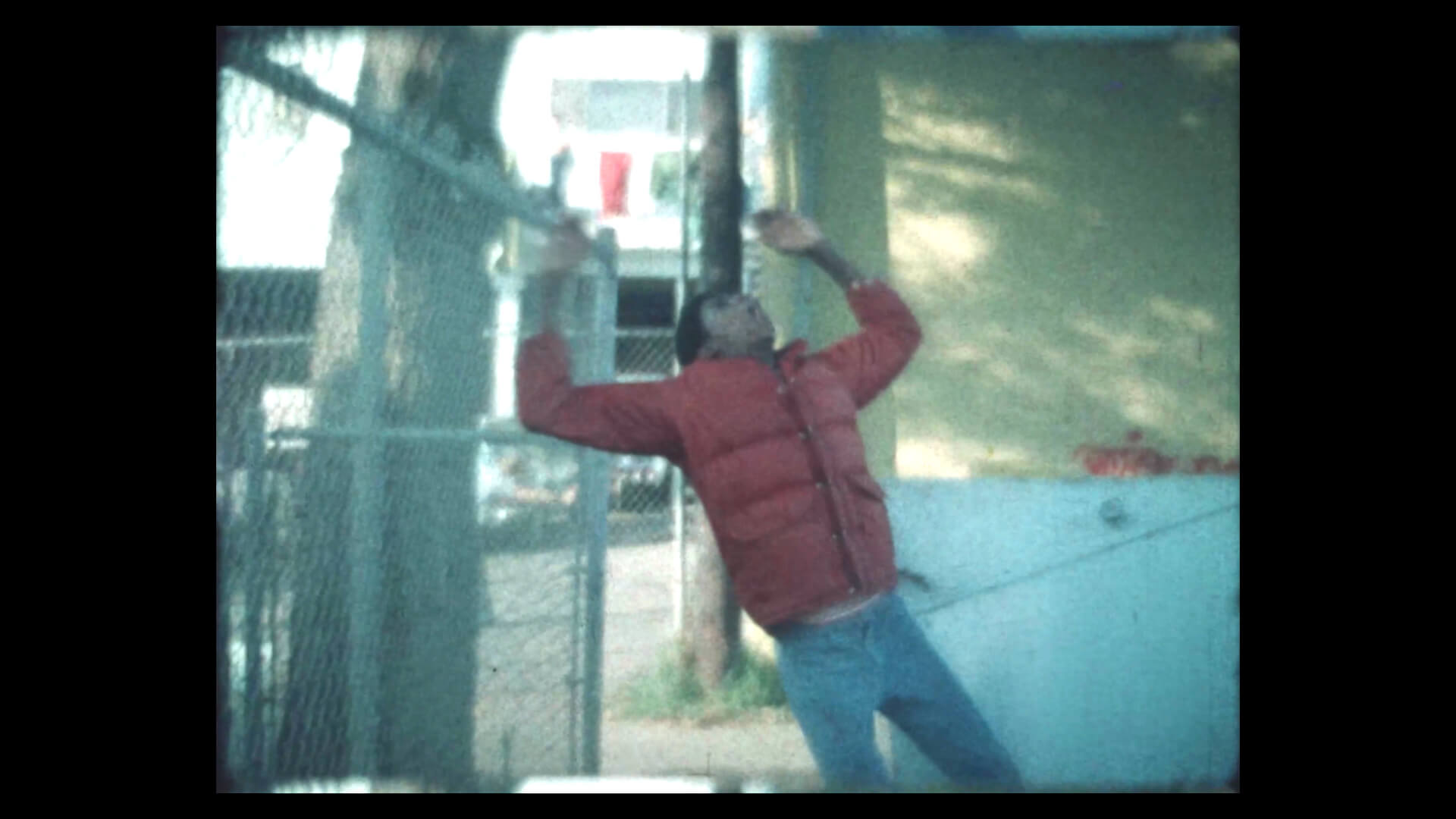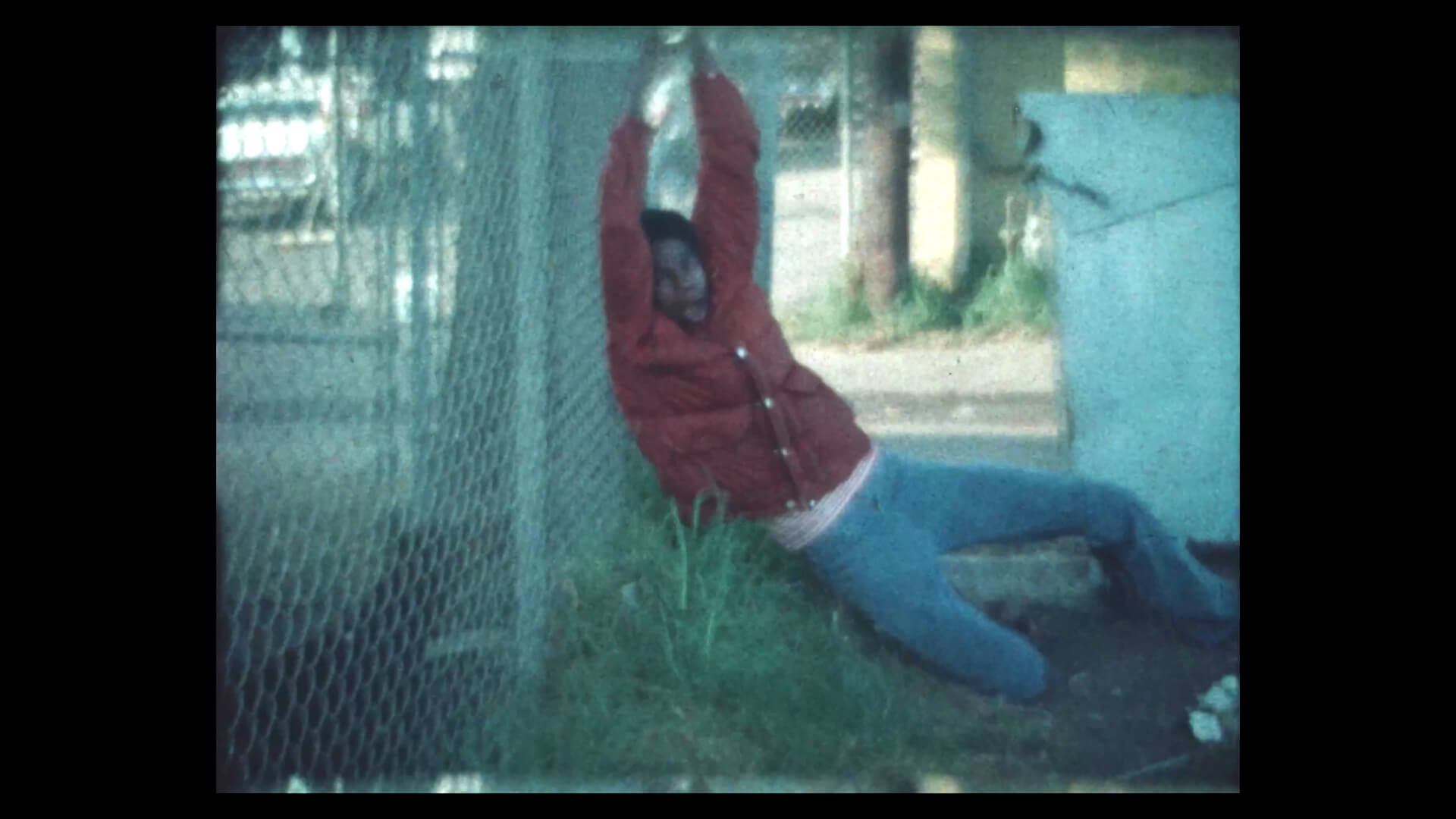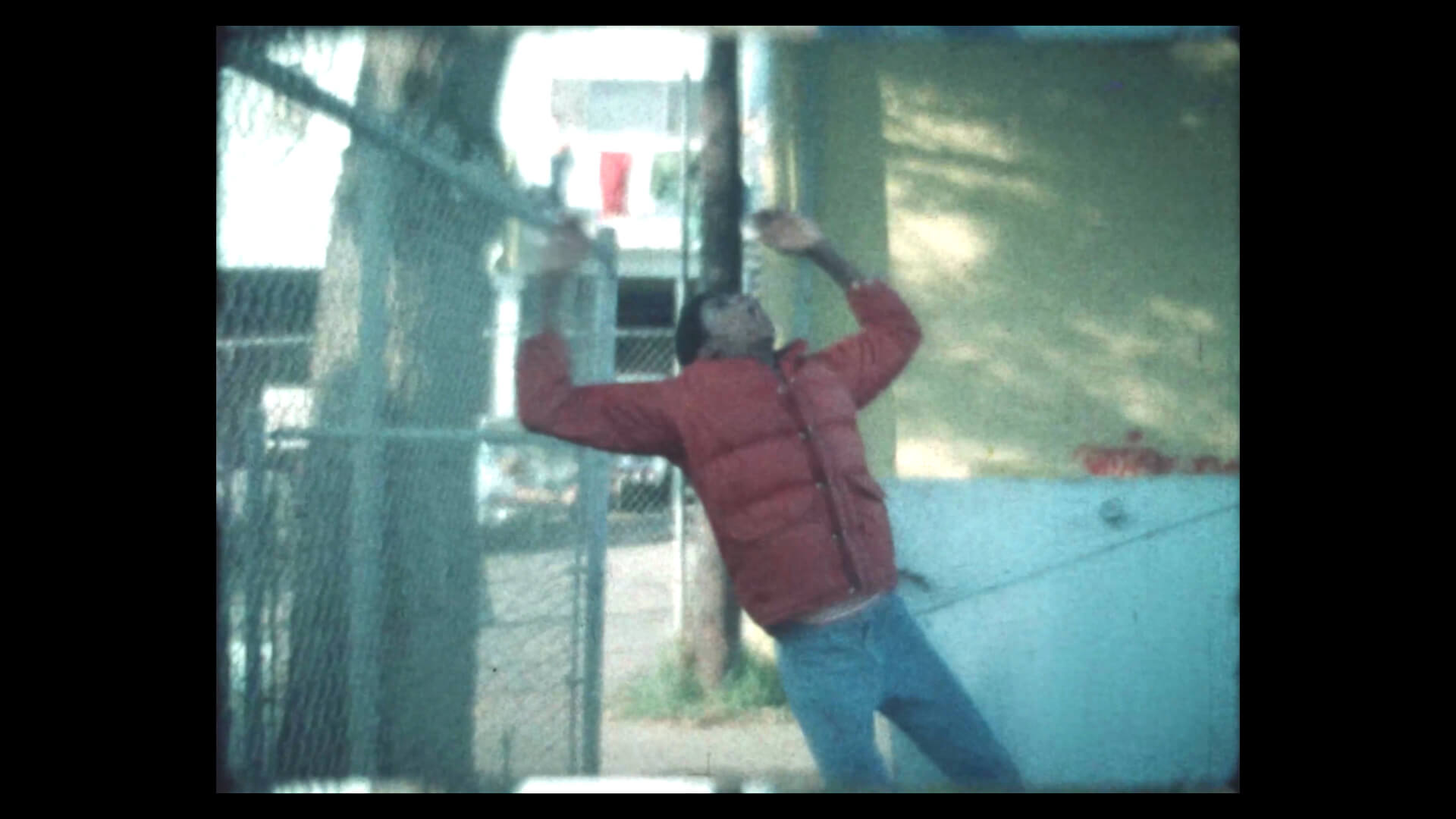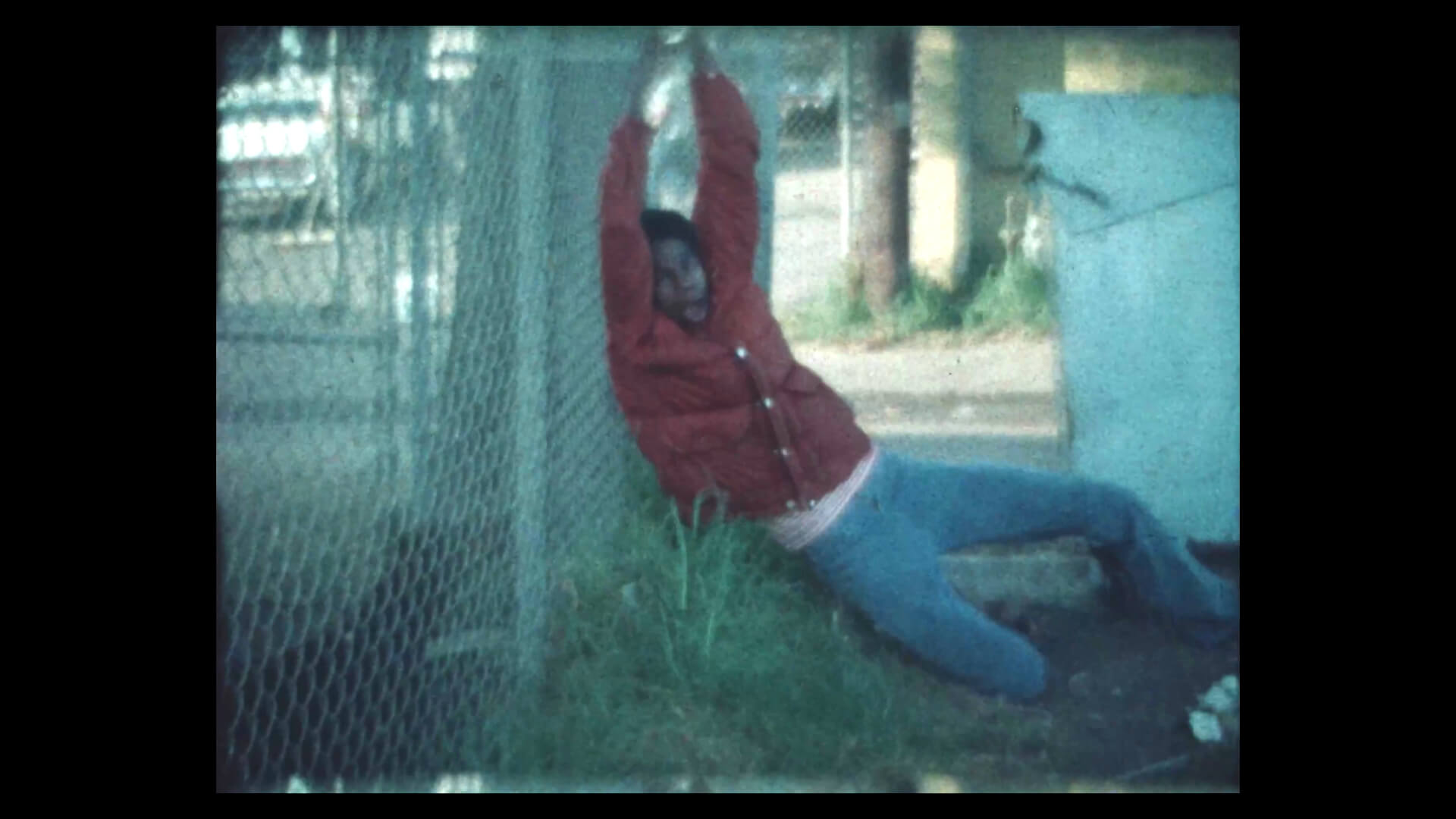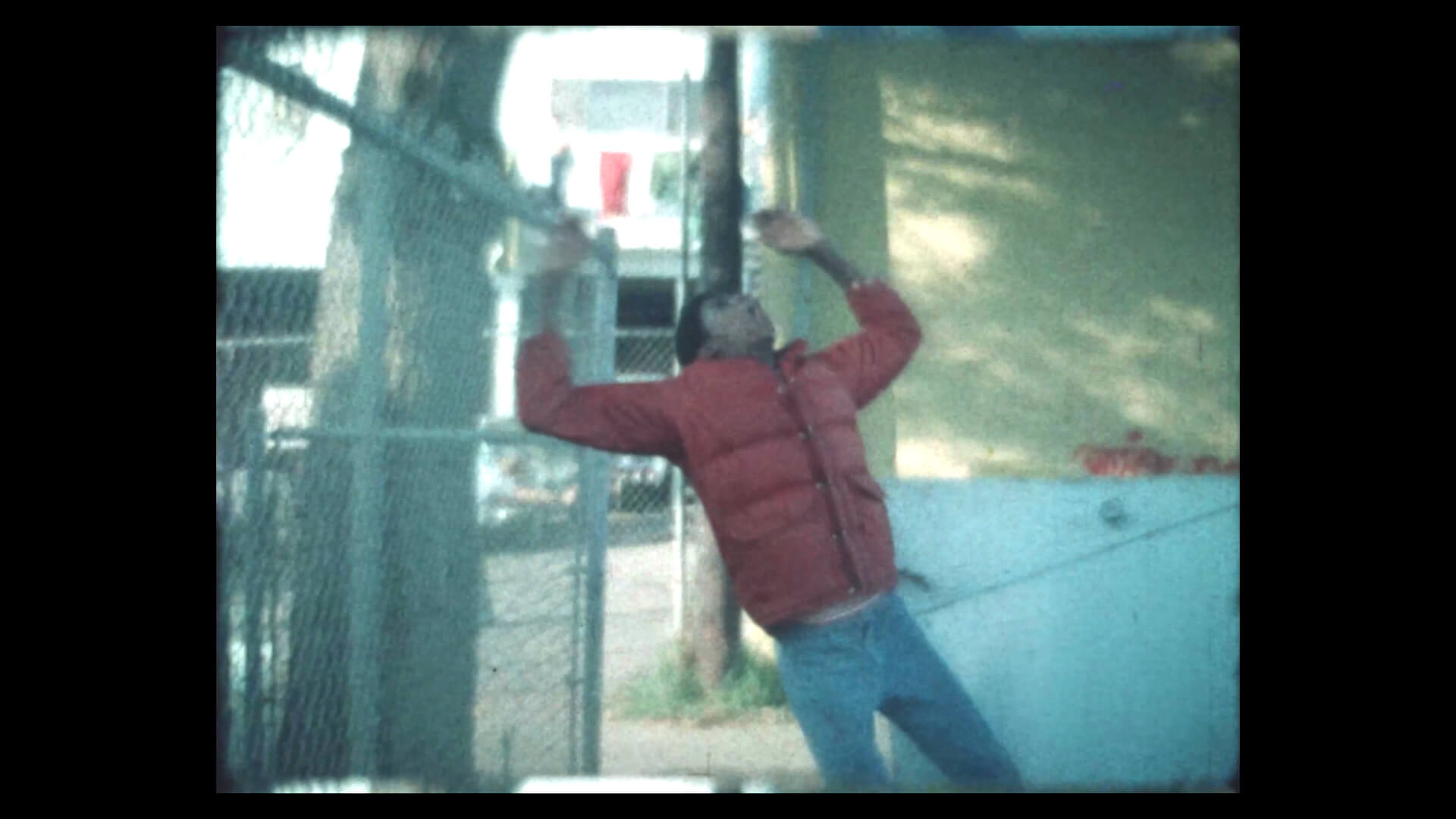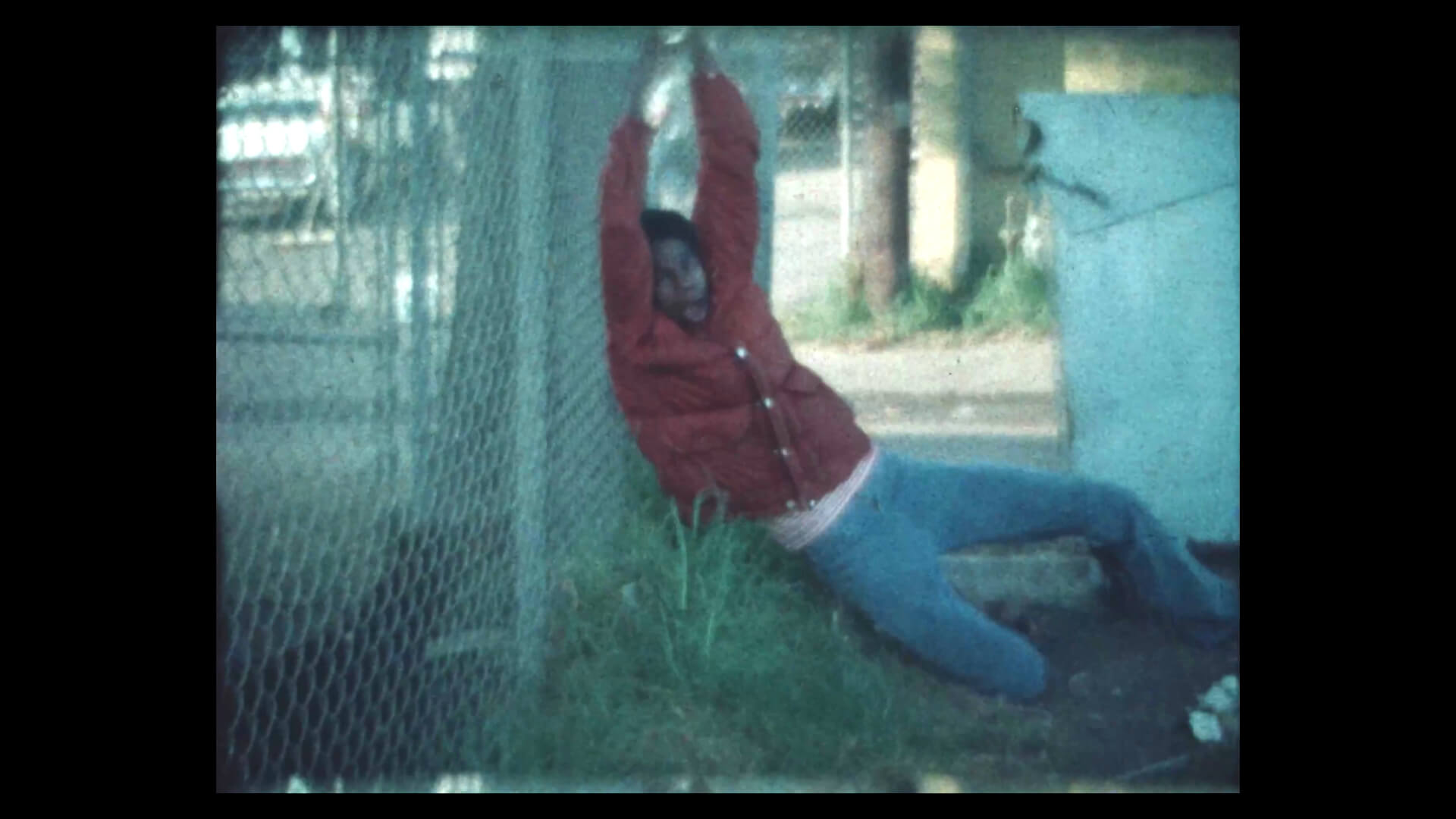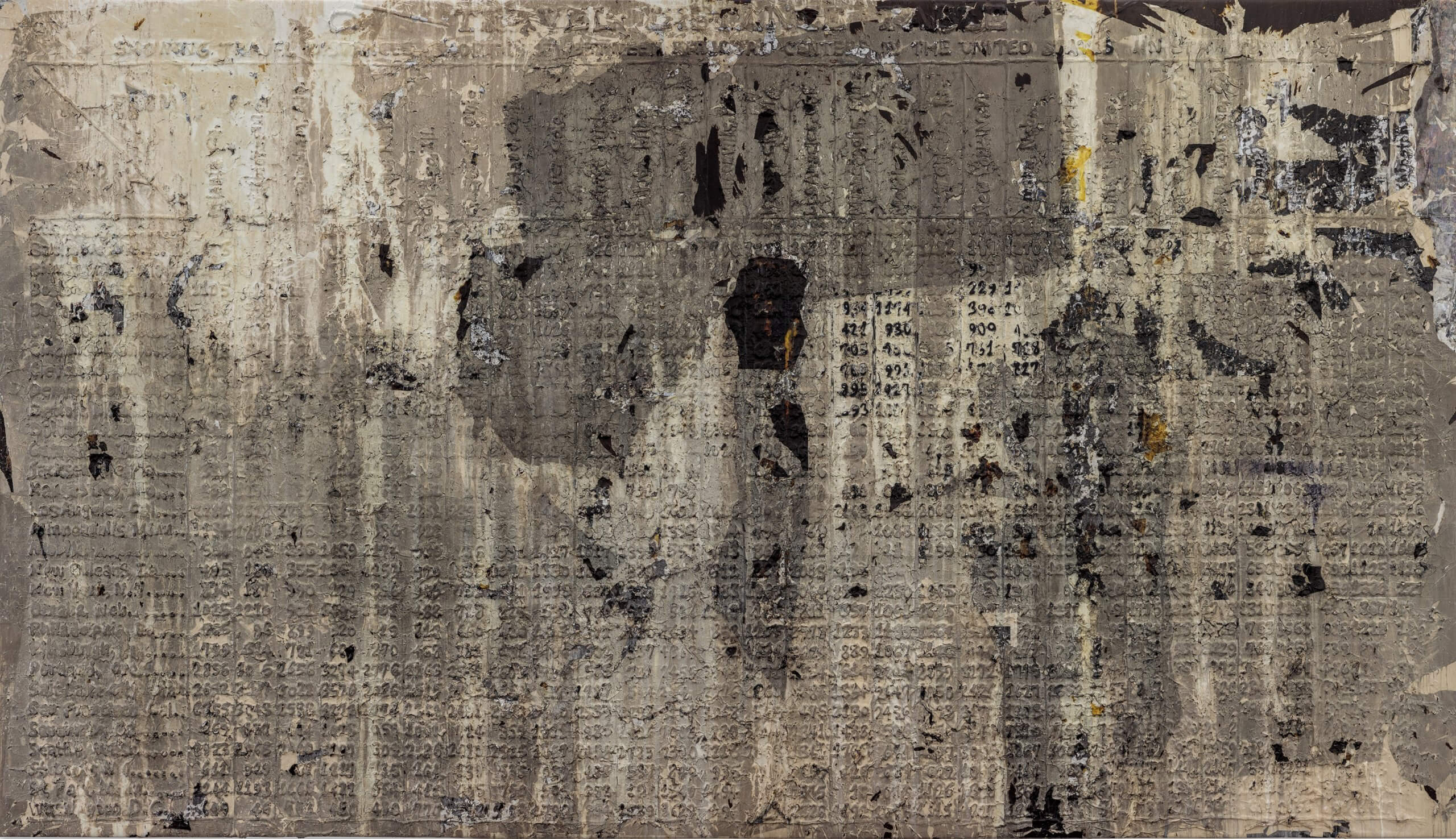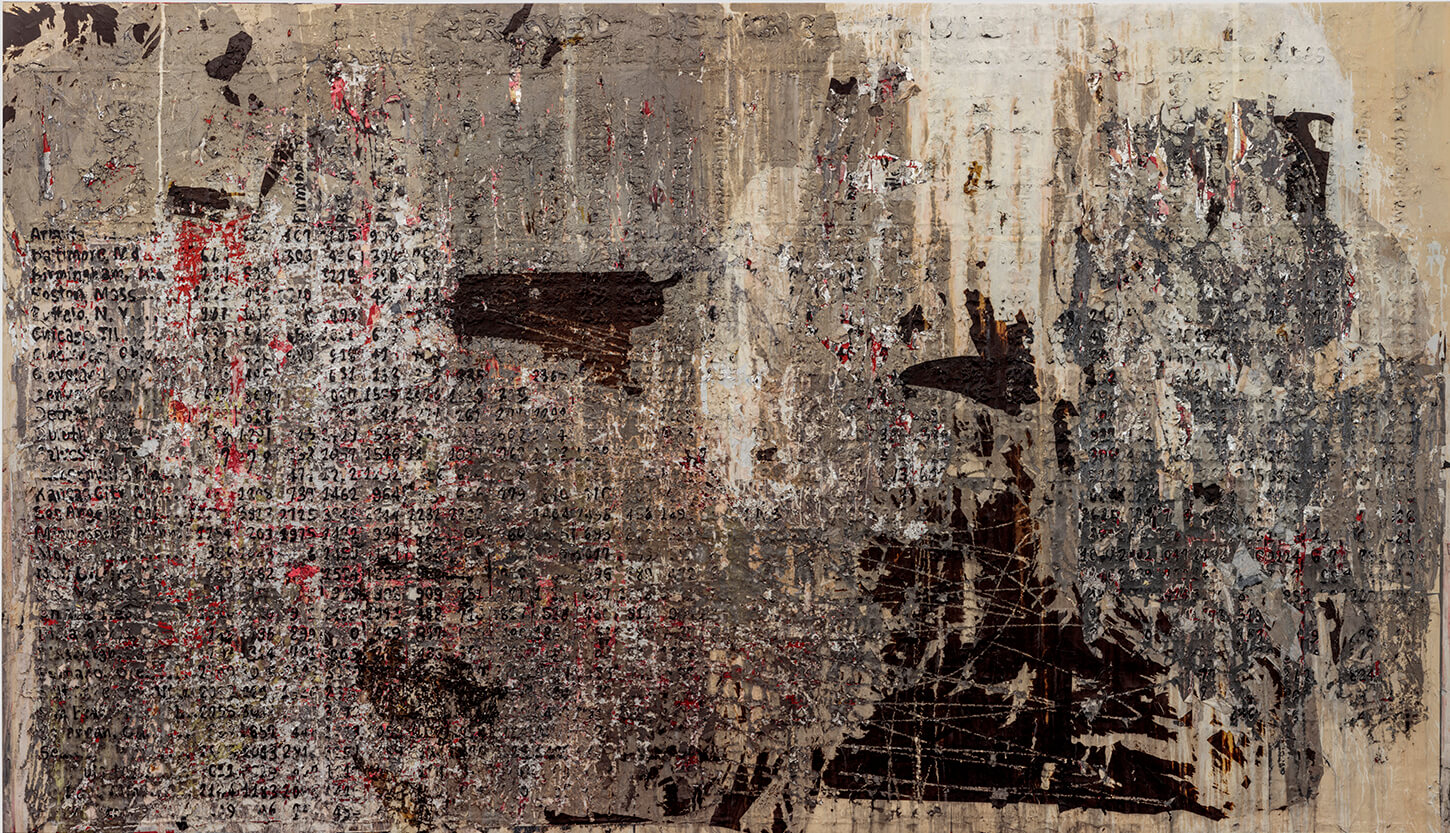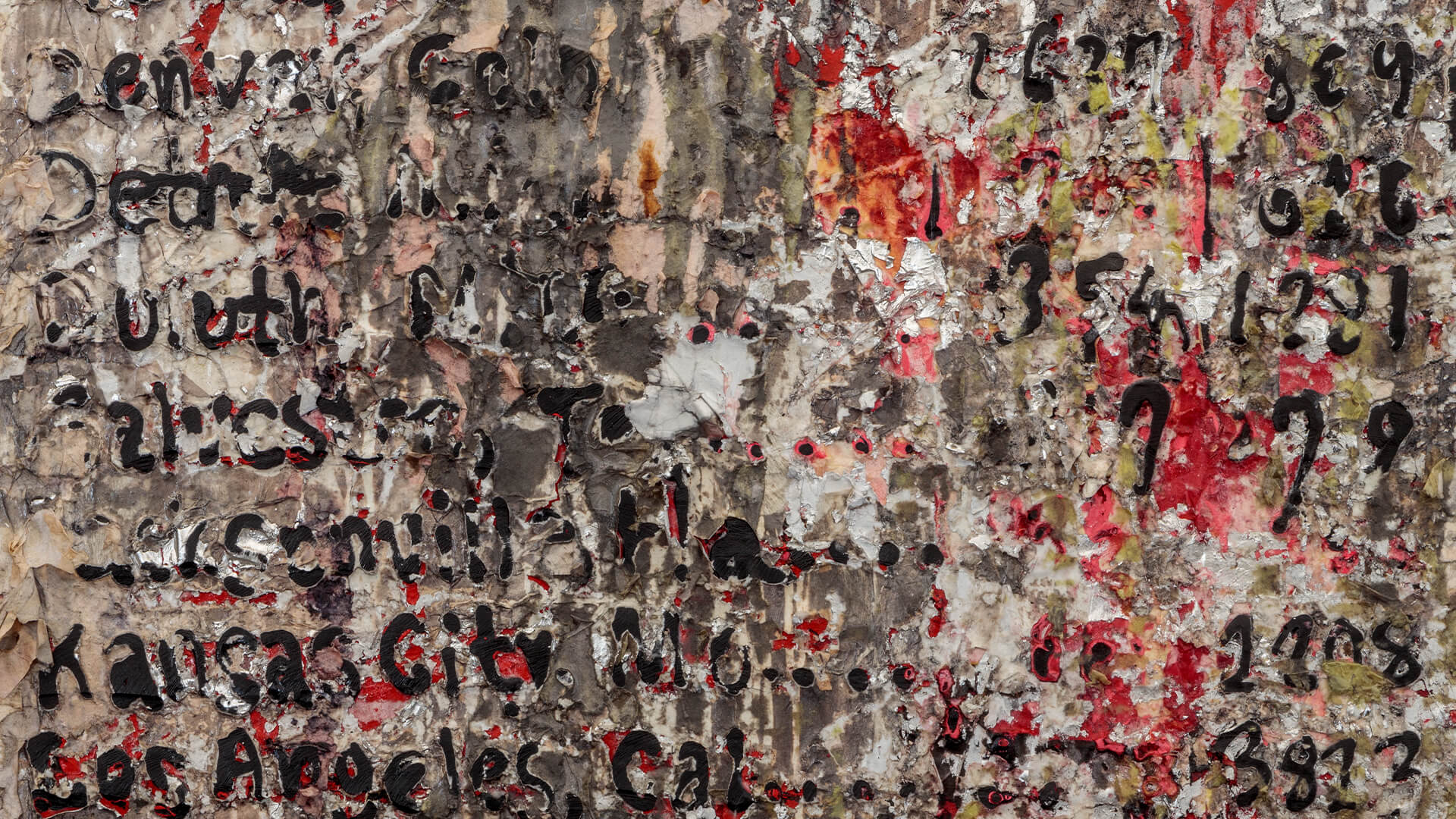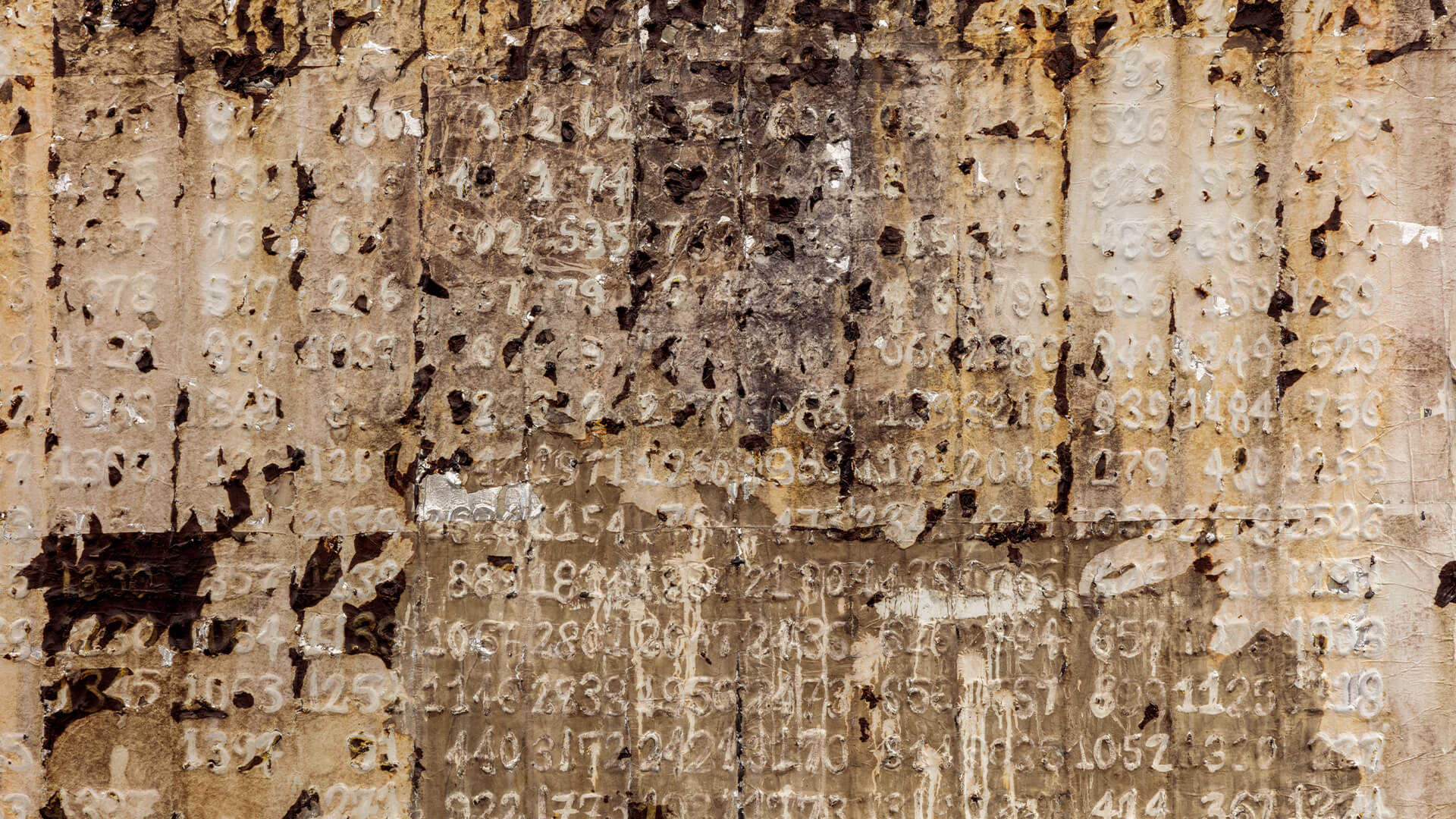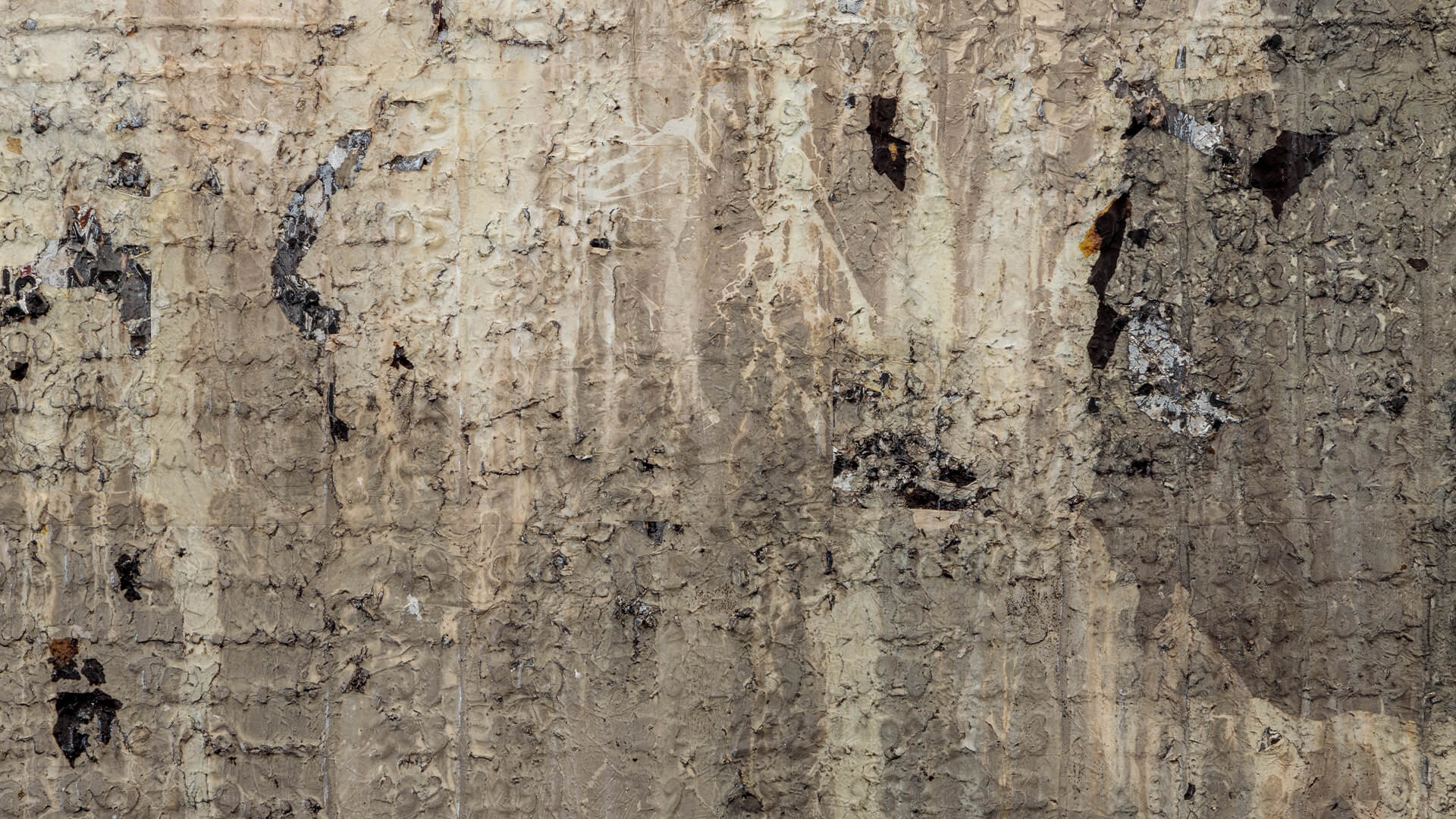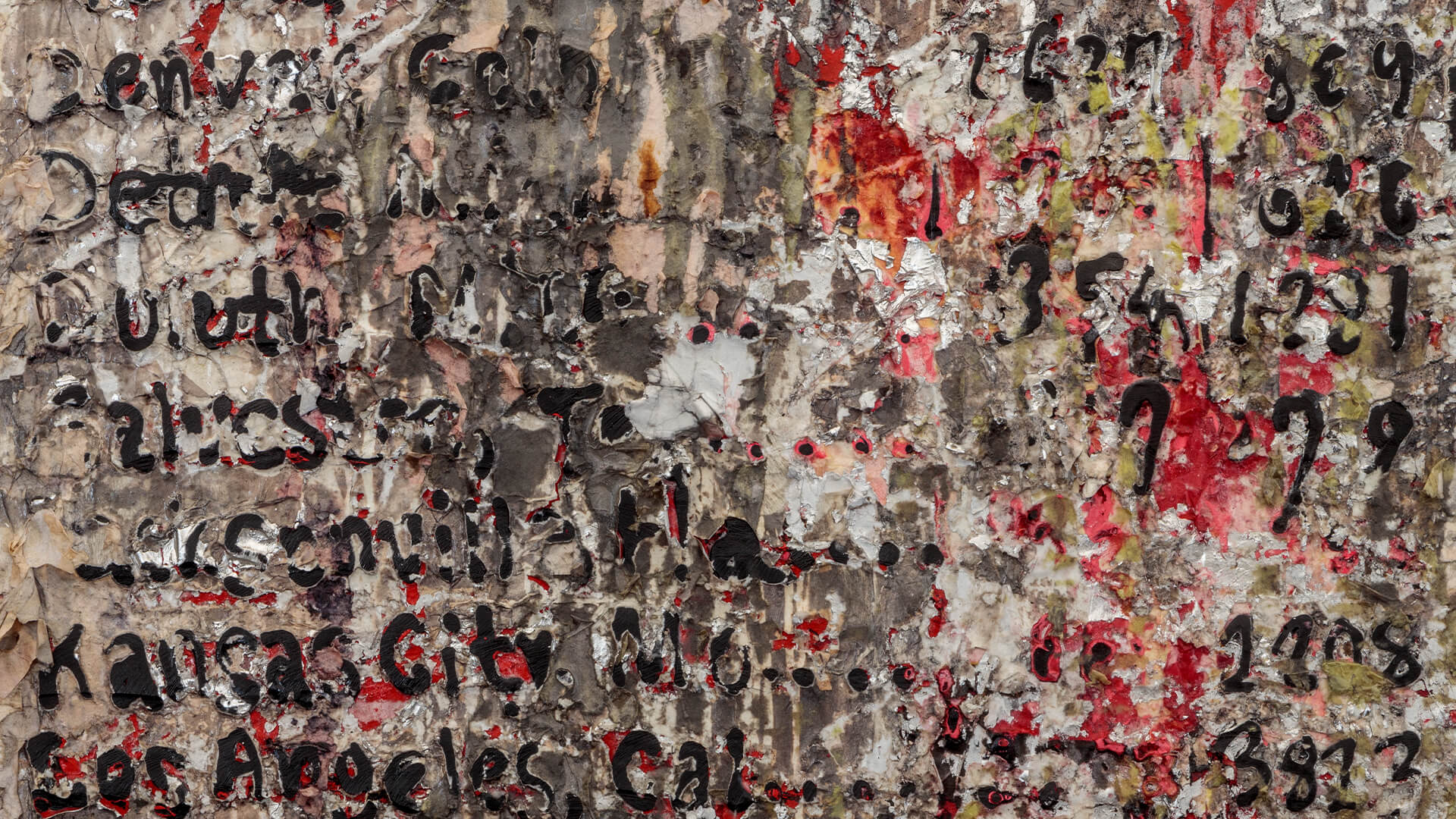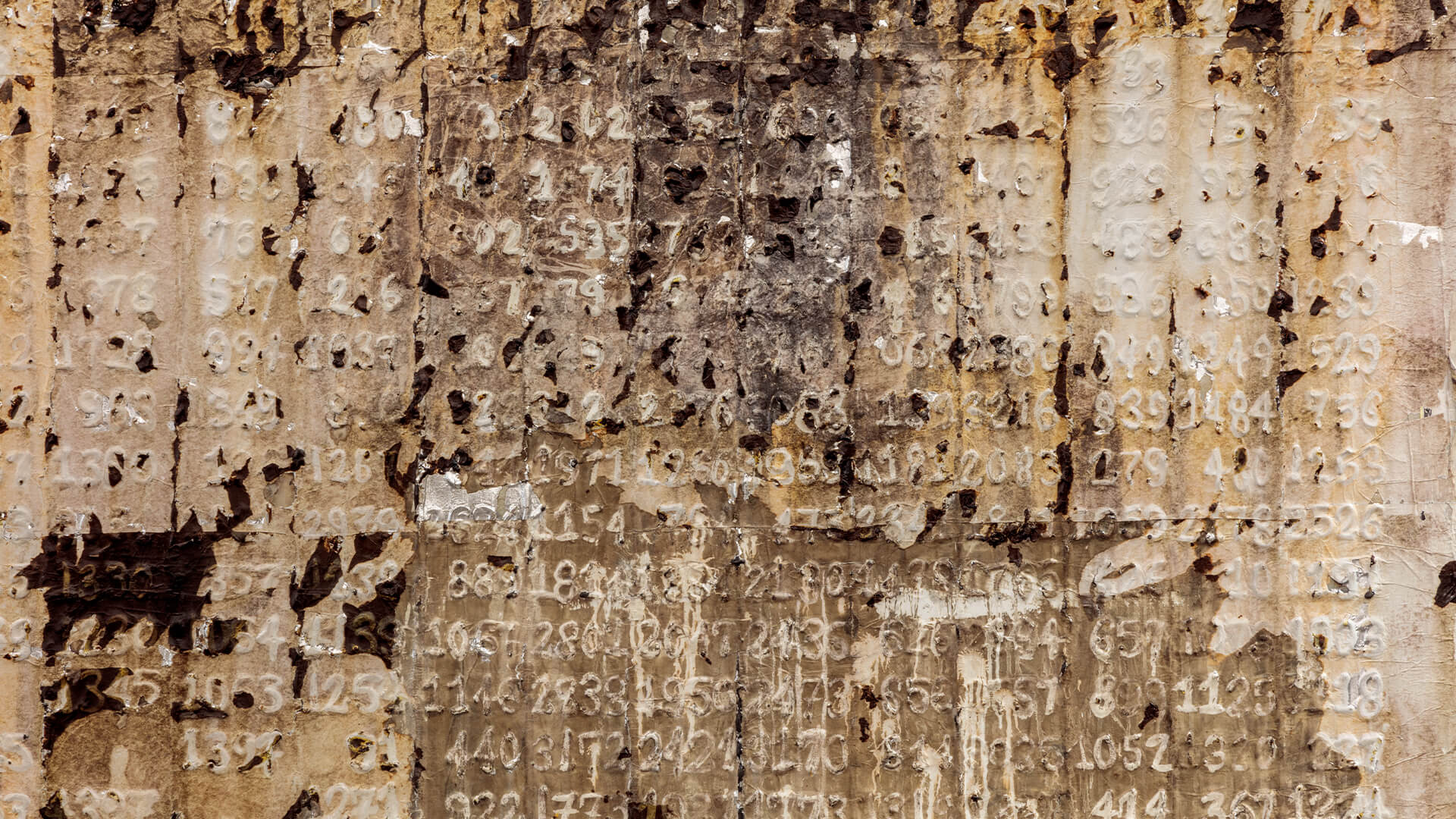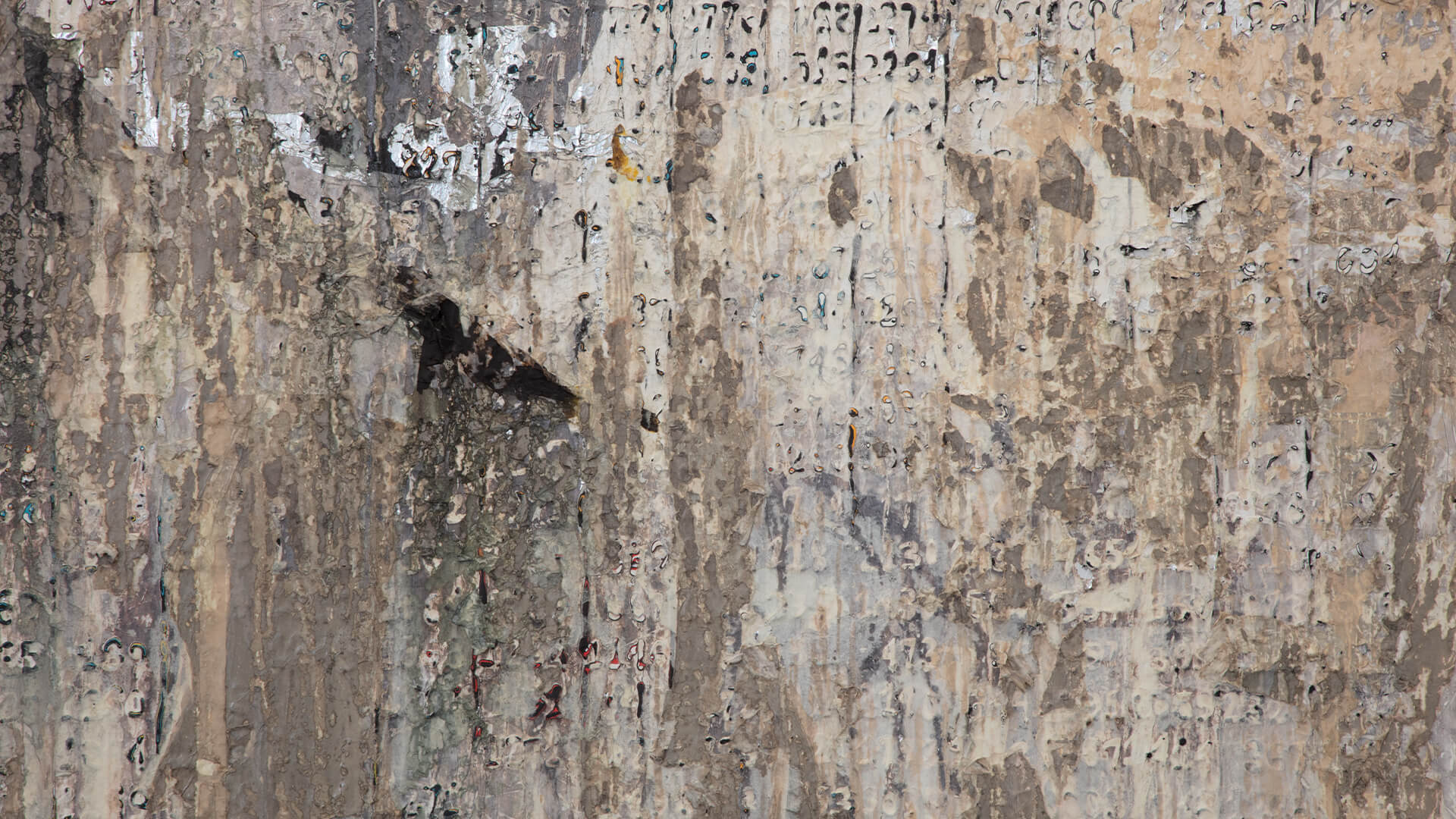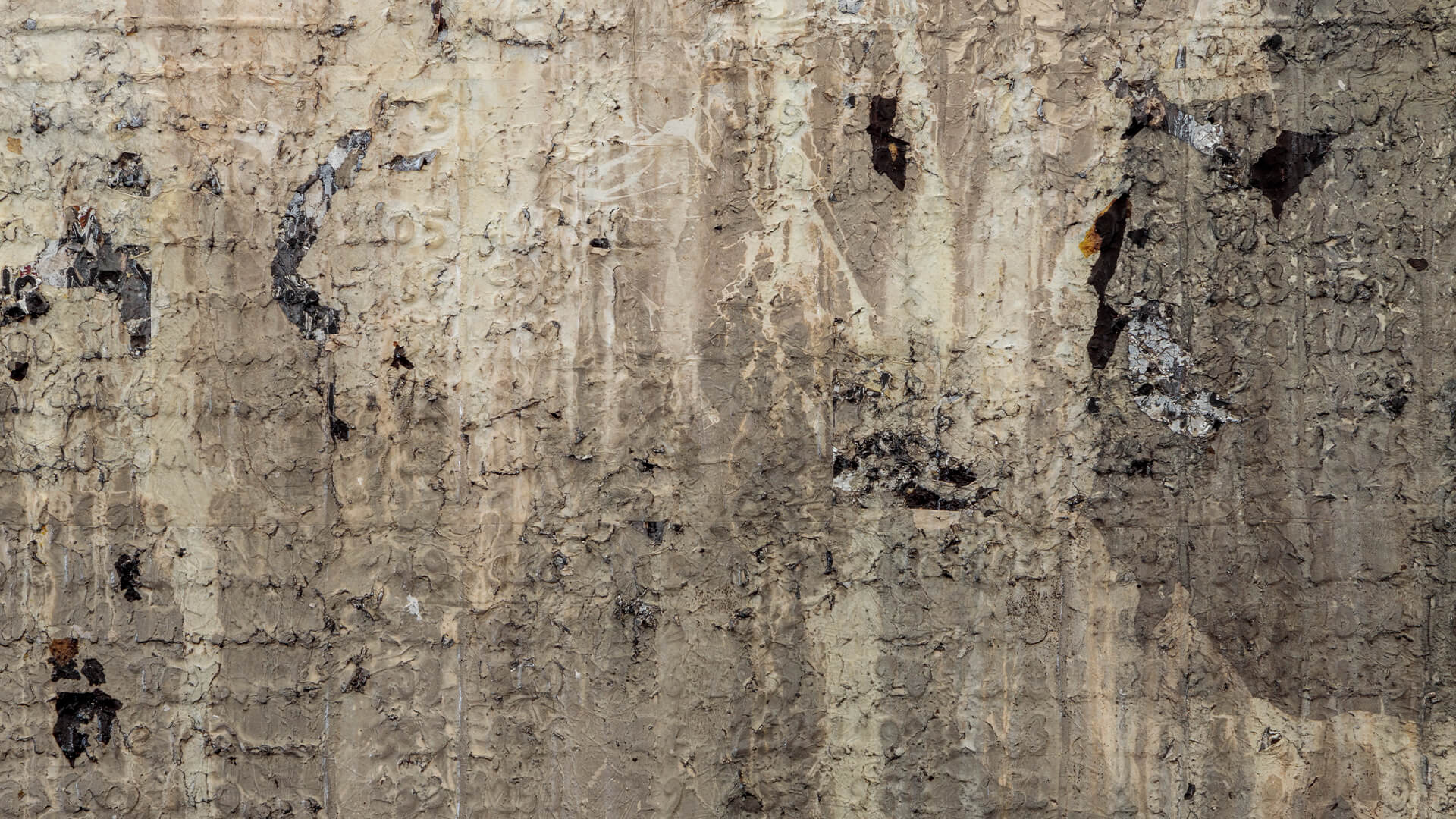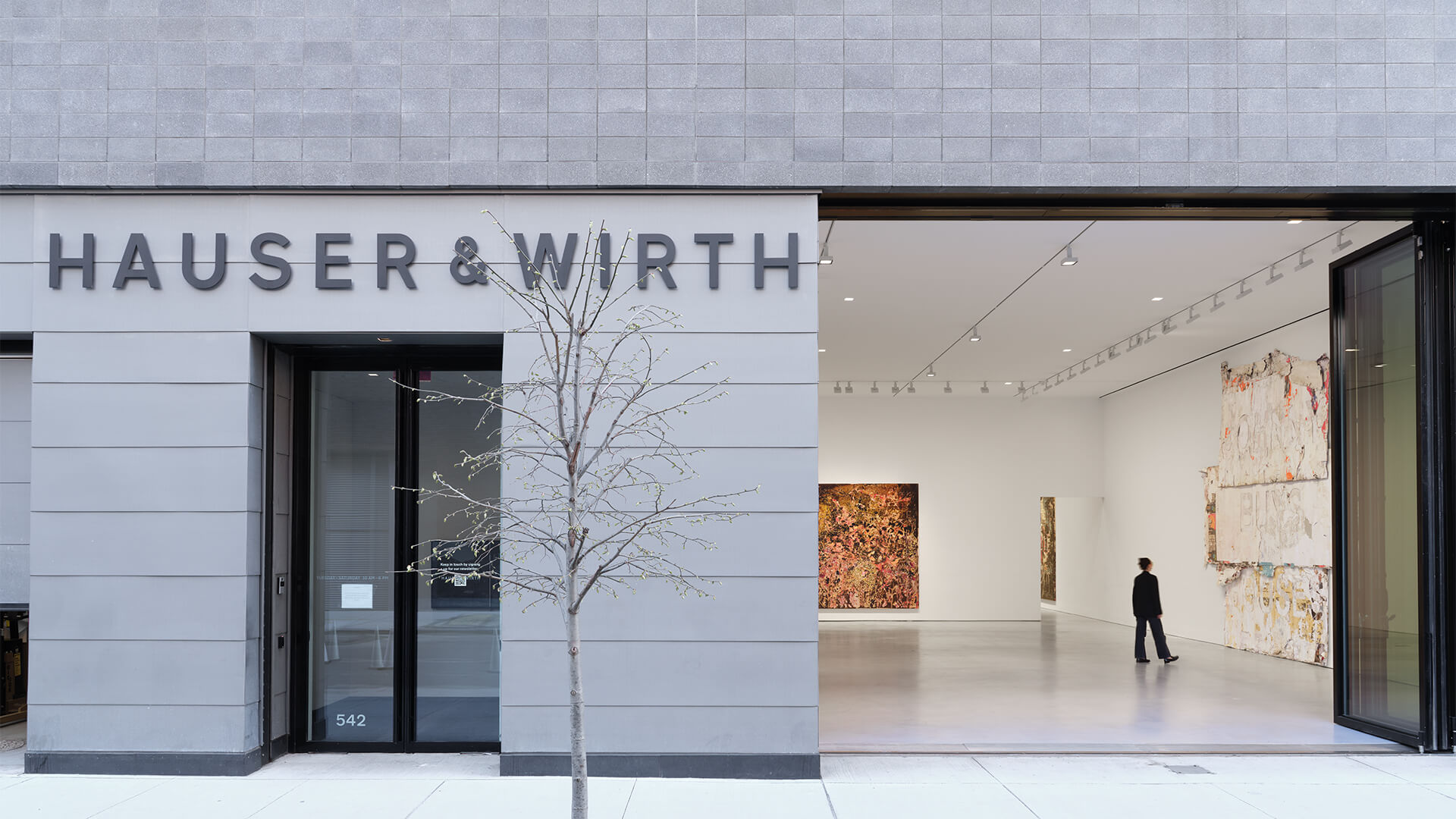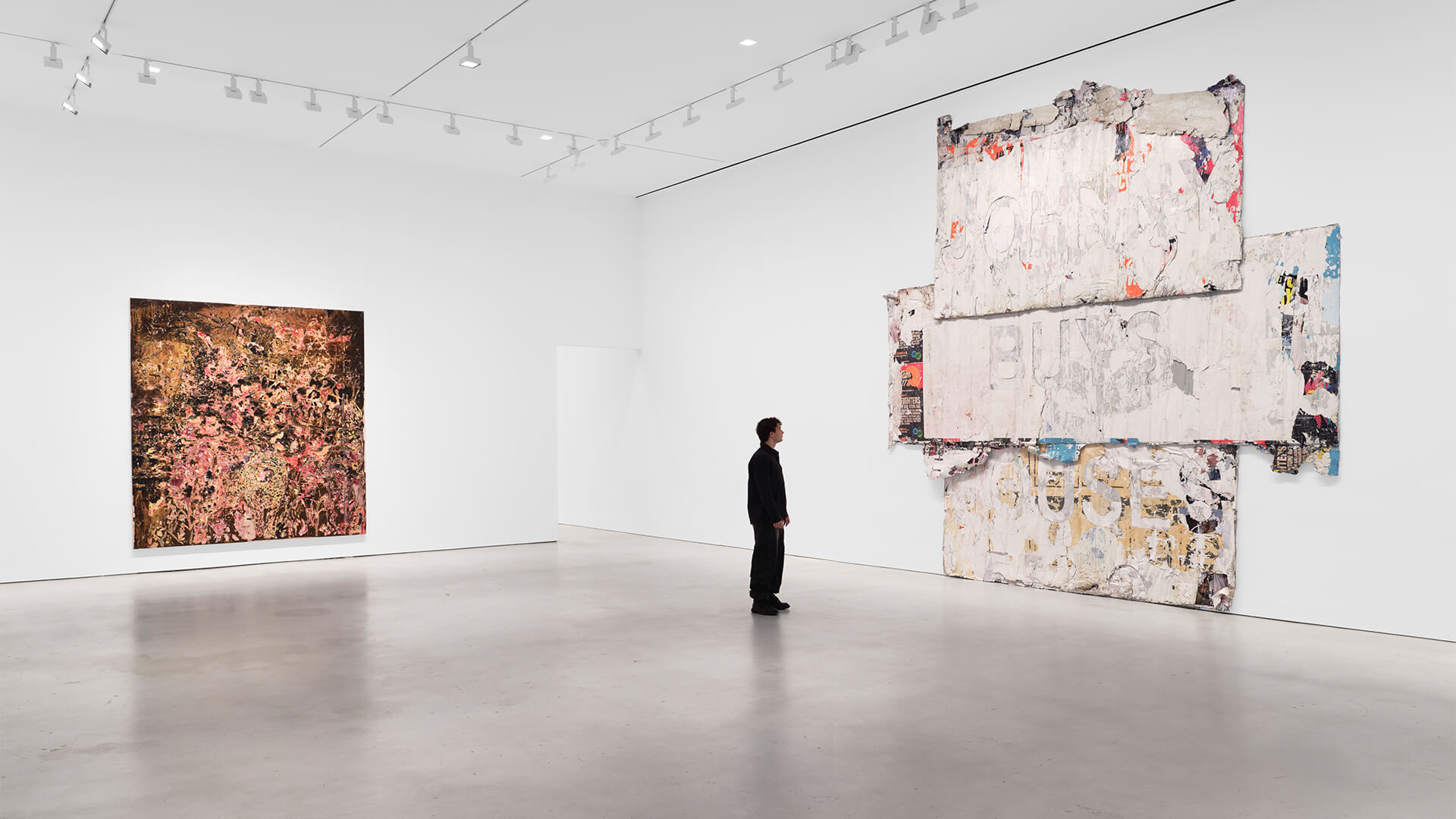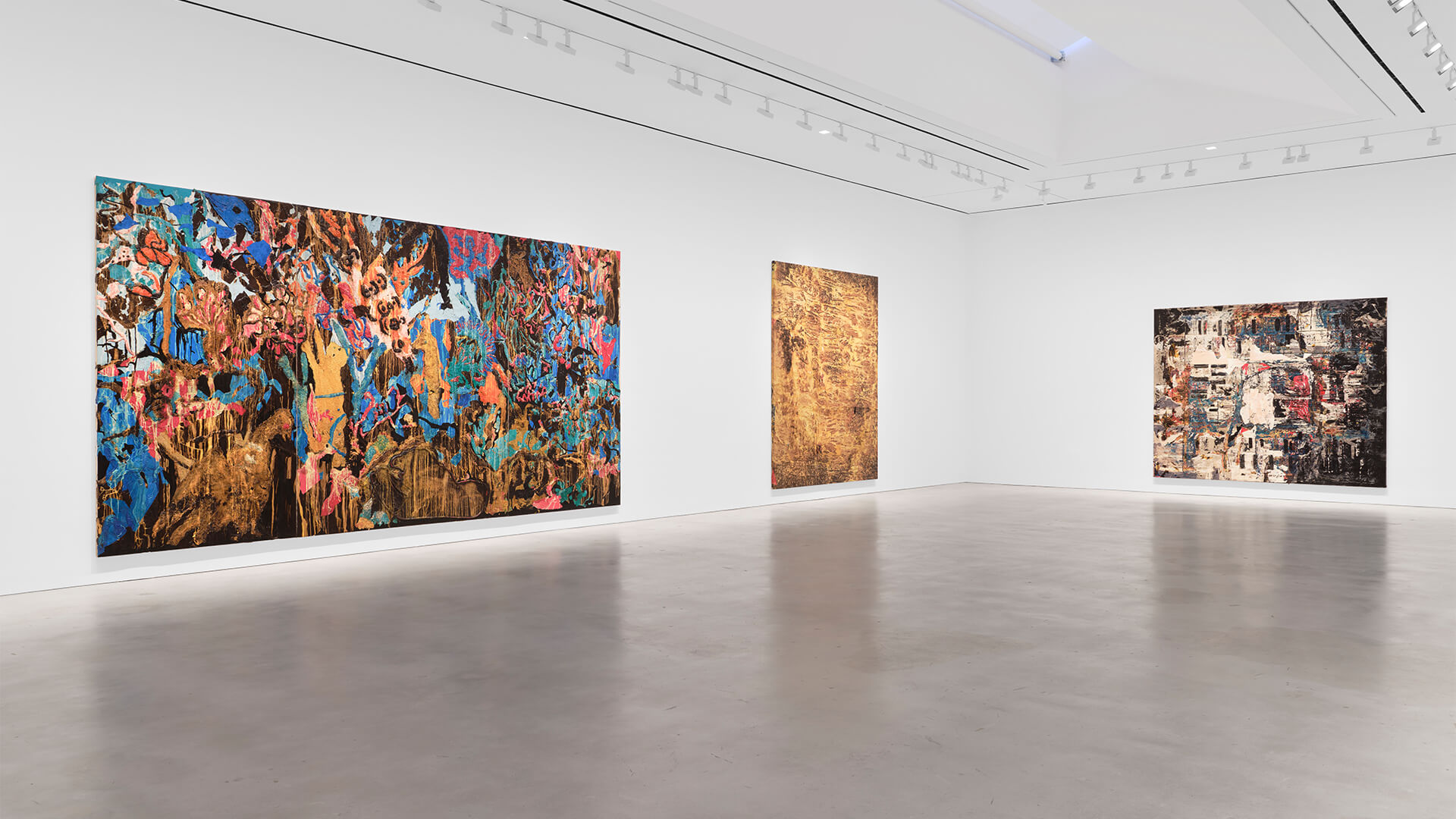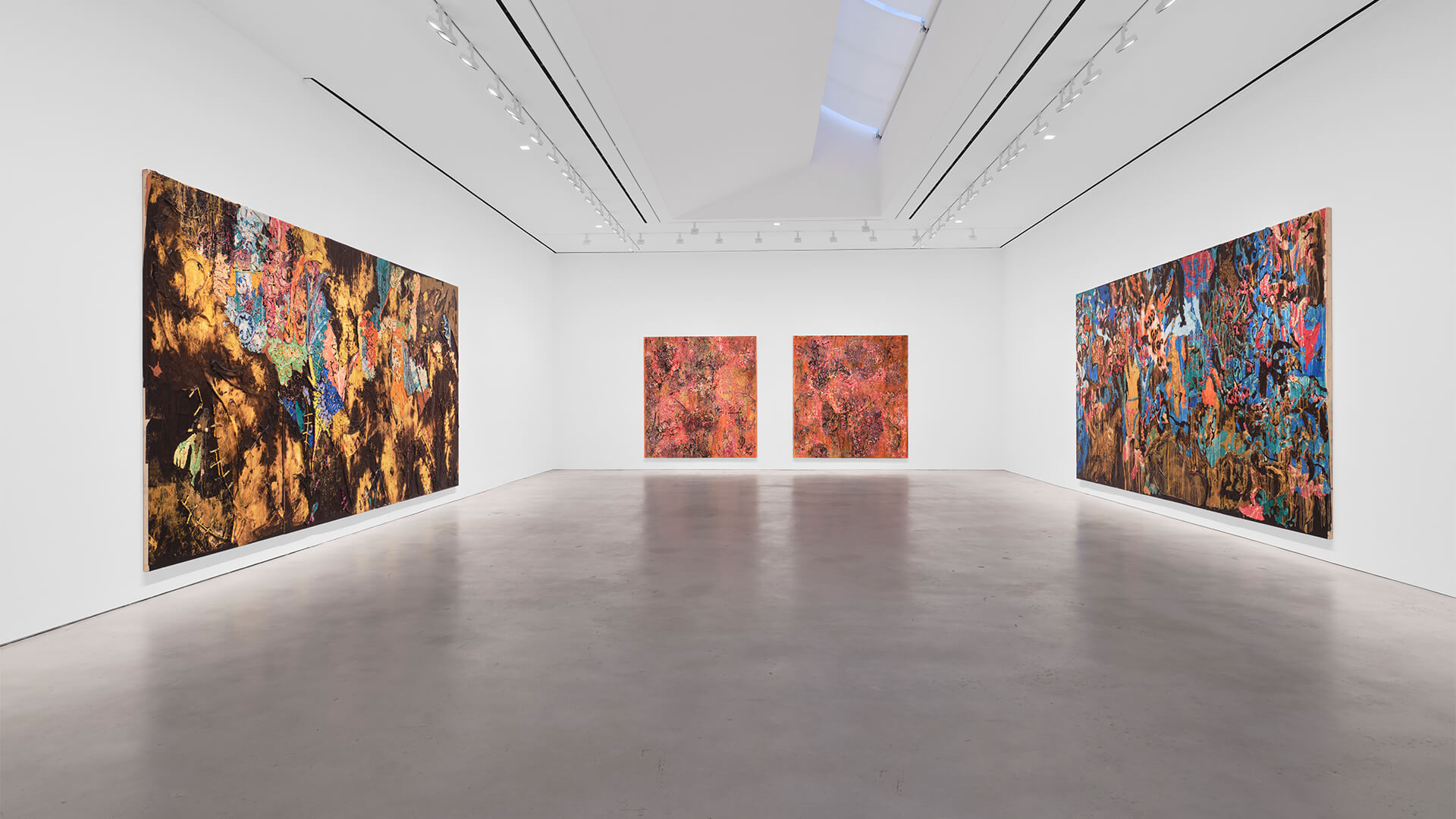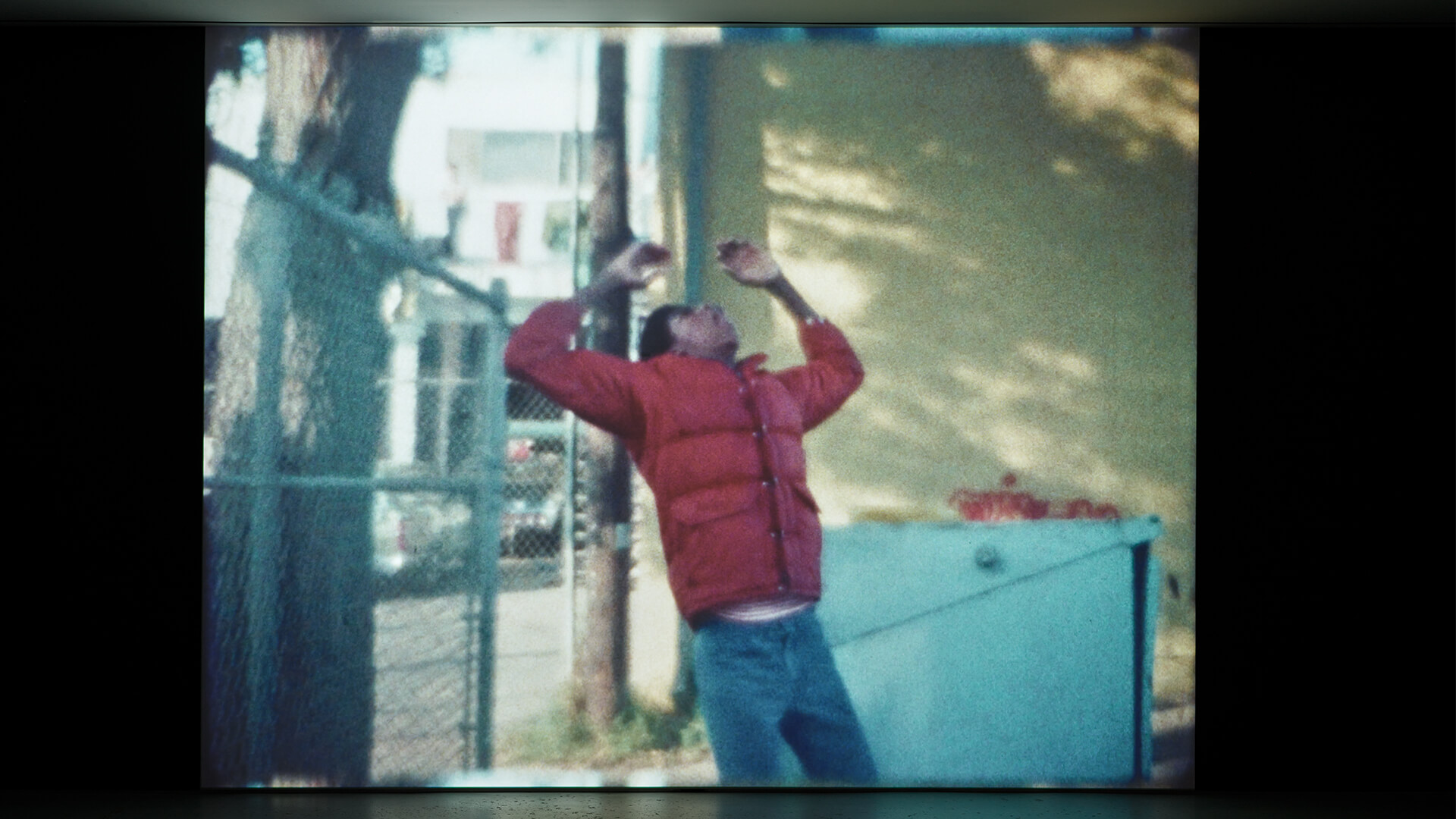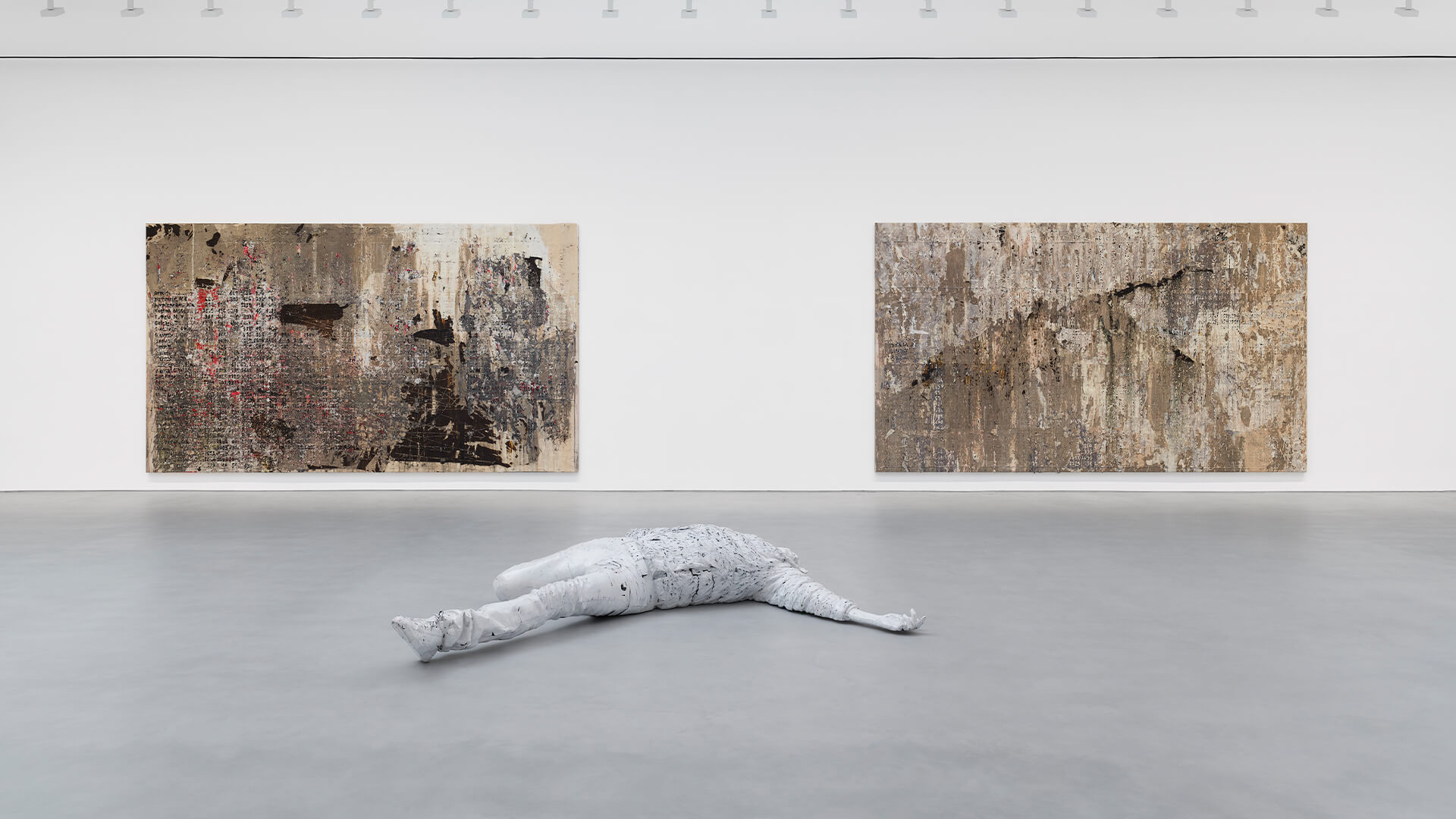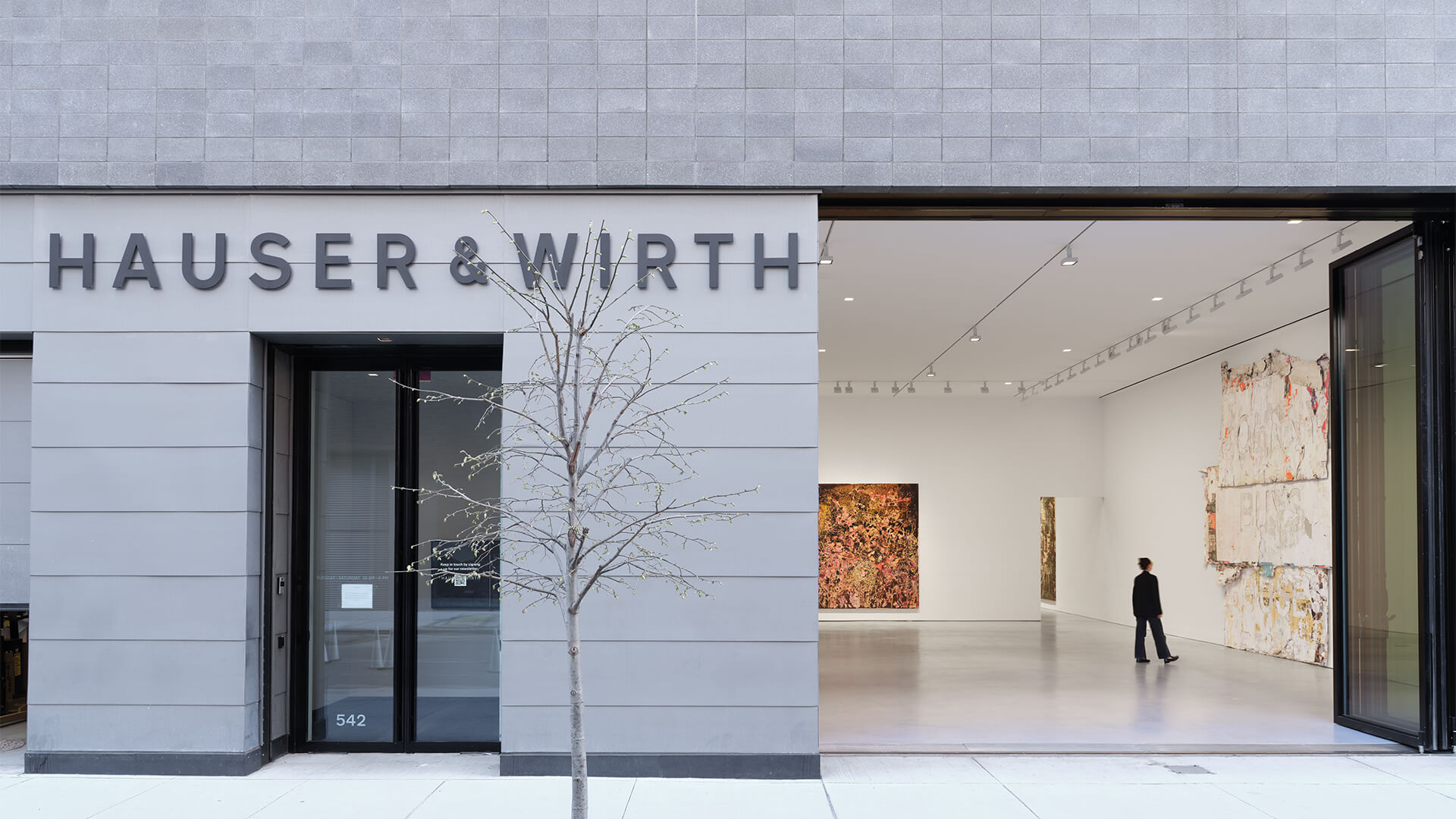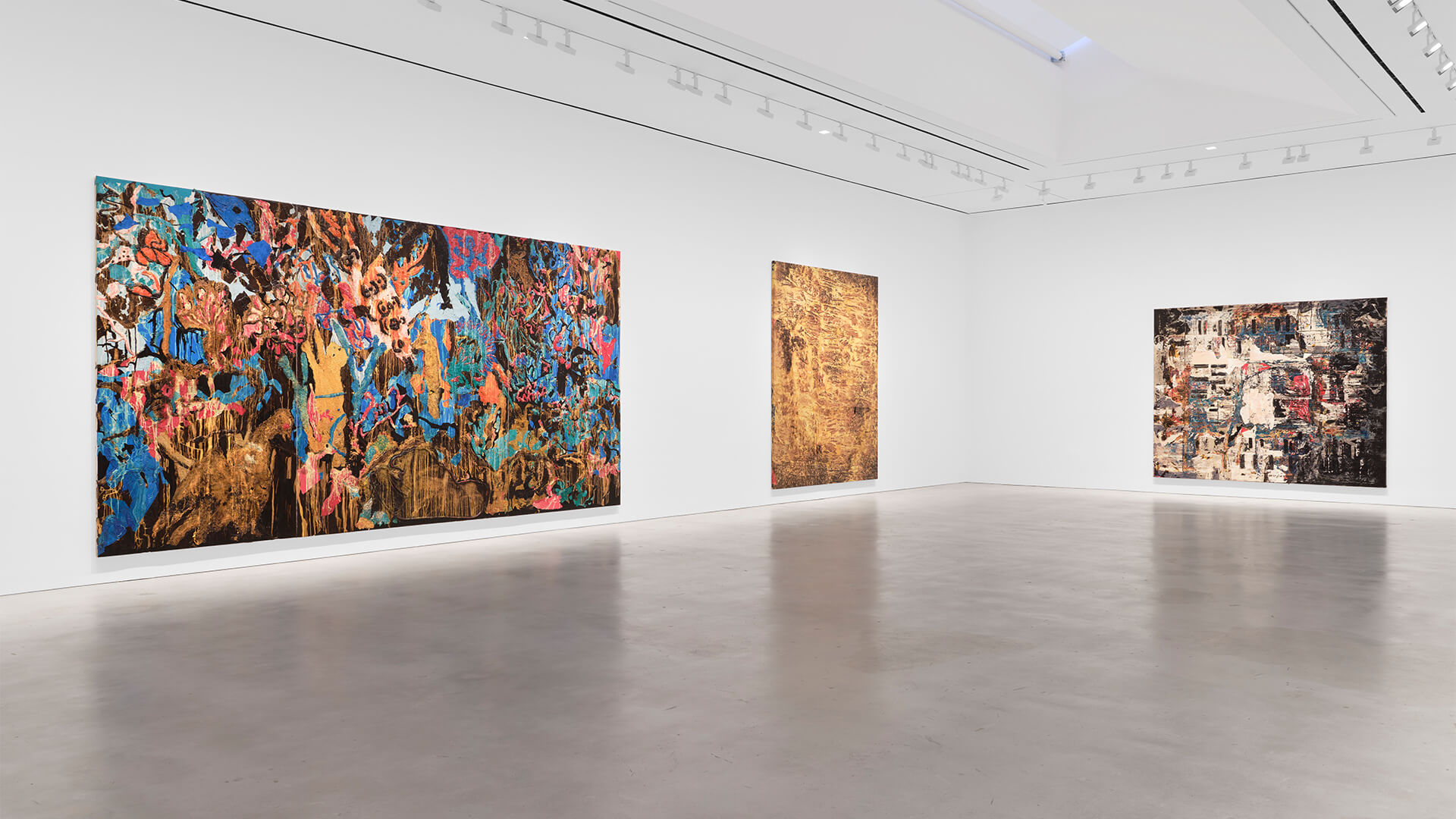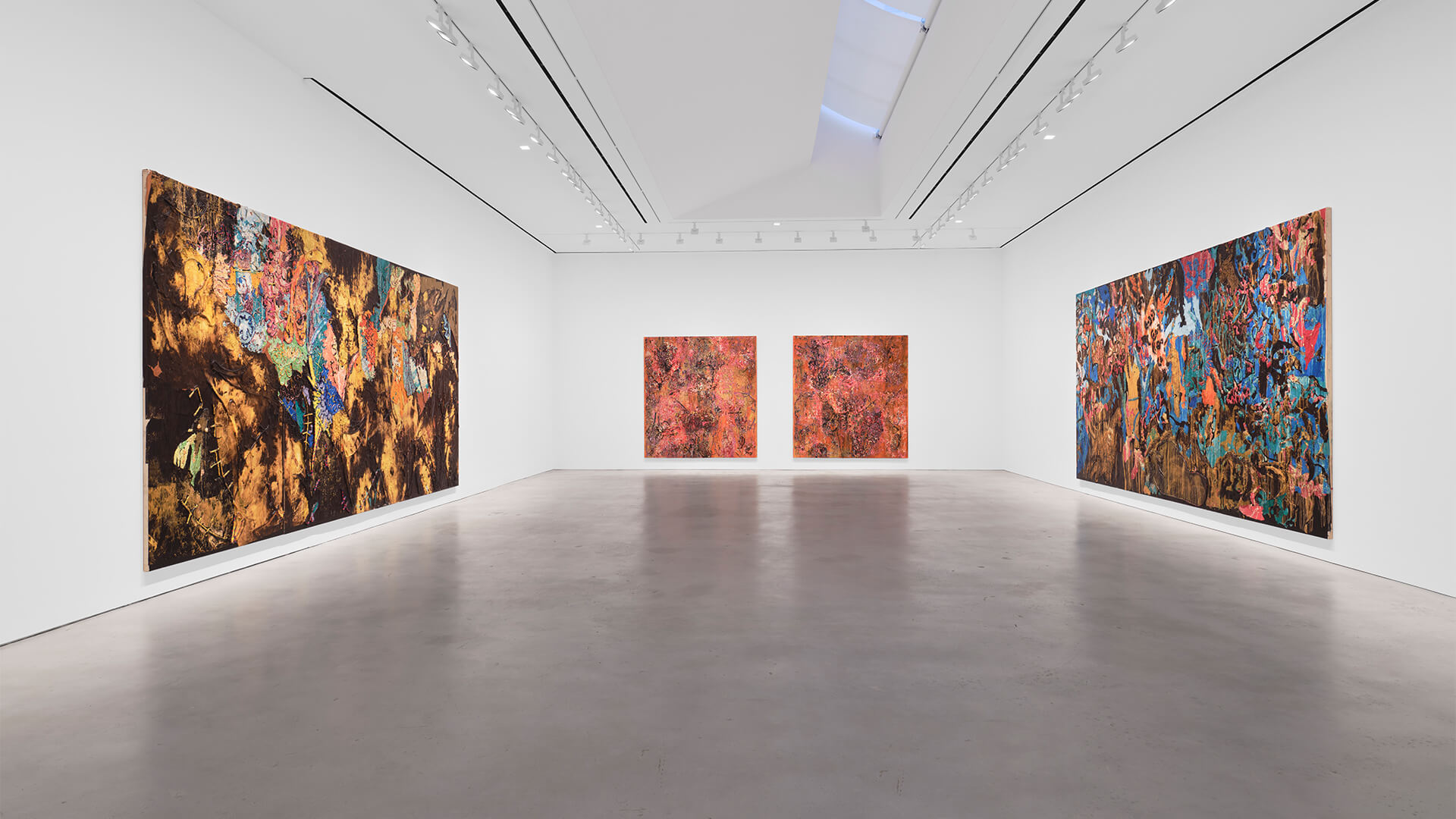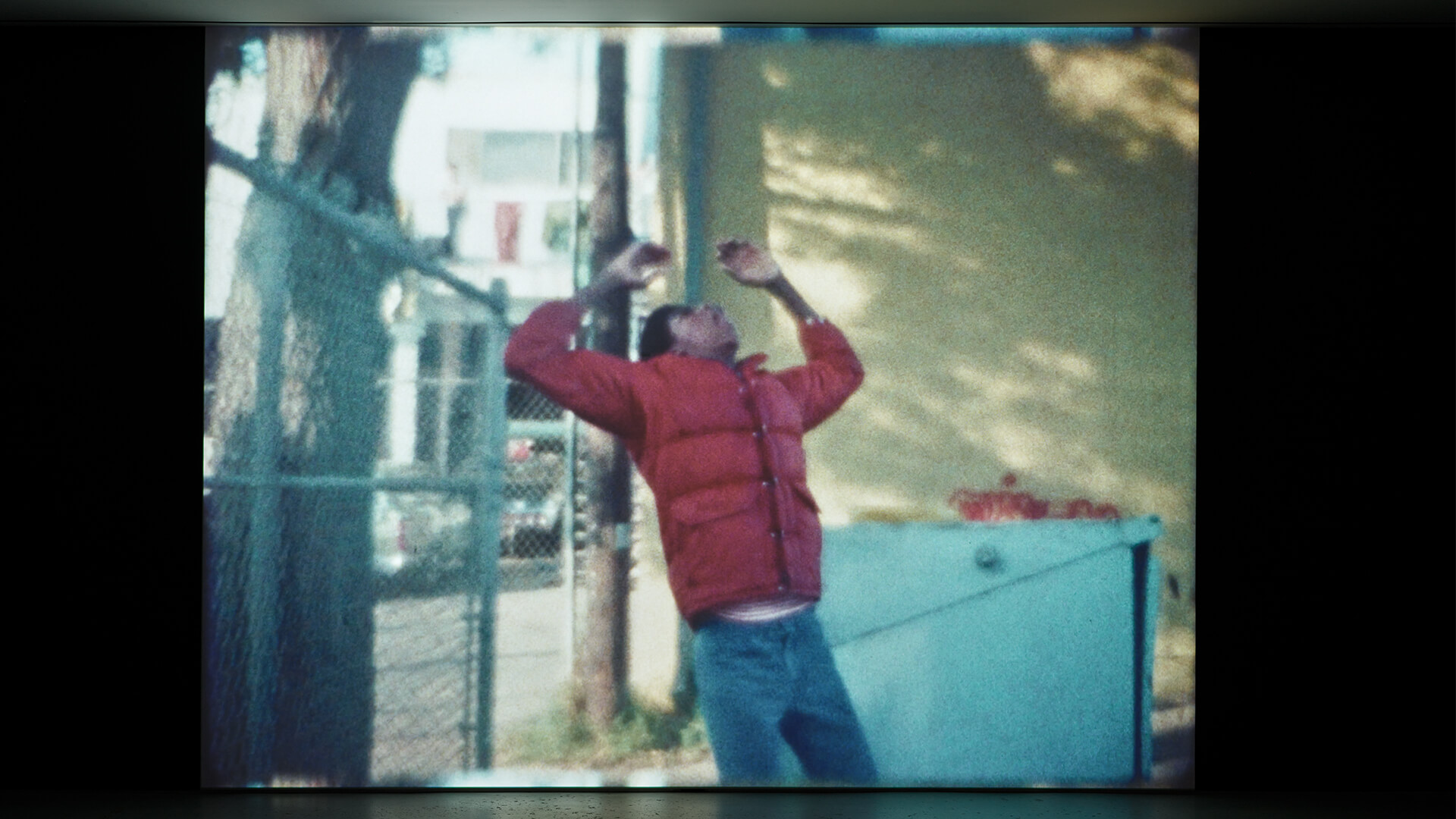Mark Bradford
You don't have to tell me twice
13 April - 28 July 2023
New York, 22nd Street
Hauser & Wirth presents ‘You Don’t Have to Tell Me Twice,’ a major solo exhibition by Mark Bradford filling the entirety of the gallery’s 22nd Street building. The artist’s first show in New York since 2015 features a deeply personal exploration of the multifaceted nature of displacement and the predatory forces that feed on populations driven into motion by crisis. Primarily known for his unique style of ‘social abstraction,’ Bradford turns his attention toward figures, including his own, of flora and fauna—predators and prey—that move within dense, dreamlike abstracted landscapes, masses of material, color and line.
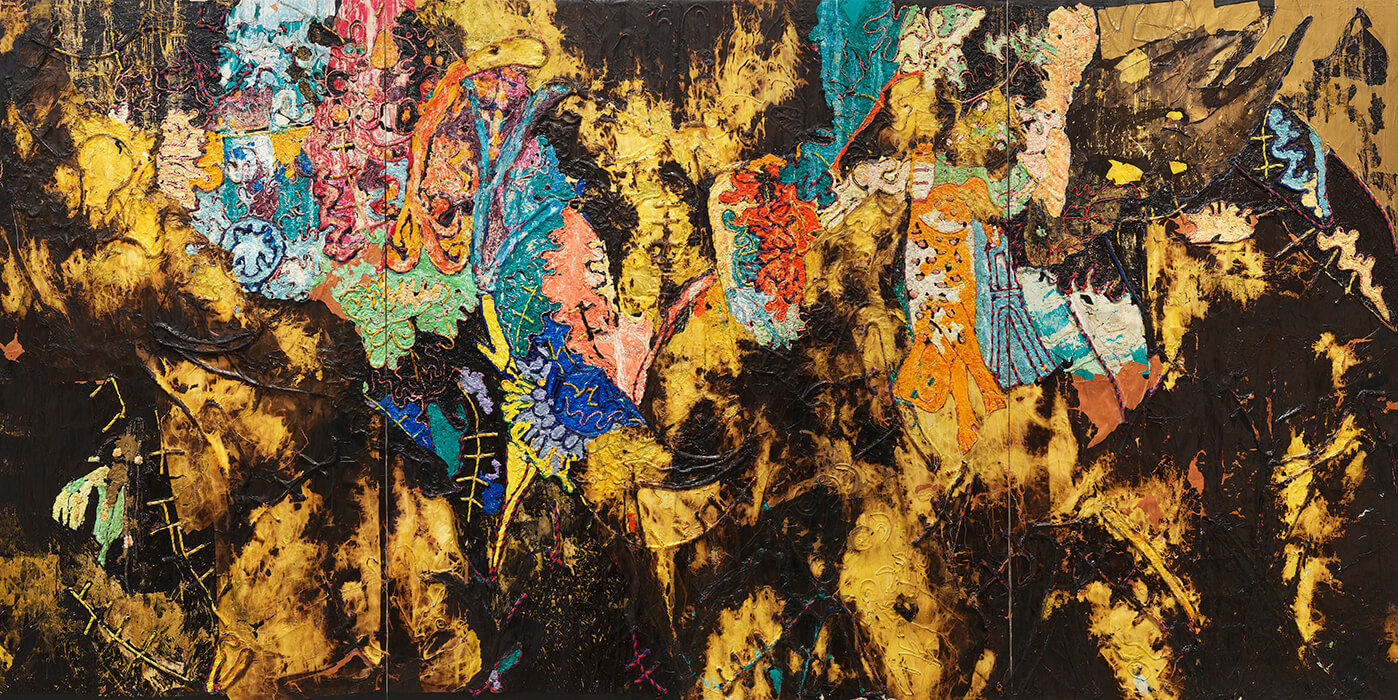
Fire Fire
2021
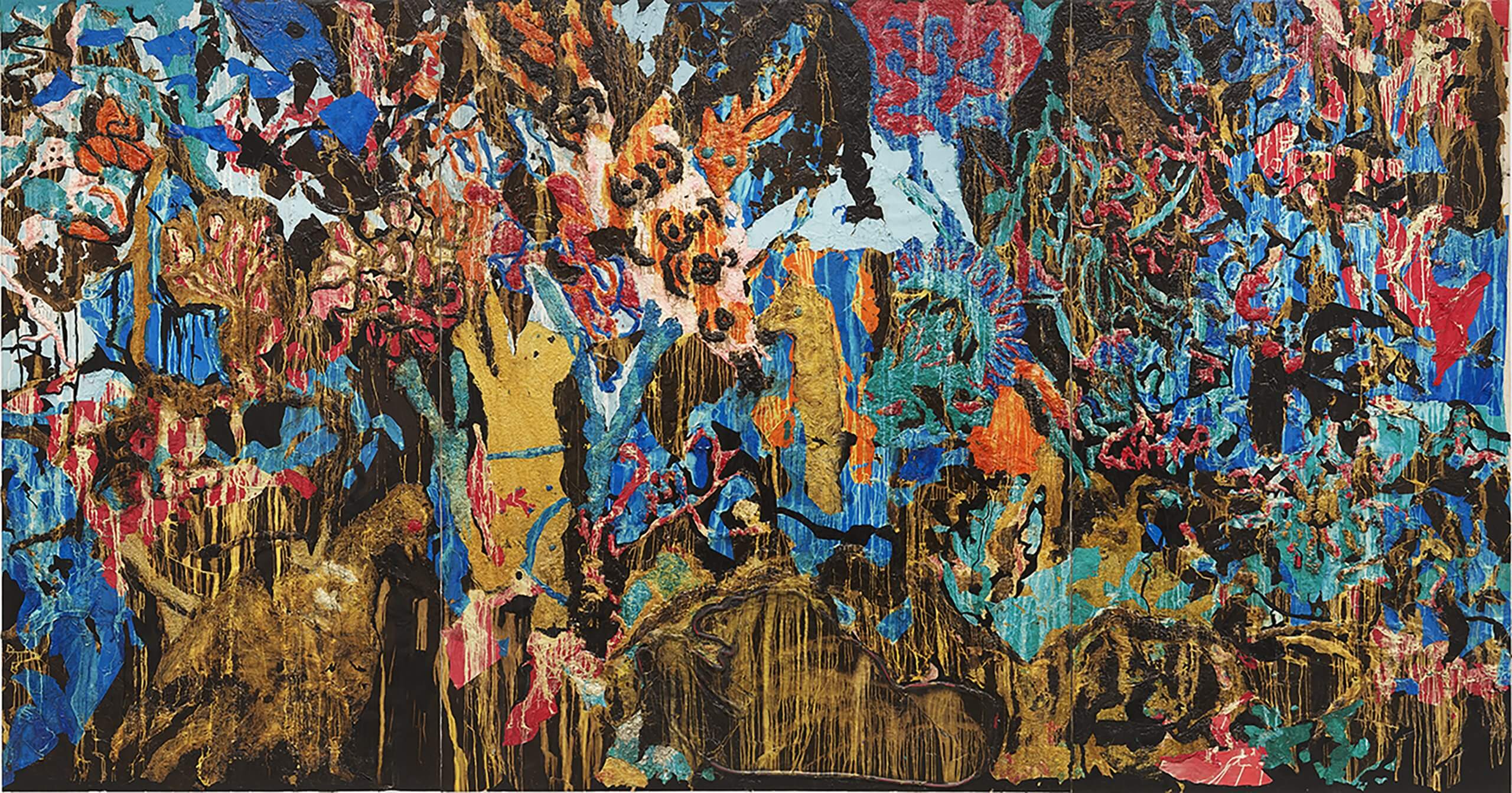
Jungle Jungle
2021
The ground floor features a series of paintings Bradford created starting in 2021 informed by the history of European tapestry and their relationship to power as symbols of the greatest opulence of the aristocracy. Two large canvases, ‘Fire Fire’ and ‘Jungle Jungle’, feature rudimentary figures of plants and animals culled from historic tapestries such as ‘The Hunt for the Unicorn’ or ‘La Dame et la Licorne’, disaggregated and reassembled into bright tableaux of the natural world rendered in bright, artificial colors.
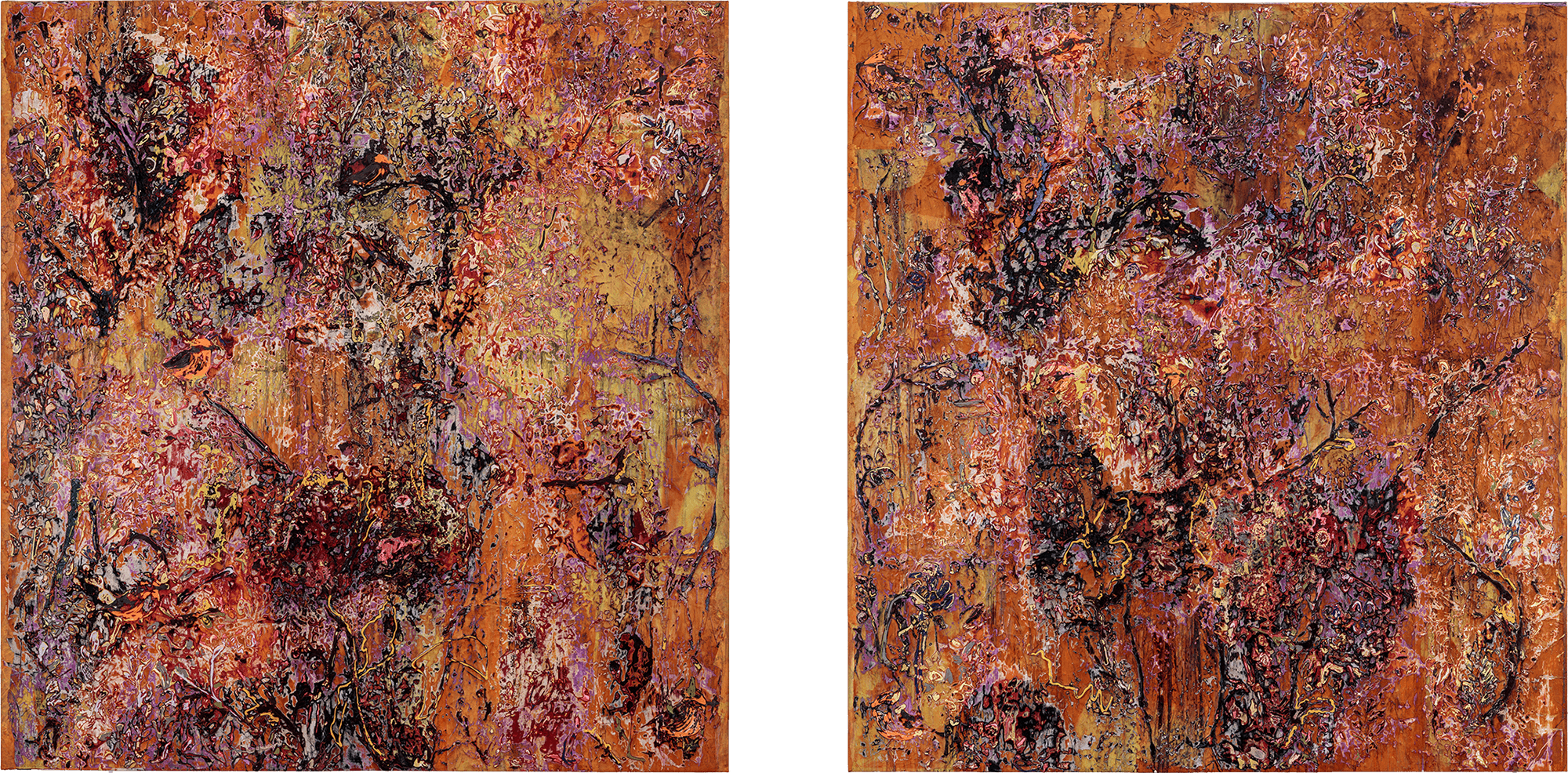
Two-Faced
2023
Bradford’s ‘Johnny the Jaguar’ and ‘Two-Faced’ assemble plant and animal species indigenous to the Chihuahuan desert of the American Southwest into rich, tapestry-like paintings particular to American history. Drawn to the story of Blackdom—an early 20th century African American homesteader settlement established near the Chihuahuan desert—Bradford constructs a dreamlike landscape that imagines a world of predators and prey that populate the migratory landscape of internally displaced Americans. The central antagonist is a roving beast that stands in for several kinds of historical predation and the tendency for systems of exploitation to camouflage and adapt to any moment of social crisis.
‘I packed it up to escape, to save myself, and there he is again, ‘Johnny buys houses.’ Johnny was AIDS. Johnny was the KKK. Johnny was God, the preacher in the pulpit telling me I was sinful.’
—Mark Bradford

Manifest Destiny
2023
Bradford’s merchant poster-inspired ‘Manifest Destiny’ brings the exhibition’s antagonist into sharp relief. Thick panels of billboard paper carved with words found on posters that proliferate around Los Angeles—‘Johnny Buys Houses’—are squeezed, floor-to-ceiling, across from ‘Johnny the Jaguar’, drawing parallels between historically and geographically disparate forms of social and financial predation. Drawing its name from a phrase coined in 1845 to represent the idea that the United States is destined by God to expand and spread democracy and capitalism across the entire North American continent, Bradford’s ‘Manifest Destiny’ draws historical parallels between contemporary economic exploitation and the justification early settlers used to colonize the Americas.
‘Where Lee Goodwin was Jailed & Lynched’ and ‘Haint Blue’ are based on a plot map of Blackdom. Layers of papers and caulk processed using Bradford’s signature techniques of abrasion and oxidation alchemize the gridded structure of the Blackdom homesteader colony’s city plan into rich golds and blacks and, alternately, soft, muted earth tones. Side by side, these two works juxtapose the ‘gold rush’ feel of the hopefulness of some African Americans who left the South during the Great Migration with the measured realty of the challenges they would eventually confront in their new communities, whether self-built Black-only homesteader colonies or more integrational communities like the Greenwood District of Tulsa that was massacred by angry white neighbors in 1921.
‘Death Drop, 1973’ (1973)
‘Death Drop, 1973’ (1973)—a scene taken from a Super 8 film directed by Bradford at age 12—portrays the artist as a young man falling as though struck by a bullet. The slow-motion clip loops in a gallery on the building’s second floor, silently displaying a young man imminently aware of the vulnerability of his own body to violence. This scene, clipped from one of Bradford’s earliest artistic experiments, demonstrates the artist’s precocious sensibility and a keen ability from a young age to use his art to transform his experience of vulnerability into powerful works of art.
Four monumental canvases on the fifth floor—including the show’s titular ‘You Don’t Have to Tell Me Twice’ (2023)—continue Bradford’s ongoing exploration of the Great Migration of African Americans out of the South. Based on a chart showing travel distances between railroad centers in the United States from the 1920s, these paintings feature gridded numbers and city names created with oxidized paper and caulk, forming a veritable parallel landscape of the continental United States. The vibrant palette of Bradford’s tapestry paintings gives way to more muted tones of stained canvas and paper oxidized to soft grays, tans, and whites in a sober evocation of the urgency in uprooting oneself in the face of catastrophe.
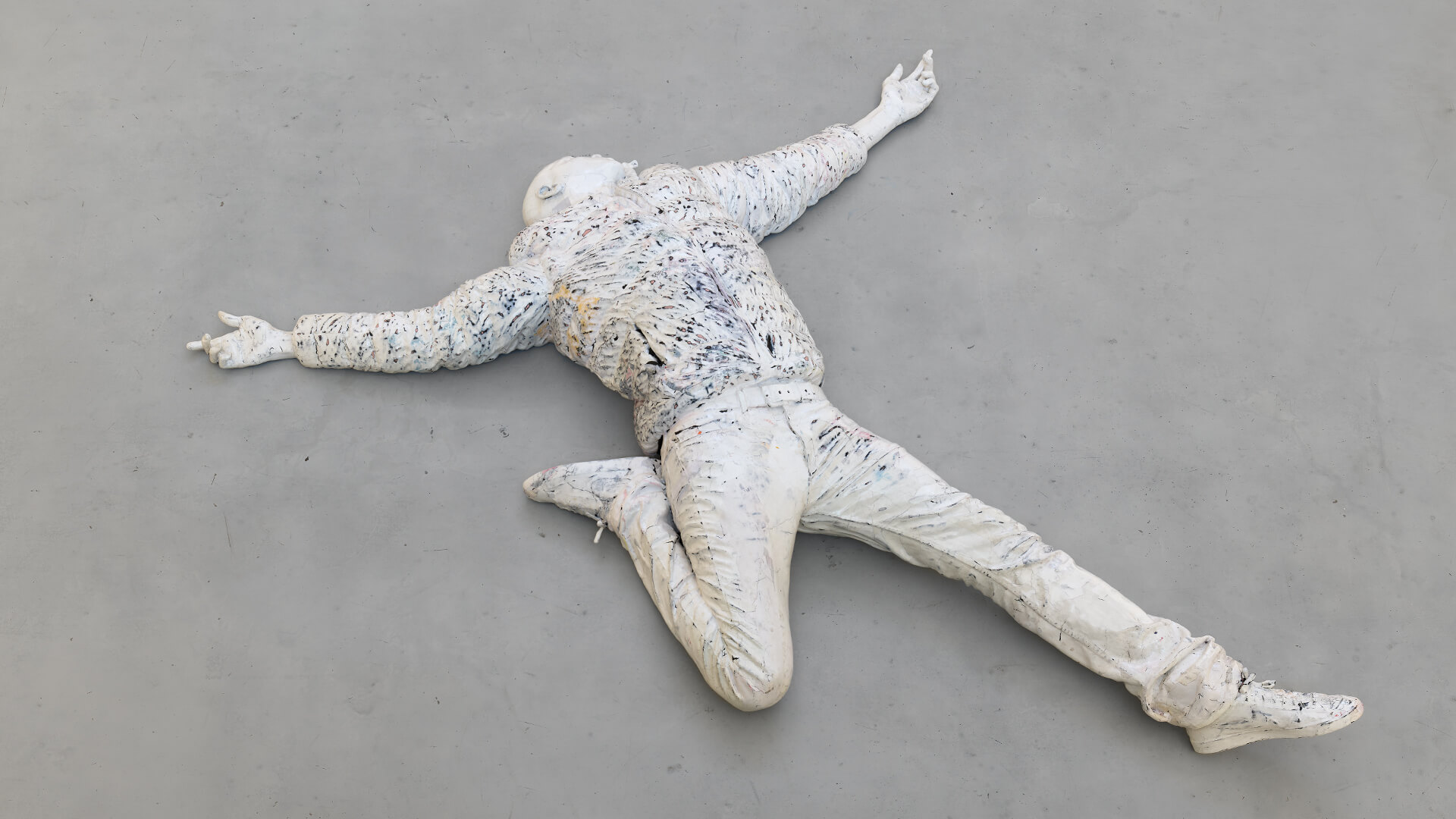
‘Death Drop, 2023’ (2023)
‘Death Drop, 2023’ (2023)—a larger-than-life sculpture of the artist’s body positioned in the iconic ‘death drop’ pose popularized in gay ballroom culture—gestures to the intersection of performance and persecution. Along with ‘Death Drop, 1973’, Bradford creates autobiographical bookends that pull focus from the natural landscape of the paintings to a figure fleeing across them, locating the socio-critical authority and impact of the exhibition within the artist’s lived experience.
‘I believe in resurrection. We have to have some belief that something will resurrect out of all this. And that things will be put together in a different way.’
—Mark Bradford
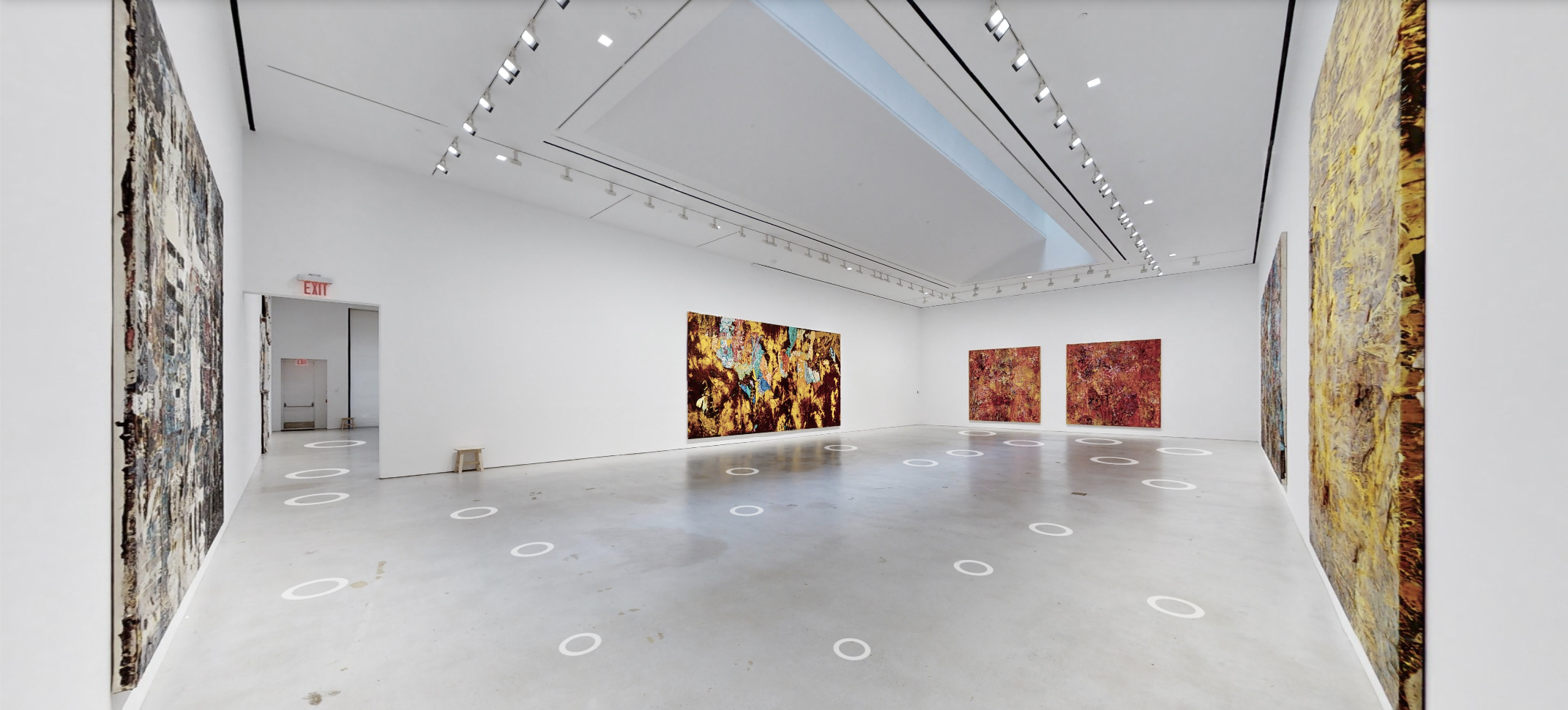
Bradford’s wide-reaching new body of work continues his career-long exploration of systems and institutions that exploit vulnerable populations, while shifting perspective from the aerial bird’s-eye view of the cityscape familiar in his work since the early 2000s, to an interpersonal perspective that puts the audience eye-to-eye with his allegorical world of survival, violence, and desire. With this shift in orientation, the audience becomes implicated in the chase and forces a reckoning with our individual roles in perpetrating and perpetuating violence and oppression on our vulnerable neighbors.
Friends in Conversation: Mark Bradford and Sherrilyn Ifill
To celebrate our opening of ‘Mark Bradford. You Don’t Have to Tell Me Twice,’ the artist’s first show in New York since 2015, we hosted a conversation between artist Mark Bradford and civil rights lawyer Sherrilyn Ifill.

Learning
In partnership with Culture for One, Hauser & Wirth and Mark Bradford have devised a learning program to accompany the exhibition that will engage with a group of young people, ages 18 – 24, from the foster care system. Participants will work directly with Bradford to build a framework for a series of public engagement events.
Additionally, the gallery is partnering with StoryCorps Studios to create a welcoming environment where local residents can come together and record authentic stories centered around belonging, home, displacement and migration as told through conversations between students, neighbors, friends and family.

About Mark Bradford
Mark Bradford (b. 1961 in Los Angeles; lives and works in Los Angeles) is a contemporary artist best known for his large-scale abstract paintings created out of paper. Characterized by its layered formal, material, and conceptual complexity, Bradford’s work explores social and political structures that objectify marginalized communities and the bodies of vulnerable populations. Just as essential to Bradford’s work is a social engagement practice through which he reframes objectifying societal structures by bringing contemporary art and ideas into communities with limited access to museums and cultural institutions.
About the Artist
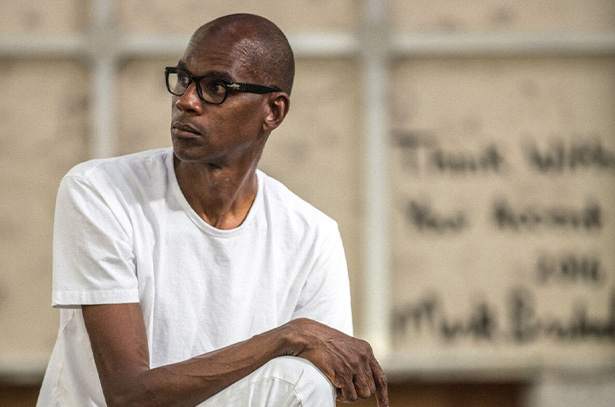
Mark Bradford
Mark Bradford (b. 1961 in Los Angeles; lives and works in Los Angeles) is a contemporary artist best known for his large-scale abstract paintings created out of paper. Characterized by its layered formal, material, and conceptual complexity, Bradford’s work explores social and political structures that objectify marginalized communities and the bodies of vulnerable populations. Just as essential to Bradford’s work is a social engagement practice through which he reframes objectifying societal structures by bringing contemporary art and ideas into communities with limited access to museums and cultural institutions.
Using everyday materials and tools from the aisles of the hardware store, Bradford has created a unique artistic language. Referred to frequently as ‘social abstraction,’ Bradford’s work is rooted in his understanding that all materials and techniques are embedded with meaning that precedes their artistic utility. His signature style developed out of his early experimentation with end papers, the small, translucent tissue papers used in hairdressing; he has since experimented with other types of paper, including maps, billboards, movie posters, comic books, and ‘merchant posters’ that advertise predatory services in economically distressed neighborhoods.
After gluing an image pre-selected for its historical significance onto canvas, Bradford outlines it with rope or caulk before affixing numerous layers of different types of paper. The artist then lacerates, erodes, and excavates the surfaces of his paintings using ‘tools of civilization’ to reveal intersections between the layers of signifying materials, thereby transforming and expanding the medium of painting.
Born in South Los Angeles, Bradford moved to LA’s beachside Santa Monica neighborhood with his mother at age 11. Throughout his childhood he worked in his mother’s beauty salon in Leimert Park where he first developed a curiosity in artistic and creative expression, and after high school, Bradford spent his summers traveling in Europe. His experiences visiting museums and consuming art left an enduring impression, and for the first time, at the age of 31, he began his formal arts education.
Bradford received his BFA from the California Institute of the Arts (CalArts) in Valencia in 1995 and his MFA from CalArts in 1997. Bradford received his first solo exhibition, ‘Floss,’ at the San Francisco Art Institute’s Walter & McBean Galleries in 1998 and his New York museum debut in ‘Freestyle’ at the Studio Museum in Harlem in 2001. In 2006, Bradford participated in the Whitney Biennial at the Whitney Museum of American Art where he won the coveted Bucksbaum Award, leading to his first major solo museum exhibition the following year at the Whitney, ‘Neither New nor Correct.’ In 2008, in the wake of Hurricane Katrina, Bradford participated in Prospect.1 in New Orleans, and in 2010, the Wexner Center for the Arts presented a retrospective of his work that traveled for two years to five institutions around the US.
In 2015, Bradford received his first solo museum exhibition in Los Angeles, ‘Scorched Earth’ at the Hammer Museum, and that same year co-founded Art + Practice in Leimert Park with his longtime partner, Allan DiCastro, and philanthropist and art collector Eileen Harris Norton.
In 2017, Bradford represented the United States at the 57th Venice Biennale with his solo exhibition ‘Tomorrow is Another Day.’ Complementing the presentation at the US Pavilion and in keeping with his practice to engage marginalized communities, Bradford launched Process Collettivo, a six-year partnership with the Rio Terà dei Pensieri social cooperative that provides skills training and employment opportunities to incarcerated men and women in and around Venice. Following the Biennale, ‘Tomorrow is Another Day’ traveled to the Baltimore Museum of Art, where Bradford collaborated with Greenmount West Community Center (GWCC), a community art space offering educational resources to families in Baltimore.
In November 2017, Bradford unveiled ‘Pickett’s Charge’ at the Hirshhorn Museum and Sculpture Garden in Washington, DC, and in 2018, installed a 32-canvas painting of the text of the US Constitution titled ‘We The People’ for permanent display at the US Embassy in London. In 2019, Bradford produced ‘Life Size,’ a large image of a police body camera on a vinyl banner at the entrance to the backlot at the inaugural Frieze LA fair and on wheatpaste posters throughout Los Angeles. Bradford also created a limited-edition print series with the same image to raise money for the Art for Justice Fund to support career development opportunities for people transitioning out of prison.
Bradford has exhibited to acclaim internationally and received numerous awards and honors, including his appointment to the American Academy of Arts and Sciences in 2019, the US Department of State’s Medal of Arts in 2014, his appointment as a National Academician in 2013, and a MacArthur Fellowship Award in 2009. Permanent installations of Bradford’s work include ‘What Hath God Wrought’ (2018) on the campus of the University of California, San Diego, and ‘Bell Tower’ (2015) at the Tom Bradley International Terminal Departures Hall at Los Angeles International Airport.
Recent solo exhibitions of Bradford’s work include ‘Masses and Movements’ at Hauser & Wirth Menorca (2021), ‘End Papers’ (2020) at the Modern Art Museum of Fort Worth; ‘Cerberus’ (2019) at Hauser & Wirth London; and ‘Los Angeles’ (2019) at the Long Museum West Bund, Shanghai.
Inquire about other available works by Mark Bradford
On view now through 28 July 2023 at Hauser & Wirth New York, 22nd Street.
Related Content
Current Exhibitions
1 / 11
